Unconventional language hacking tips from Benny the Irish polyglot; travelling the world to learn languages to fluency and beyond!
Looking for something? Use the search field below.
Home » Articles » 67 Practical Korean Phrases to Ace Your First Korean Conversation

Full disclosure: This post contains affiliate links. ?
written by Caitlin Sacasas
Language: Korean
Reading time: 10 minutes
Published: Apr 5, 2024
Updated: Jun 6, 2024

67 Practical Korean Phrases to Ace Your First Korean Conversation
Are you looking for the perfect list of practical Korean phrases to help you have your first conversation? Wondering what “aniyo” is in Korean? What’s “thank you” or “hello” in Korean? Look no further – we have the perfect lists of the most commonly used Korean phrases!
No fluff here! All the Korean words and phrases listed below are helpful phrases you’ll actually use when speaking Korean.
Table of contents
15 basic korean words and phrases, 10 korean greetings to say “hello” and “goodbye” in korean, 13 common korean phrases for everyday life, 19 survival korean phrases for getting around in korea, 12 basic korean phrases for real conversations with new korean friends, learn the core 111 korean words, create a korean script so you’re ready to start speaking korean today, start speaking korean from day one, master your korean pronunciation, learn how to read korean hangul, ace your first conversation with these korean phrases.
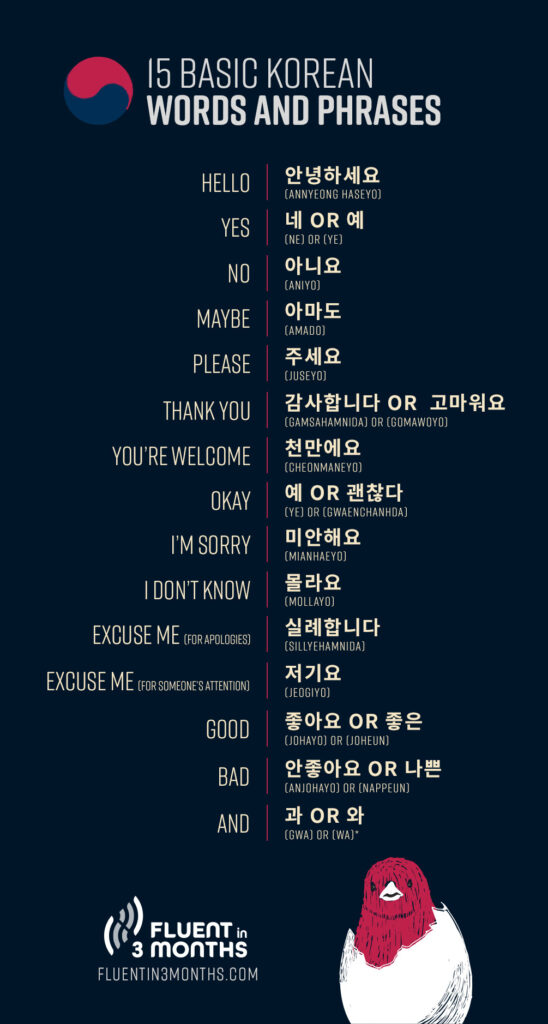
You’ll probably use some of the most basic Korean phrases for any conversation. Here are some words and phrases to get you ready for your first–and any–conversation:
- Hello: 안녕하세요 ( annyeong haseyo )
- Yes: 네 ( ne ) or 예 ( ye )
- No: 아니요 ( aniyo )
- Maybe: 아마도 ( amado )
- Please: 주세요 ( juseyo )
- Thank you: 감사합니다 ( gamsahamnida ) or 고마워요 ( gomawoyo )
- You’re welcome: 천만에요 ( cheonmaneyo )
- Okay: 예 ( ye ) or 괜찮다 ( gwaenchanhda )
- I’m sorry: 미안해요 ( mianhaeyo )
- I don’t know: 몰라요 ( mollayo )
- Excuse me (for apologies): 실례합니다 ( sillyehamnida )
- Excuse me (for someone’s attention): 저기요 ( jeogiyo )
- Good: 좋아요 ( johayo ) or 좋은 ( joheun )
- Bad: 안좋아요 ( anjohayo ) or 나쁜 ( nappeun )
- And: 하고 ( hago )* See note below
Pro tip about “and” in Korean: There are many ways to say “and”. The one above is the most colloquial, but you might also come across 과 ( gwa ) or 와 ( wa ). These two are also standard, but just a bit more bookish or formal. The two listed here are particles and change depending on the last sound of the word that comes before it.
You use 과 ( gwa ) if the word before it ends in a consonant. You use 와 ( wa ) if the word ends in a vowel. Luckily, with the colloquial 하고 ( hago ), you don’t need to worry about this.
This is common with many Korean particles.
By the way, you can hear Benny using some of these practical Korean words and phrases from day one! Check out his very first Korean conversation here:
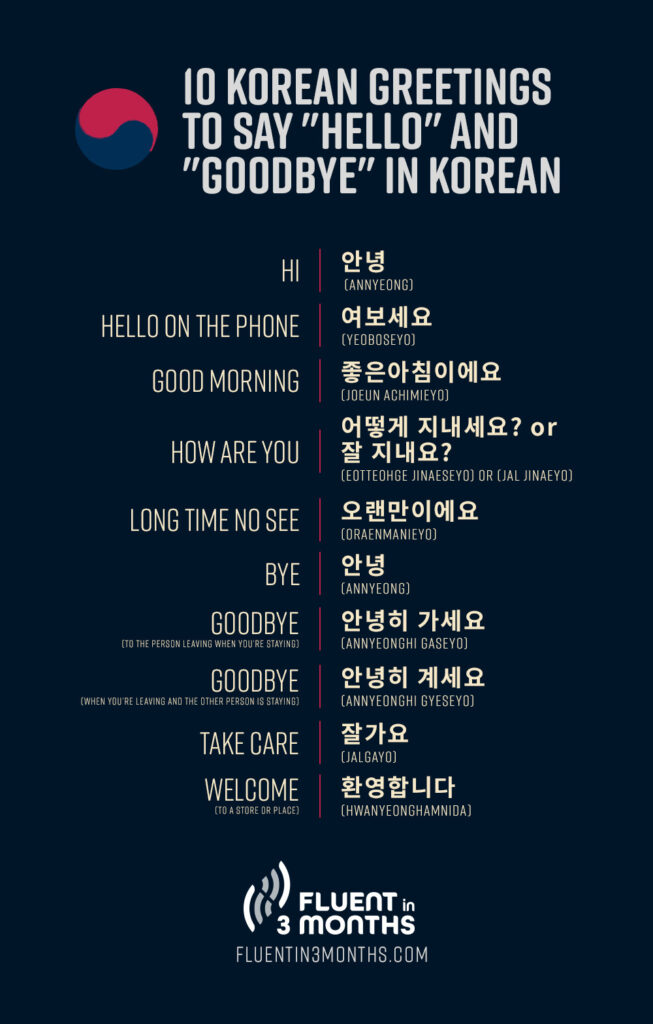
As in other languages, some of the most common Korean phrases are greetings! You’ll need them to sound polite and friendly, so here are some of the most common greetings in Korean.
You’ll notice that there are a few ways to say “goodbye”. That’s because depending on how you’re leaving, it changes slightly! Don’t worry – I tell you how to choose which one to use.
(But if you ever forget, you can say annyeong . It’s more casual, but it will get the job done!)
- Hi: 안녕 ( annyeong )
- Hello on the phone: 여보세요 ( yeoboseyo )
- Good morning: 좋은아침이에요 ( joeun achimieyo )
- How are you: 어떻게 지내세요? ( eotteohge jinaeseyo ) or 잘 지내요? ( jal jinaeyo )
- Long time no see: 오랜만이에요 ( oraenmanieyo )
- Bye: 안녕 ( annyeong )
- Goodbye (to the person leaving when you’re staying): 안녕히 가세요 ( annyeonghi gaseyo )
- Goodbye (when you’re leaving and the other person is staying): 안녕히 계세요 ( annyeonghi gyeseyo )
- Take care: 잘 가요 ( jal gayo )
- Welcome (to a store or place): 환영합니다 ( hwanyeonghamnida )
Want to learn more ways to start a conversation in Korean? Check out this article about Korean greetings .
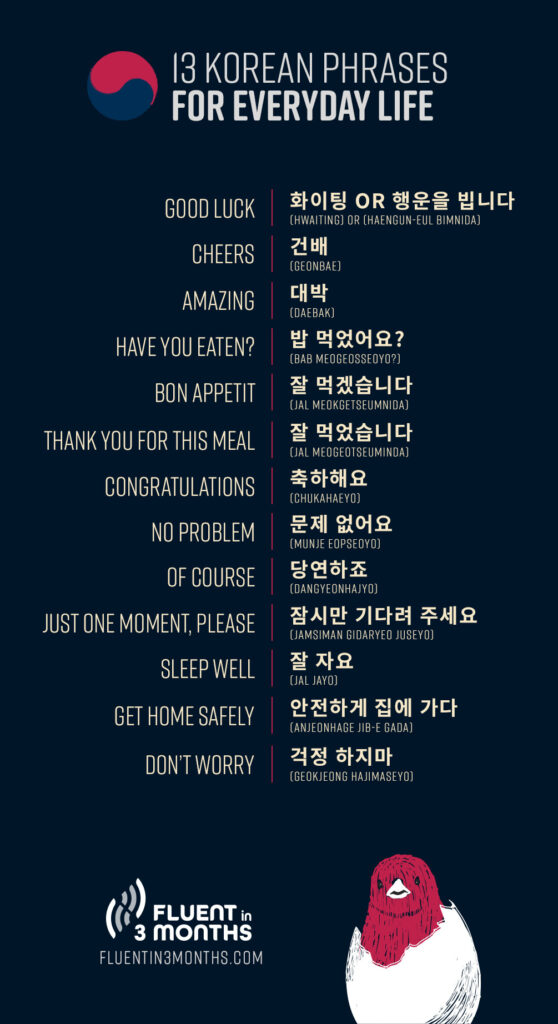
There are some common Korean phrases you’ll need to talk with people in different situations. You’ll run into these common Korean phrases all the time. Some even every time you eat!
- Good luck: 화이팅 ( hwaiting , literally: “fighting”) or 행운을 빕니다 ( haengun-eul bimnida )
- Cheers: 건배 ( geonbae )
- Amazing: 대박 ( daebak )
- Have you eaten?: 밥 먹었어요? ( bab meogeosseoyo? )
- Bon appetit: 잘 먹겠습니다 ( jal meokgetseumnida )
- Thank you for this meal: 잘 먹었습니다 ( jal meogeotseuminda )
- Congratulations: 축하해요 ( chukahaeyo )
- No problem: 문제 없어요 ( munje eopseoyo )
- Of course: 당연하죠 ( dangyeonhajyo )
- Just one moment, please: 잠시만 기다려 주세요 ( jamsiman gidaryeo juseyo )
- Sleep well: 잘 자요 ( jal jayo )
- Get home safely: 안전하게 집에 가다 ( anjeonhage jib-e gada )
- Don’t worry: 걱정 하지마 ( geokjeong hajimaseyo )
We wrote even more Korean phrases for beginners and those preparing to travel to Korea, so check that out, too!
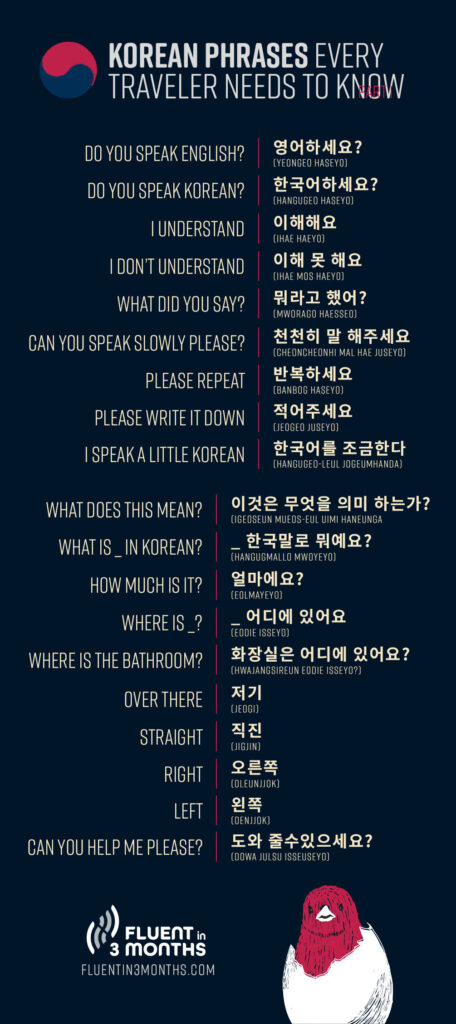
Want to avoid getting lost, confused, or otherwise stuck while on a trip to Korea? These are the most helpful phrases for when you’re trying to get by in Korean!
- Do you speak English?: 영어하세요? ( yeongeo haseyo? )
- Do you speak Korean?: 한국어하세요? ( hangugeo haseyo? )
- I understand: 이해해요 ( ihae haeyo )
- I don’t understand: 이해 못 해요 ( ihae mos haeyo )
- What did you say?: 뭐라고 했어? ( mworago haesseo? )
- Can you speak slowly please?: 천천히 말 해주세요 cheoncheonhi mal hae juseyo? )
- Please repeat: 반복하세요 ( banbog haseyo )
- Please write it down: 적어주세요 ( jeogeo juseyo )
- I speak a little Korean: 한국어를 조금한다 ( hangugeo-leul jogeumhanda )
- What does this mean?: 이것은 무엇을 의미 하는가? ( igeoseun mueos-eul uimi haneunga? )
- What is _ in Korean?: _ 한국말로 뭐예요? ( hangugmallo mwoyeyo? )
- How much is it?: 얼마에요? ( eolmayeyo? )
- Where is _ ?: _ 어디에 있어요? ( eodie isseyo? )
- Where is the bathroom?: 화장실은 어디에 있어요? ( hwajangsireun eodie isseyo? )
- Over there: 저기 ( jeogi )
- Straight: 직진 ( jigjin )
- Right: 오른쪽 ( oleunjjok )
- Left: 왼쪽 ( oenjjok )
- Can you help me please?: 도와 줄수있으세요? ( dowa julsu isseuseyo? )
Related learning: Hear about another learner’s experience with Korean in this episode of the Language Hacking:
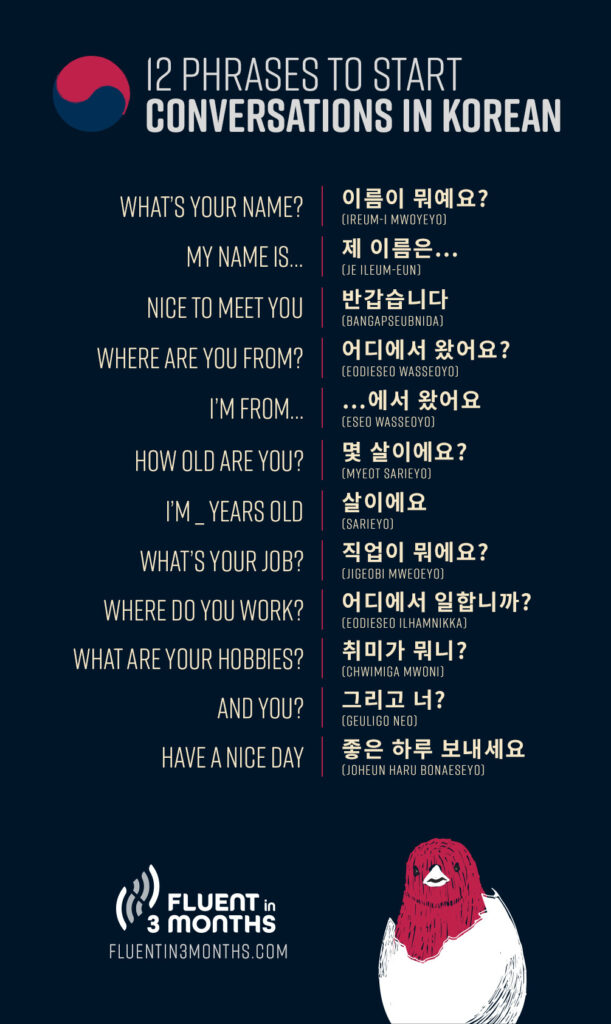
Now, no conversation is complete without a few questions thrown in! You’ll need to know how to ask some simple questions for your first conversation. These basic Korean phrases are a great place to start:
- What’s your name?: 이름이 뭐예요? ( ireum-i mwoyeyo? )
- My name is…: 제 이름은… ( je ileum-eun )
- Nice to meet you: 반갑습니다 ( bangapseubnida )
- Where are you from?: 어디에서 왔어요? ( eodieseo wasseoyo? )
- I’m from…: …에서 왔어요 ( eseo wasseoyo )
- How old are you?: 몇 살이에요? ( myeot sarieyo )
- I’m ** … ** years old: ** … ** 살이에요 ( sarieyo )
- What’s your job?: 직업이 뭐에요? ( jigeobi mweoeyo? )
- Where do you work?: 어디에서 일합니까? ( eodieseo ilhamnikka? )
- What are your hobbies?: 취미가 뭐니? ( chwimiga mwoni? )
- And you?: 그리고 너? ( geuligo neo? )
- Have a nice day: 좋은 하루 보내세요 ( joheun haru bonaeseyo )
[IMAGE: IG. Caption: ‘When Benny started learning his first Korean phrases, he got a webtoon version of himself made!’ Link: https://www.instagram.com/p/Com1IWdSCJ3/ ]
Practical Steps to Having Your First Conversation in Korean
Now that you’ve seen the most common Korean phrases and words to learn for your first conversation, it’s time to prepare!
Having your first Korean conversation can be super nerve-wracking. But the whole point of learning the language is to speak and have conversations with new people, right?
So we have to work past our nerves and do the thing!
That said, what is the best way to get over your nerves?
Come prepared.
I’ve listed some of my favorite tips for getting through your first Korean language exchange. If you do these things, you’ll feel way more confident!
I’ve also included extra resources for each tip, so you can continue to learn Korean and grow your skills.
In every language, there are about 100 words that make up around 50% of all spoken speech.
Crazy, isn’t it?
A lot of these words are small, connecting words like “the” and “in” in English. But there are many common nouns, verbs, adjectives, and adverbs we use all the time . Korean is no different.
So check out this article to learn the 111 core Korean words you need to know.
Keep in mind though, that it’s also important to learn words relevant to you , specifically. That’s where our next tip comes in.
Take a look at the phrases above we already covered. Let’s say you asked someone what their hobbies are. Then they asked, “What about you?”
Well, do you know how to say your hobbies in Korean?
If not, then it’s time to make a script!
Write out how you think your conversation may go. Script your answers, so when you’re asked questions, you know how to respond. Like this:
“What are your hobbies?” 취미가 뭐니? ( chwimiga mwoni? )
“I like to play guitar and watch Star Wars.” 기타를 연주하고 스타 워즈를 보는 것을 좋아해요. ( gita-leul yeonjuhago seuta wojeu-leul boneun geoseul johahaeyo )
If you think the conversation may dig deeper into that topic, take it even further:
“Cool! I love Star Wars, too. Which Episode is your favorite?” 대박! 나도 스타 워즈를 좋아해요. 가장 좋아하는 에피소드는 뭐니? ( Daebak! Nado seuta wojeu-leul johahaeyo. Gajang johaha-neun episode-neun mwoni? )
“I really love Episode 5: Empire Strikes Back. I didn’t like the latest movie, The Rise of Skywalker.” Empire Strikes Back을 정말 좋아합니다. 최신 영화 The Rise of Skywalker가 마음에 좋아하지 않아요. ( Empire Strikes Back-eul jeongmal johahaeyo. Choesin yeonghwa The Rise of Skywalker-ga maeume johahaji anhayo. )
( I’m not speaking from personal preference or anything… )
You know how to talk about things you care about during your conversation!
Here are some more tips for creating a language exchange script and how to find a partner .
Next step? Start speaking. Today. Right now.
You’ve got this list of phrases. You’re working on your Korean script. Now start saying them out loud and often . Repeat them every day.
Get used to how Korean sounds are formed with your mouth and how they sound rolling off your tongue.
Depending on your native language, that can be quite a change. So to prevent stumbling in-person, get used to saying the things you want to say.
Speaking from day one is the whole basis of our language learning method here at Fluent in 3 Months , and that’s because it works.
Check out more tips for how to speak in your target language .
Now that you’re speaking, you’ll need to work on your pronunciation.
Korean pronunciation is a bit different from English and other European languages. It takes some getting used to. It takes even more practice to listen and understand .
The best way to master your Korean pronunciation is to listen often and repeat always.
My favorite way to do that is with KoreanClass101 . It’s the best Korean podcast out there, with all kinds of lessons to help you learn Korean fast. They even have lessons on pronunciation.
You can pop in your headphones, and practice repeating while cleaning the house. Or play it in the car during your commute.
The key is getting used to how Korean sounds, learning to understand what is spoken and getting comfortable saying it yourself.
Check out KoreanClass101 here to work on your pronunciation.
Wait… why learn how to read Korean if your goal is to speak ?
Well, it’s because the romanization of Korean words is not consistent. If you base the sound on how it’s romanized, you’ll most likely mispronounce the word.
That’s where hangul comes in. If you know how to read hangul, you’ll be able to pronounce Korean better.
You aren’t trying to make Korean fit the limited sounds in English. Instead, you’re learning it as it’s designed to sound.
Besides, when you can read hangul, you can get into all kinds of amazing Korean resources with ease. That’s where the fun really starts!
This is a handy guide to learn Hangul fast . You can also check out these tips to make learning Korean easy .
Now you’re ready to have conversations in Korean. Way to go!
To further improve your level, check out these articles:
- Learn How to Say “Thank You” in Korean (Master Your Manners)
- How to Learn the Korean Alphabet and Write in Korean [Step-by-Step Guide]
- 111 Must-Know Korean Verbs
- Easy Korean Numbers: Counting in Korean from 1 – 100+
- Korean Slang: 80+ Everyday Words and Phrases to Sound Like a Native
- Korean Greetings: 10+ Ways to Say “Hello” in Korean
- Innovative Language Review – Complete Pod101 Language Course Review (with Screenshots and Video Results)
Original article by Caitlin Sacasas. Reviewed and updated by the Fluent in 3 Months team on [publish date].
Caitlin Sacasas
Content Writer, Fluent in 3 Months
Caitlin is a copywriter, content strategist, and language learner. Besides languages, her passions are fitness, books, and Star Wars. Connect with her: Twitter | LinkedIn
Speaks: English, Japanese, Korean, Spanish
Have a 15-minute conversation in your new language after 90 days
LinguaJunkie.com
A very cranky language blogger dishing out brutal language tips.
137 Basic Korean Phrases with Audio + PDF. For Beginners!
You’re about to get HIT 🤜 in the FACE 😩 with a TON of Korean Phrases. I mean, to put it nicely, you’re about to LEARN a whole ton and be able to speak Korean.
This guide will teach YOU 137+ Korean phrases with audio.
Wait! Don’t feel overwhelmed. I will talk about secrets of learning these phrases fast down below. There’s also a Free Korean Phrases PDF down below . But, to get you started… here are the most basic Korean phrases with audio you should know:
| 1. Hello (general greeting) | 안녕하세요 (Annyeong haseyo). | |
| 2. Yes | 네 (Ne). | |
| 3. No | 아니요 (Aniyo). | |
| 4. Thank you | 감사합니다 (Gamsahamnida). | |
| 5. I’m sorry | 죄송합니다 (Joesonghamnida). | |
| 6. Goodbye (used when someone is leaving) | 안녕히 가세요 (Annyeonghi gaseyo). | |
| 7. Goodbye (used respectfully) | 안녕히 가십시오 (Annyeonghi gasipshio). | |
| 8. Excuse me | 실례합니다 (Silryehamnida). | |
| 9. My name is [Name] | 저는 [이름] 입니다 (Jeoneun [Name] imnida). | |
| 10. How are you? | 어떻게 지내세요? (Eotteoke jinaeseyo?) |
How to Learn These Phrases
So, this guide has over 100 Korean common phrases. A lot right?
Feeling frustrated that you’ll never learn them all?
Don’t worry, I’ll let you in on a secret to successful learning. The secret is… you DON’T need to memorize them all. You see, learning a language is a lot like riding a bike. The more you do it, the more you get used to it, the more natural it becomes. So, SUCCESSFUL language learning is about becoming USED to Korean, not memorizing.
How do you get used to it? Look, if you’re already learning, there’s 200% chance you will come across these phrases again and again over a span of time. And that natural repetition will solidify the phrases in your brain. No need for memorization. But there IS a need that you 1) be patient because it takes time and 2) keep learning.
But, if YOU DO want to master these phrases and the Korean language… I offer a FREE PDF worksheet for the phrases in this guide. Also, I offer my best Korean learning resource. But that’s at the bottom of this guide if you’re on not lazy to look.
Now, onto the 137 phrases.
Korean Greetings Phrases
First, let’s start with Korean phrases for greetings.
Learning to say hello in Korean and bye in Korean is one of the first things you should do. Well, after learning about the Korean alphabet .
So, here’s a list of the most common Korean greetings , from morning to evening, across various casual levels.
Also, be sure to press the play button to hear the Korean phrases audio pronunciation.
| 1. Hello (general greeting) | 안녕하세요 (Annyeong haseyo). | |
| 2. Hi (casual greeting) | 안녕 (Annyeong). | |
| 3. Good morning? (Used when meeting someone in the morning) | 안녕히 주무셨어요? (Annyeonghi jumusyeosseoyo?) | |
| 4. It’s a good morning (casual) | 좋은 아침이에요 (Joheun achimi-eoyo). | |
| 5. Good afternoon? (Used during the afternoon) | 안녕하세요 (Annyeong haseyo). | |
| 6. It’s a good afternoon (casual) | 좋은 오후에요 (Joheun ohu-eoyo). | |
| 7. Good evening? (Used during the evening) | 안녕하세요 (Annyeong haseyo). | |
| 8. It’s a good evening (casual) | 좋은 저녁이에요 (Joheun jeonyeogi-eoyo). | |
| 9. It’s a good night (casual) | 좋은 밤이에요 (Joheun bami-eoyo). | |
| 10. How have you been? | 잘 지냈어요? (Jal jinaesseoyo?) | |
| 11. How do you do? (Formal and respectful) | 안녕하십니까? (Annyeong hasimnikka?) | |
| 12. Goodbye (used when someone is leaving) | 안녕히 가세요 (Annyeonghi gaseyo). | |
| 13. Goodnight (used when someone is going to sleep) | 안녕히 주무세요 (Annyeonghi jumuseyo). | |
| 14 .Take care (casual) | 안녕하게 지내요 (Annyeonghage jinaeyo). | |
| 15. Be healthy (a common well-wishing phrase) | 건강하세요 (Geongang haseyo). |
Korean Phrases for “How Are You”
Now, do you know how to say how are you in Korean ?
And how to answer that question?
Obviously, this question is used a whole ton in Korean, so you should know how to ask it. And of course, all the possible answers. Also, I am including formal and casual forms, but I figure you’re more interested in casual, right?
| 1 | How are you? (formal) | 어떻게 지내세요? (Eotteoke jinaeseyo?) | |
| 2 | I’m doing well. (formal) | 잘 지내고 있어요. (Jal jinaego isseoyo.) | |
| 3 | I’m okay. (formal) | 괜찮아요. (Gwaenchanayo.) | |
| 4 | I’m a bit tired. (formal) | 조금 피곤해요. (Jogeum pigonhaeyo.) | |
| 5 | I’m busy. (formal) | 바빠요. (Bappayo.) | |
| 6 | How are you? (Casual) | 어떻게 지내? (Eotteoke jinae?) | |
| 7 | I’m doing well. (Casual) | 잘 지내. (Jal jinae.) | |
| 8 | I’m okay. (Casual) | 괜찮아. (Gwaenchan-a.) | |
| 9 | I’m a bit tired. (Casual) | 조금 피곤해. (Jogeum pigonhae.) | |
| 10 | I’m a bit busy. (Casual) | 좀 바빠. (Jom bappa.) | |
| 11 | How’s everything? (formal) | 모든 게 어떠세요? (Modeun ge eotteoseyo?) | |
| 12 | Everything is going well. (formal) | 다 잘 되고 있어요. (Da jal doego isseoyo.) | |
| 13 | Everything is okay. (formal) | 그럭저럭 괜찮아요. (Geureokjeoreok gwaenchanayo.) | |
| 14 | Things are a bit busy. (formal) | 좀 바빠요. (Jom bappayo.) | |
| 15 | How’s everything? (Casual) | 모든 게 어떻게 돼? (Modeun ge eotteoke dwae?) | |
| 16 | Everything is going well. (Casual) | 다 잘 돼고 있어. (Da jal dwaego isseo.) | |
| 17 | Everything is okay. (Casual) | 괜찮아. (Gwaenchan-a.) | |
| 18 | Things are a bit busy. (Casual) | 좀 바빠. (Jom bappa.) | |
| 19 | What’s up? (Casual) | 어떻게 지내? (Eotteoke jinae?) | |
| 20 | Not much. (Casual) | 별일 없어 (Byeolil eopseo) | |
| 21 | I’m sleepy. (Casual) | 졸려 (Jollyeo). |
Korean Questions
While you’re learning phrases, it’s also important to learn Korean questions and how to ask them. Why? Well, because Korean questions are… phrases… groups of words that request a response. So, it counts.
Here are the most common Korean questions to know, including Korean question words.
You’ll learn important questions like “Where is the toilet? and “What’s your name?” in Korean.
| 1 | Who? | 누구? (Nugu?) | |
| 2 | What? | 뭐? (Mwo?) | |
| 3 | When? | 언제? (Eonje?) | |
| 4 | Where? | 어디? (Eodi?) | |
| 5 | Why? | 왜? (Wae?) | |
| 6 | How? | 어떻게? (Eotteoke?) | |
| 7 | Why not? | 왜 안 돼요? (Wae an dwaeyo?) | |
| 8 | How about you? | 너는 어때? (Neoneun eottae?) | |
| 9 | How are you? | 어떻게 지내세요? (Eotteoke jinaeseyo?) | |
| 10 | What’s up? | 어떻게 지내? (Eotteoke jinae?) | |
| 11 | What is this? | 이게 뭐에요? (Ige mwoeyo?) | |
| 12 | Where is ….? | …. 어디에요? (…. Eodieyo?) | |
| 13 | How is it? | 어때요? (Eottaeyo?) | |
| 14 | When is it? | 언제에요? (Eonjeeyo?) | |
| 15 | What time is it? | 지금 몇 시에요? (Jigeum myeot sieyo?) | |
| 16 | What is that? | 그게 뭐에요? (Geuge mwoeyo?) | |
| 17 | Where are you from? | 어디 출신이에요? (Eodi chulsinieyo?) | |
| 18 | Can you understand English? | 영어 이해해요? (Yeongeo ihaehaeyo?) | |
| 19 | Do you understand? | 이해해요? (Ihaehaeyo?) | |
| 20 | Where is the bathroom? | 화장실 어디에요? (Hwajangsil eodieyo?) | |
| 21 | Are you okay? | 괜찮아요? (Gwaenchanayo?) | |
| 22 | What is your name? | 이름이 뭐에요? (Ireumi mwoeyo?) | |
| 23 | How old are you? | 몇 살이에요? (Myeot salieyo?) | |
| 24 | Can you speak Korean? | 한국어 할 수 있어요? (Hangugeo hal su isseoyo?) | |
| 25 | Can you help me? | 도와줄 수 있어요? (Dowajul su isseoyo?) |
Korean Phrases for Korean Learners
Now, as a learner, there are some specific phrases that you must know.
If you know these Korean phrases and questions, you can improve your Korean even more.
I am talking about phrases like “How do you say… in Korean” or “What does this word mean?”
If you can say these phrases, you are no longer learning in English. You are NOW learning in Korean… which is even better because you’re now spending more time in Korean and less in English. The goal is to switch over to Korean, if you want to be fluent.
So, check out the 20 phrases for Korean learners below.
| 1 | How do you say “Word” in Korean? | 한국어로 “Word” 어떻게 말해요? (Hangugeo-ro “Word” eotteoke malhaeyo?) | |
| 2 | What does “Word” mean? | “Word”은/는 뭐에요? (“Word”eun/neun mwoeyo?) | |
| 3 | What does that word mean? | 그 단어의 뜻이 뭐에요? (Geu daneo-ui ddeusi mwoeyo?) | |
| 4 | Did I say that correctly? | 제가 제대로 말한 걸까요? (Jega jedaero malhan geolkka?) | |
| 5 | What’s the difference between “Word” and “Word”? | “Word”와 “Word”의 차이가 뭐에요? (“Word” wa “Word” ui chaeiga mwoeyo?) | |
| 6 | I have a question. | 제가 질문이 있어요. (Jega jilmuni isseoyo.) | |
| 7 | Can you say that again please? | 다시 한 번 말해 주세요. (Dasi han beon malhae juseyo.) | |
| 8 | Can you say that slowly? | 천천히 말해 주세요. (Cheoncheonhi malhae juseyo.) | |
| 9 | How is my Korean? | 제 한국어 어때요? (Je hangugeo eottaeyo?) | |
| 10 | I want to be fluent in Korean. | 제가 한국어를 유창하게 말고 싶어요. (Jega hangugeo-reul yuchanghage malgo sip-eoyo.) | |
| 11 | I want to learn Korean. | 제가 한국어를 배우고 싶어요. (Jega hangugeo-reul baeugo sip-eoyo.) | |
| 12 | I want to speak Korean. | 제가 한국어로 말하고 싶어요. (Jega hangugeo-lo malhago sip-eoyo.) | |
| 13 | I want to understand Korean dramas. | 제가 한국 드라마를 이해하고 싶어요. (Jega hanguk deurama-reul ihaehago sip-eoyo.) | |
| 14 | Please practice Korean with me. | 저랑 한국어 연습해 주세요. (Jeolang hangugeo yeonseuphae juseyo.) | |
| 15 | I have been learning Korean for 1 year. | 1년 동안 한국어를 공부했어요. (Hannyeon dongan hangugeo-reul gongbuhayeosseoyo.) | |
| 16 | I learn Korean with “Word”. | 제가 “Word”와 함께 한국어를 배워요. (Jega “Word”wa hamkke hangugeo-reul baewoyo.) | |
| 17 | Is my pronunciation okay? | 제 발음 괜찮아요? (Je bareum gwaenchanayo?) | |
| 18 | What is a natural way to say “Word” in Korean? | 한국어로 “Word”를 자연스럽게 어떻게 표현하나요? (Hangugeo-lo “Word”-reul jayeonseuleopge eotteoke pyohyeonhanayo?) | |
| 19 | I want to say “Word” in Korean. | 한국어로 “Word”라고 말하고 싶어요. (Hangugeo-ro “Word”rago malhago sip-eoyo.) | |
| 20 | Please teach me Korean. | 제게 한국어를 가르쳐 주세요. (Jege hangugeo-reul gareuchyeo juseyo.) |
Cute Phrases
Now, some of you are interested in cute Korean phrases . Maybe because you’re watching K-Dramas. Maybe because you’re listening to K-POP. Or maybe because you just want to use these with your friends.
So, you’ll learn to say things like I like you in Korean , I love you in Korean , and more.
Note, these phrases will be casual.
| 1 | Are you here alone? | 혼자 오셨어요? (honja osyeoss-eoyo?) | |
| 2 | Can I get your telephone number? | 전화번호 좀 알려 주시겠어요? (jeonhwabeonho jom allyeo jusigess-eoyo?) | |
| 3 | Do you have time? | 혹시 시간 있으세요? (hogsi sigan iss-euseyo?) | |
| 4 | Do you mind if I join you? | 잠시 합석해도 될까요? (jamsi habseoghaedo doelkkayo?) | |
| 5 | Do you want to date? | 사귈래? (sagwillae?) | |
| 6 | Does love change? | 사랑이 어떻게 변해요? (salang-i eotteohge byeonhaeyo?) | |
| 7 | Don’t be so cold. | 그렇게 쌀쌀맞게 대하지 마세요. (geuleohge ssalssalmajge daehaji maseyo) | |
| 8 | Don’t cry. | 울지 마. (ulji ma) | |
| 9 | Don’t go. | 가지 마. (gaji ma) | |
| 10 | Don’t worry. | 걱정하지 마. (geogjeonghaji ma) | |
| 11 | I love you. | 사랑해. (salanghae) | |
| 12 | I like you. | 나 너 좋아해. (na neo joh-ahae) | |
| 13 | I miss you. | 보고 싶어요. (bogo sip-eoyo) | |
| 14 | I want to hug you. | 안아주고 싶어. (an-ajugo sip-eo.) | |
| 15 | I’m happy. | 행복해. (haengboghae) |
Phrases About Yourself
Now, outside of the obvious phrases like “Hi” and “How are you,” you should also be able to talk about yourself. As in, introduce yourself in Korean and talk about your likes and interests.
| 1 | My name is X. | 제 이름은 X 이에요. (Je ireumeun Xieyo.) | |
| 2 | I am X years old. | 제 나이는 X 살이에요. (Je naineun X salieyo.) | |
| 3 | I am from X. | 저는 X 출신이에요. (Jeoneun X chulsinieyo.) | |
| 4 | I live in X. | 저는 X 에 살아요. (Jeoneun X-e sarayo.) | |
| 5 | I like KPOP. | 저는 K-pop을 좋아해요. (Jeoneun K-pop-eul joahaeyo.) | |
| 6 | My favorite idol is X. | 제가 가장 좋아하는 아이돌은 X이에요. (Jega gajang joahaneun aidoreun Xieyo.) | |
| 7 | My favorite show is X. | 제가 가장 좋아하는 프로그램은 X이에요. (Jega gajang joahaneun peurogeuraemeun Xieyo.) | |
| 8 | What’s your favorite show? | 당신이 가장 좋아하는 프로그램은 뭐에요? (Dangsin-i gajang joahaneun peurogeuraemeun mwoeyo?). | |
| 9 | Who is your favorite idol? | 당신이 가장 좋아하는 아이돌은 누구에요? (Dangsin-i gajang joahaneun aidoreun nugueyo?). | |
| 10 | I like to learn Korean. | 저는 한국어 배우는 걸 좋아해요. (Jeoneun hangugeo baeuneun geol joahaeyo.) | |
| 11 | I like South Korea. | 저는 남한을 좋아해요. (Jeoneun Namhaneul joahaeyo.) | |
| 12 | I want to visit South Korea. | 저는 남한을 방문하고 싶어요. (Jeoneun Namhaneul bangmunhago sip-eoyo.) | |
| 13 | I have been to South Korea. | 저는 남한에 다녀왔어요. (Jeoneun Namhane danyeowasseoyo.) | |
| 14 | I have never been to South Korea. | 저는 남한에 가본 적이 없어요. (Jeoneun Namhane gabon jeogi eopseoyo.) | |
| 15 | I like Korean food. | 저는 한국 음식을 좋아해요. (Jeoneun Hanguk eumsikeul joahaeyo.) | |
| 16 | I like X. | X 을/를 좋아해요. (X-eul/leul joahaeyo.) | |
| 17 | I don’t like X. | X 을/를 좋아하지 않아요. (X-eul/leul joahaji anayo.) | |
| 18 | Do you like X? | 당신은 X 을/를 좋아해요? (Dangsin-eun X-eul/leul joahaeyo?) |
Korean Travel Phrases
Finally, if you find youself in Korea… there are some good Korean travel and survival phrases to know. Like “where is the bathroom” and “how much is this?”

100 Most Common Korean Phrases and Words to Learn
Introduction.
Explore the magic that is the Korean language! Whether it's "annyeonghaseyo" (hello) or “kamsahamnida” (thank you), understanding a bit opens up a richer experience and helps you connect with locals effortlessly. Let’s jump into the adventure of language and culture in the heart of Korea and make everyday moments unforgettable!
Common Korean Phrases for Everyday Life (formal and informal)
When diving deep into Korean, it's like having two sets of social keys: the formal one for respectful conversations with elders, strangers, or at work, and the informal one for a friendly chit-chat with family or friends. Think of the formal mode as your neat, office-ready outfit, and the informal as your cozy weekend pajama. Pay attention to who you're chatting with - elders or supervisors get the polished version, friends and siblings get the casual one. Let’s take a look at some of the most common everyday phrases and their two versions:
1. Good morning.
Formal: 좋은 아침입니다. (joheun achimimnida.)
Informal: 좋은 아침. (joheun achim.)
Use the formal version when addressing someone older or in a more official setting. You’re good to go with the casual version if it’s for friends or someone younger.
2. Good evening.
Formal: 좋은 저녁입니다. (joheun jeonyeokimnida.)
Informal: 좋은 저녁. (joheun jeonyeok.)
Similar to "Good morning," choose the formal for elders or formal occasions, and the informal for friends or casual settings.
3. Goodbye .
Formal: 안녕히 계세요. (annyeonghi gyeseyo.)
Informal: 안녕. (annyeong.)
Use the formal version when someone from the group is staying, and the informal for casual farewells. Check out some other ways to bid farewell in Korean !
4. Nice to meet you.
Formal: 만나서 반갑습니다. (mannaseo bangapseumnida.)
Informal: 만나서 반가워. (mannaseo bangawo.)
Not a surprise at this point, but the formal phrase is for new acquaintances in official settings, while the informal is suitable for friends or someone of similar age.
5. Have a nice day!
Formal: 좋은 하루 되세요. (joheun haru doeseyo.)
Informal: 좋은 하루 되. (joheun haru doe.)
Express good wishes for the day ahead, with the formal version for elders or in more official situations.
6. My name is ___.
Formal: 제 이름은 ___ 입니다. (je ireumeun ___ imnida.)
Informal: 내 이름은 ___야. (nae ireumeun ___ ya.)
Introduce yourself with the formal form in professional settings or for strangers, while using the informal one for friendly introductions.
7. I’m sorry.
Formal: 죄송합니다. (joesonghamnida.)
Informal: 미안해. (mianhae.)
If you are ever in a more serious situation or you are talking to elders, the formal version is more appropriate, but if it’s just a casual apology, then the informal one should do.
8. What did you say?
Formal: 뭐라고 하셨어요? (mworago hasyeosseoyo?)
Informal: 뭐라고 했어? (mworago haesseo?)
It is not rude to ask back, but make sure you use the formal when speaking to someone older or in a formal context. The informal version is for friends or casual situations.
9. I understand.
Formal: 이해했습니다. (ihaehaetsseumnida.)
Informal: 이해했어. (ihaehaesseo.)
The formal version is your go-to when you're in a serious nodding situation. The informal, however, has a friendly “got it!” laid-back vibe to it.
10. I don’t know.
Formal: 모르겠습니다. (moreugetseumnida.)
Informal: 몰라. (molla.)
For polished scenarios, the formal version is the best way to say “I lack the knowledge.” The informal one is more like a casual shrug when someone asks a stumper.
11. Please wait!
Formal: 기다려 주세요. (gidaryeo juseyo.)
Informal: 기다려. (gidaryeo.)
The formal form is your polished request in professional lobbies, whereas the informal one is like tapping a friend on the shoulder, saying, “Hang on a sec!”
12. Just a moment, please.
Formal: 잠시만 기다려 주세요. (jamsiman gidaryeo juseyo.)
Informal: 잠시만 기다려. (jamsiman gidaryeo.)
The formal one is your pause button for those high-stakes meetings, but the informal one could be used during a chat with pals.
13. Bon appétit! (before a meal)
Formal: 잘 먹겠습니다. (jal meokgetseumnida.)
Informal: 잘 먹을게. (jal meogeulge.)
When you are ever in a posh dining setting, use the formal form, and the informal one, when you want to casually say “Let’s dig in!”
Basic Korean Words and Phrases
1. Hello/Hi
Formal: 안녕하세요 (annyeonghaseyo)
Informal: 안녕 (annyeong)
The situation makes the difference here again. The formal version is like a polite wave to someone you've just met, and the informal one works as a friendly nod to a buddy. Learn more about how to say "hi" in Korean here !
Formal / Informal: 네 (ne)
"네" is the key to the door of agreement. It opens both the formal and casual gates. There are, of course, more informal versions of how to say yes in, but always make sure you use them with people who are lower in the social hierarchy than you are. With them, instead of “네”, you can say “응” (eung) as well.
Formal / Informal: 아니요 (aniyo)
You can use 아니요 (aniyo) for all occasions. This is the most basic form of saying “no” and can be used by itself. If you want to go super informal, just drop the 요 (yo) from the end of the word and say 아니 (ani).
4. Okay/Alright
Formal: 알겠습니다 (algesseumnida)
Informal: 알았어 (alasseo)
The formal version is like saying, "I understand, sir/madam!", while the casual one is more like a chill "Got it!"
5. Thank you
Formal: 고맙습니다 (gomapseumnida)
Informal: 고마워 (gomawo)
The formal form is your go-to for official gratitude, while the informal is like a warm hug of thanks. 감사합니다 (kamsahamnida) is another well-known way of saying “thank you” in Korean. It uses formal and polite language, so it can be used in a formal setting or with strangers and people older than you. You can casually use this version of “thanks” for everyday life in Korea.
6. I'm sorry
Formal: 죄송합니다 (joesonghamnida)
Informal: 미안해 (mianhae)
Whether you accidentally stepped on toes or forgot a friend's birthday, use these to sprinkle a little apology magic.
7. Excuse me/Hey (to get someone's attention)
Formal: 저기요 (jeogiyo)
Informal: 저기 (jeogi)
When you're in a crowded place and need to navigate through or speak to someone without being overly familiar, "저기요" is a courteous way to do so. Think of it as a refined excuse-me in a bustling space.
Formal: 저 (jeo)
Informal: 나 (na)
The formal version, "저," is a refined introduction, reserved for official or formal occasions when you want to make a neat first impression. On the other side, "나" is your easygoing entrance to a casual conversation—a laid-back choice for friendly chats and informal settings.
Formal: 당신 (dangsin)
Informal: 너 (neo)
"당신" is akin to addressing someone with "sir" or "ma'am," ideal for more formal or respectful conversations. "너" is a go-to for casual chats among friends.
10. South Korea - 대한민국 (daehan minguk)
This term, meaning "The Republic of Korea," is your all-access pass to a world of sizzling street food, ancient palace tales, and the busting vibes of K-pop.
11. Korean language - 한국어 (hangugeo)
"한국어" is your magic wand for understanding K-dramas without the need for subtitles. Embrace it formally for language classes or casually when diving into linguistic adventures with Korean friends. It's the key to unlocking a world of communication in Korean!
Useful Korean Phrases for Getting Around
Exploring new places in Korea can be an exciting adventure if you know the right way. To ensure seamless navigation and interactions with locals, here are seven essential Korean phrases to assist you along your way:
1. Here - 여기 (yeogi)
Example: 여기에 앉아도 돼요. (yeogie anjado dwaeyo.) -You can sit here.
"여기" is a simple and essential term for indicating a location. Use it when pointing to or referring to a specific place that is close to you as the speaker.
2. Place - 장소 (jangso)
Example: 이곳은 아주 평화로운 장소에요. (igoseun aju pyeonghwaroun jangsoeyo.) -This place is a very peaceful location.
"장소" is a versatile term for any location or venue. It's commonly used when describing or referring to different places.
3. Right - 오른쪽 (oreunjjok)
Example: 오른쪽으로 돌아주세요. (oreunjjogeuro dorajuseyo.) - Please turn to the right.
"오른쪽" is used to indicate the right side or direction. It comes in handy for giving or following directional instructions.
4. Left - 왼쪽 (oenjjok)
Example: 왼쪽에 꽃이 있어요. (oenjjoge ggoci isseoyo.) -There is a flower on the left.
"왼쪽" is used to indicate the left side or direction. It's a practical term for providing directions or describing locations.
5. Forward - 앞으로 (apuro)
Example: 앞으로 나아가세요. (apuro naagaseyo.) - Move forward.
"앞으로" is a directional term indicating forward or ahead. Use it when instructing someone to proceed in a forward direction.
6. City - 도시 (dosi)
Example: 서울은 큰 도시에요. (Seoul-eun keun dosieyo.) -Seoul is a big city.
"도시" is commonly used to refer to a city. It's an essential term for discussing urban areas.
7. Country - 나라 (nara)
Example: 한국은 아름다운 나라에요. (hanguk-eun areumdaun naraeyo.) - Korea is a beautiful country.
"나라" is used to denote a country. It's a fundamental term for talking about different nations.
8. Train station / Metro Station - 기차역 (gichayeog) / 지하철역 (jihacheol yeok)
Example: 기차역에서 택시를 탈 거예요. (gichayeogeseo taeksireul tal geoyeyo.) - I will take a taxi from the train station.
"기차역" specifically refers to a train station, a crucial term when discussing transportation.
9. Bathroom - 화장실 (hwajangsil)
Example: 화장실 어디에요? (hwajangsil eodieyo?) - Where is the bathroom?
"화장실" is the term for a bathroom or restroom. It's a practical term for daily use.
10. How do I get here? - 여기 어떻게 가요? (yeogi eotteoke gayo?)
This question is your golden ticket to local insights. Perfect for engaging locals and getting the best tips on navigating Korean streets or finding hidden gems.
11. I'm looking for……찾고 있어요. (chatgo isseoyo.)
A useful phrase when you're on a mission, whether it's hunting down a cafe, finding a landmark, or searching for that perfect souvenir.
12. Where is the metro station? - 지하철역 어디에요? (jihacheollyeok eodieyo?)
This short but useful sentence will help you ask for directions to the nearest metro station, supermarket, or even the hospital. Use it when you need directions to key locations in the city.
13. I am lost. - 길을 잃었어요. (gireul ireosseoyo.)
Translating as “I lost my way”, this phrase can help you express your confusion or seek assistance when you're unsure of your location.
14. Turn right/left. - 오른쪽/왼쪽으로 돌아요. (oreunjjok/oenjjogeuro dorayo.)
Provide or follow directions by indicating the direction to turn when navigating streets or pathways. Whether you're directing a friend to the nearest cafe or following a local's instructions, this phrase is your guide to seamless navigation.
These practical Korean phrases will not only guide you on your journey but also enhance your interactions with locals, making your experience more engaging and enjoyable.
Korean Phrases for Shopping
Prepare for a shopping spree in Korea! Whether you're exploring souvenirs, updating your wardrobe, or looking for local delicacies, arm yourself with these must-know shopping phrases. They're your ticket to navigating the shopping scene like a pro!
1. Shop - 가게 (gage)
Example: 이 가게에서 신발을 살 거예요. (i gageseo sinbaleul sal geoyeyo.) - I will buy shoes at this shop.
"가게" is a versatile term for any kind of shop or store. It can refer to a clothing store, grocery store, or any retail establishment.
2. Cash - 현금 (hyeongeum)
Example: 현금으로 결제할게요. (hyeongeumeuro gyeoljehalgeyo.) -I will pay with cash.
"현금" refers to physical currency or cash. It's a common term used when dealing with transactions involving paper money or coins.
3. Credit card - 신용카드 (sinyongkadeu)
Example: 신용카드는 여기서 사용할 수 있어요. (sinyongkadeuneun yeogiseo sayonghal su iteoyo.) -You can use a credit card here.
"신용카드" specifically denotes a credit card. It's a widely accepted form of payment in various establishments.
4. How much is it? - 이거 얼마에요? (igeo eolmaeyo?)
Use this friendly and commonly used phrase when inquiring about the price of an item. It is a polite way to ask, suitable for both formal and informal settings.
5. Can I try this on? - 이거 입어봐도 돼요? (igeo ibeobwado dwaeyo?)
Employ this phrase when you want to try on a piece of clothing. It's a polite and versatile expression suitable for both formal and informal situations, making it handy for shopping.
6. Can you give me a discount? - 할인해 주실 수 있을까요? (harinhae jusil su isseulkkaoyo?)
When you're feeling a bit savvy and want to negotiate the price, use this polite expression to ask for a discount. It's appropriate for formal settings and may be used in certain informal situations.
7. Do you accept cards? - 카드로 결제할 수 있어요? (kadeuro gyeoljehal su isseoyo?)
In a world where cards are often more convenient than cash, this question is perfect for checking if card payment is accepted. It's suitable for both formal and informal contexts.
8. This one, please. - 이거 주세요. (igeo juseyo.)
When you've found the item you want to purchase, use this polite expression to ask for it. It's a courteous and versatile phrase suitable for various shopping situations, whether formal or informal.
These sentences cover common shopping scenarios, making them useful for navigating stores and making transactions as a beginner Korean learner. Remember to use polite language, as it is customary in Korean culture, especially when interacting in commercial settings!
Korean Phrases for Going Out
The vibrant Korean social scene is definitely a fun one to immerse yourself in. With these essential phrases for going out, you can make the most of your time:
1. Pub - 술집 (suljib)
Example: 이 근처에 좋은 술집이 있나요? (i geuncheoe joeun suljibi innayo?) - Is there a good pub around here?
When exploring the local nightlife or looking for a place to unwind with pals, "술집" is your go-to term, as it can refer to a cozy spot for a casual drink or a lively pub atmosphere too.
2. Party - 파티 (pati)
Example: 오늘 저녁에 파티가 있어요. (oneul jeonyeoge patiga isseoyo.) - There's a party tonight.
The term "파티" captures the spirit of joyous occasions, whether it's a birthday celebration, a festive event, or a casual get-together with friends.
3. Restaurant - 식당 (sikdang)
Example: 이 식당의 음식은 맛있어요. (i sikdang-ui eumsigeun masisseoyo.) - The food at this restaurant is delicious.
When discussing dining options, "식당" refers to a restaurant where you can sit down and enjoy a meal. It's a versatile term covering anything from casual eateries to fine dining places.
4. Friends - 친구 (chingu)
Example: 친구들과 함께 외식하고 싶어요. (chingudeulgwa hamkke oesikago sipoyo.) - I want to eat out with friends.
"친구" is a warm term for friends, and when combined with activities like dining out, it signifies socializing and spending quality time together.
5. Dance - 춤 (chum)
Example: 이 노래에 춰볼래요. (i norae-e chwobolllaeyo.) -I want to dance to this song.
When the music moves you, "춤" is the term for expressing that rhythm through dance.
6. Music - 음악 (eumak)
Example: 어떤 음악을 좋아하세요? (eotteon eumageul johahaseyo?) - What kind of music do you like?
Use the term "음악" when discussing musical preferences, sharing favorite tunes, or exploring the diverse landscape of melodies and rhythms.
7. I'd like a drink. - 술 좀 주세요. (sul jom juseyo.)
Whether you're at a bar, restaurant, or social gathering, use this phrase to order a drink in a casual way.
8. I'm hungry. - 배고파요. (baegopayo.)
When your stomach is growling and it's time to refuel, "배고파요" is the phrase to let others know you're ready for a delicious meal.
9. Is this seat taken? - 여기 자리 비었어요? (yeogi jari bieosseoyo?)
Whether you're at a cafe, restaurant, or any public space, this question helps you politely check if a seat is occupied before settling in.
10. I'm here with friends. - 친구들이랑 여기 왔어요. (chingudeulirang yeogi wasseoyo.)
When joining a social gathering or event, this phrase helps you convey that you're not alone but are accompanied by friends.
11. The food is delicious. - 음식 정말 맛있어요. (eumsik jeongmal masisseoyo.)
When the flavors delight your taste buds, "음식 정말 맛있어요" is the perfect way to compliment the chef and share your satisfaction.
12. It's so much fun! - 정말 재미있어요! (jeongmal jaemiisseoyo.)
Whether you're at a party, or any engaging event, this exclamation captures the thrill and enjoyment of the moment, adding positive energy to the atmosphere.
These versatile Korean phrases will help you navigate social situations, create connections, and make the most of your time out on the town!
Korean Phrases for Emergency
Sometimes travel comes with unexpected twists. Be prepared for unforeseen situations with these essential Korean phrases that can be your lifeline in times of need:
1. Doctor - 의사 (uisa)
Example: 의사를 만나야 해요. (uisareul mannaya haeyo.) - I need to see a doctor.
"의사" is the term for a medical professional, specifically a doctor. When you're discussing health matters, scheduling an appointment, or want to consult with a healthcare expert, feel free to use this term.
2. Ambulance - 구급차 (gugeupcha)
Example: 구급차를 불러주세요. (gugeupchareul bulleojuseyo.) - Please call an ambulance.
In emergencies, "구급차" refers to an ambulance. Use this term when urgently requesting medical assistance, especially in cases of accidents or sudden illnesses.
3. Hospital - 병원 (byeongwon)
Example: 병원에 가야 해요. (byeongwone gaya haeyo.) - I need to go to the hospital.
When you're discussing healthcare and medical facilities, "병원" is the term for a hospital. Use it in need of medical attention or when referring to a healthcare institution.
4. Insurance - 보험 (boheom)
Example: 여행 보험을 가입했어요. (yeohaeng boheomeul gaeiphaesseoyo.) - I have travel insurance.
When discussing risk coverage, "보험" is the to-go term for insurance. It can refer to various types of insurance, such as health insurance, travel insurance, or any other form of risk protection.
5. Police - 경찰 (gyeongchal)
Example: 경찰을 불러주세요. (gyeongchareul bulleojuseyo.) - Please call the police.
Use the term "경찰" when reporting a crime, seeking assistance in emergencies, or interacting with law enforcement authorities.
6. Help me! - 도와주세요! (dowajuseyo!)
If you find yourself in an urgent or distressing situation and need help, this phrase is a direct and powerful way to seek immediate assistance from those around you.
7. Call 119. -119에 전화하세요. (119e jeonhwahaseyo.)
119 is the emergency number in Korea for fire, ambulance, and rescue services, so memorize and use this number when reporting fires, medical emergencies, accidents, or when rescue services are required.
8. Can you help me? - 도와줄 수 있어요? (dowajul su isseoyo?)
When you need assistance and want to ask someone politely, this phrase is a courteous way to seek help.
9. It hurts. -아파요. (apayo.)
Use this phrase to express experiencing physical pain or discomfort, "아파요" is the easiest way to communicate your condition to others, especially when seeking help or medical attention.
10. I lost my passport. - 제 여권을 잃어버렸어요. (je yeogwoneul ilheobeoryeosseoyo.)
In situations where you've lost crucial documents, especially a passport, this phrase is essential when reporting the incident or seeking assistance in the process, so remember it well!
These crucial Korean phrases can be invaluable in critical moments, ensuring you can communicate effectively and easily access the help you need.
Common Korean Phrases in K-drama
1. Amazing / That’s crazy - 대박 (daebak)
Example: 이 음악은 대박이야! (i eumageun daebak iya!) - This music is amazing!
"대박" is a versatile phrase used to express amazement or excitement about something extraordinary or impressive.
2. The best, awesome - 짱 (jjang)
Example: 이 음식 정말 짱이에요! (i eumsik jeongmal jjangieyo!) - This food is really awesome!
"짱" is a slang term indicating that something is the best or awesome. It's often used informally among friends to express enthusiasm and praise for an outstanding event.
3. OMG/ No way - 헐 (heol)
Example: 헐, 진짜? (heol, jinjja?) - OMG, really?
"헐" is basically an exclamation you can say to express surprise, shock, or disbelief. This informal expression is often used in casual conversations to convey amazement or astonishment.
4. Haha or “LOL” (Only used in text) - ㅋㅋ (kk)
Example: 오늘 너무 재밌었어 ㅋㅋ (oneul neomu jaemisseosseo kk) - Today was so fun, haha.
"ㅋㅋ" is the Korean equivalent of "haha" or "LOL" in text messages. It represents laughter and is commonly used in online chats to express a lighthearted tone.
5. I love you - 사랑해 (saranghae) - informal / 사랑해요 (saranghaeyo) - formal
Example: 사랑해요, 내 친구. (saranghaeyo, nae chingu.) - I love you, my friend.
"사랑해" and "사랑해요" are expressions of love, with the former being casual and the latter formal. Use these phrases to express affection towards friends, family, or a romantic partner, depending on the level of formality.
6. Well, I don’t know - 글쎄요
Example: 글쎄요, 난 이번 주말에 뭐 할지 모르겠어. (geulsseoyo, nan ibeon jumale mwo halji moreugesseo.) - Well, I don't know what to do this weekend.
"글쎄요" is another casual expression, used in times of uncertainty. It's a versatile phrase suitable for both casual and more formal situations.
7. Really? - 그래? (geurae) / 진짜? (jinjja) / 정말? (jeongmal)
Example: 정말? (jeongmal?) -Really?
All of these words mean “really?” in English and are all used in the same context, so learn them all and use them to sound more natural. You might also hear them with a 요 (yo) at the end, such as, “진짜요” (jinjjayo).
8. How / What to do? - 어떻게? (eotteoke)
Example: 어떻게 해야 돼? (eotteoke haeya dwae?) - What should I do?
“어떻게" can be used when seeking advice, expressing confusion, or asking for solutions in various situations. It's an essential phrase for navigating uncertainties.
9. Like this - 이렇게 (ireoke)
Example: 이렇게 해 봐. (ireoke hae bwa.) - Try it like this.
When suggesting a particular way of doing something, "이렇게" is the word to go with. It's a handy phrase when providing guidance or instructions.
10. It’s a lie - 거짓말이야 (geojinmariya)
Example: 너 거짓말이야! (neo geojinmariya!) - You're lying!
"거짓말이야" is used to express disbelief or accuse someone of lying. It's a direct and straightforward way to address situations where truthfulness is in question.
11. Are you crazy? - 너 미쳤어 (neo michyeosseo)
Example: 너 미쳤어, 그런 짓을 왜 해? (neo michyeosseo, geureon jiteul wae hae?) - Are you crazy, why would you do that?
If you want to express shock or disapproval, "너 미쳤어" is a useful phrase to know. It's a colloquial way to convey strong emotions in response to surprising or irrational behavior.
12. Hey! - 야 (ya)
Example: 야, 여기와! (ya, yeogiwa!) - Hey, come here!
This informal word can help you get someone's attention and is often used among friends or in casual settings. It adds a friendly and direct tone to your communication.
13. Please - 제발 (jaebal)
Example: 제발 도와주세요. (jaebal dowajuseyo.) - Please help.
"제발" is used when making a polite request or pleading for assistance. By using it, you can add a sense of urgency and politeness to your appeal.
14. Fighting! - 화이팅 (hwaiting)
Example: 시험 잘 볼 수 있을 거야, 화이팅! (hiheom jal bol su isseul geoya, hwaiting!) - You can do well on the exam, fighting!
"화이팅" is a positive and motivational phrase, commonly used in various situations, from exams to challenging tasks.
In Korean dramas, when somebody finds out some exciting gossip, he or she will almost certainly say one of these three Korean words.
Numbers in Korean
In Korean you have not only one, but two counting systems: Native Korean and Sino-Korean numbers. Each system is used in different contexts, so understanding both is essential for smooth communication. Here's a brief intro to each:
Native Korean numbers are the traditional Korean counting system, and they are mainly used for counting items and age, whereas Sino-Korean numbers are derived from Chinese characters and are commonly used for counting money, telling time, and expressing dates, among many other things.
Native Korean
1 하나 (hana)
5 다섯 (daseot)
6 여섯 (yeoseot)
7 일곱 (ilgop)
8 여덟 (yeodeol)
9 아홉 (ahop)
Sino-Korean
10 십 (ship)
For example, 3 o'clock is 세 시 (se shi), so you use native Korean numbers to express the hours, but the date March 1st is 삼월 일일 (samwol iril), which uses the Sino-Korean system. Fun, isn’t it?
Understanding when to use each counting system is crucial for clear communication in Korean. So, whether you're counting apples or discussing the time, having both sets of numbers in your linguistic toolkit will serve you well!
Days of the Week in Korean
Rooted in hanja characters from China, each day of the week in Korean has its unique meanings like moon, fire, and water. Beyond mere weekdays, mastering these words is your key to planning reservations, meetings, and understanding the rhythm of everyday life.
1. Monday - 월요일 (woryoil).
The first 월 (wol) in Monday means “moon.” Guess what, the word 월 (wol) is also used as the nominator for each month in Korean!
Example: 월요일에 학교에 갑니다. (wollyoire hakgyoe gamnida) - I go to school on Monday.
2. Tuesday - 화요일 (hwayoil).
The syllable 화 (hwa) means “fire” and is shortened from the word 화재 (hwajae) meaning “fire” and “blaze” in Korean.
Example: 화요일에 친구를 만납니다. (hwayoire chingureul mannamnida.) - I meet my friends on Tuesday.
3. Wednesday - 수요일 (suyoil).
The first syllable 수 (su) means “water.” You can see it, for example, in words such as 수영 (suyeong), which means “swimming,” and 생수 (saengsu), which means “drinking water.”
Example: 이번주 수요일에 새로운 책을 읽어요. (ibeonju suyoire saeroun chaegeul ilgeoyo.) - I will read a new book this Wednesday.
4. Thursday - 목요일 (mogyoil).
For “Thursday,” it’s 목 (mok) which means means “wood.” Related to this is the word 목재 (mokjae) which means “lumber” or “timber.”
Example: 목요일에 운동을 합니다. (mokyoile undongeul hamnida.) - I exercise on Thursday.
5. Friday - 금요일 (geumyoil).
금 (geum) means “gold,” and it is also popular to refer to Friday nights as 불금 (bulgeum), which translates to “Fire Friday” as 불 (bul) means “flame.” 불금 (bulgeum) is a popular Korean slang term similar to TGIF in English.
Example: 금요일에 영화를 보러 갑니다. (geumyoile yeonghwareul boreo gamnida.) - I go to watch a movie on Friday.
6. Saturday - 토요일 (toyoil).
The first syllable 토 (to) means “soil.” You can apply the same “Fire Friday” slang to Saturday as well. To say “Fire Saturday,” you can say 불토 (bulto).
Example: 토요일에 가족과 시간을 보냅니다. (toyoire gajokgwa siganeul bonaemnida.) - I spend time with my family on Saturday.
7. Sunday - 일요일 (iryoil).
Did you know? The syllable 일 (il) means “day” but can also mean “sun.”
Example: 오늘 일요일 이죠? (oneul illyoil ijyo?) - Today is Sunday, right?
How Drops can help you learn everyday phrases and vocabulary in Korean
Embark on an exciting language-learning journey with Drops and unlock the wonders of the Korean language effortlessly. Our app is designed to make learning Korean enjoyable, effective, and easy. Here's how Drops can elevate your experience:
Playful and Engaging Learning
Drops turns language learning into an enjoyable adventure with gamified challenges and memorization gameplays. Say goodbye to dull lessons and hello to a playful, interactive experience with content uniquely curated for Korean learners . Learn useful terms in topics like “Traveling around South Korea”, “Kpop” or “Korean Food Ingredients.”
Vibrant Visuals
Immerse yourself in Korean culture through vibrant visuals. Drops takes you beyond vocabulary, offering glimpses into Korean customs, traditions, and cultural nuances, making your learning journey not just educational but also visually captivating.
Native Speaker Voices
Sharpen your pronunciation skills with the help of native speaker audio recordings. Choose between our resident native speakers and refine your accent and intonation easily, ensuring you speak Korean with confidence.
Efficient Review Tools
Drops keeps your learning streaks intact with efficient review tools. Reinforce your understanding of the Korean writing , phrases and words to build a solid foundation by answering Quiz Mode questions or reviewing terms in Dojo. This will make language acquisition a seamless process for you.

Whether you're a beginner taking your first step into the Korean language or someone looking to enhance your existing skills, Drops is the key to unlocking the joy of learning Korean. Dive into a world of vibrant visuals, engaging games, and authentic voices – start your Korean learning adventure with Drops today!

Zita Palik is our Hungary based Language Content Manager and an 80's music maniac.
"Love my fun language learning and practice with daily Drops sessions, and monthly Challenges to participate in, and quiz mode to test contextual learning - brilliant! So much thought, consideration and inclusivity has gone into the design and function of this app, I can't praise it highly enough."
"Great little learning app! I've learned at least 5-10 new words in Spanish in my first 5 minutes. Easy to pick up and thorough."
"Great language learning app! It helps you get daily words done in a short amount of time. I would highly recommend using drops to learn whatever language you want to learn."
"What an amazing app! I’ve tried several apps for language learning and I cannot recommend Drops enough. I don’t know how a short Drops session can teach me as much as 1 hour+ of focused use of other apps, it’s like magic."
"Amazing language learning tool. Excellent app for increasing vocabulary in your foreign language of choice. Useful for beginner, intermediate, and advanced learners. The repetition of the words makes them much easier to remember, and without the hassle of making your own flash cards. I have used Drops for two years now and have seen great results."
"Very engaging way of learning Yoruba in a stimulating way. Will be using to learn myself and to teach my child!"
"Less than a week in but using this alone with the popular one babbel working on German. When using just one app I got bored, babbel is not as fun. So using both at once actually let's my adhd do its thing but I still focused since I can switch easily between both apps and work in different areas. Also I like the quick little sessions makes me feel like I actually did something."
"So engaging. I speak Spanish well, but often forget words in conversation that I know I should know. This game is fun and quickly brings back vocabulary I may have put in the back of my brain after not using it for awhile. Case in point: I spent 11 years in construction, then went back to teaching in English and/or Spanish depending on the teacher/student"
"Amazing app"
"I have been desperate to find an app that really helps me learn Japanese and this is the best by far"
"I like that you can switch between different subjects and topics constantly and it’s really easy to learn a lot of vocabulary very quickly! This works perfect for me because I can learn a lot of words but then practice sentence structure with my grandmother whose from Croatia"
"Fantastic app great opportunity to learn languages on your spare time. Drops makes it easy to learn and retain words to formulate sentences."
"Best of the best. Awesome app in every sense"
"This app us the best and how I am doing Learning Ukraine is Helping me alot tnx"
"Definitely recommend! I'm using this to learn mandarin 10/10"
"Fun and interactive. Great for repetition!"
- Drops iOS | Android
- Scripts iOS | Android
- Droplets iOS | Android
- Visual Dictionary
- Available Languages
Work with Us
- Partnerships

Start Learning Korean in the next 30 Seconds with a Free Lifetime Account

Korean Key Phrase List

Please note: JavaScript is required to post comments.
Hey listeners! What phrases would you add to our list? Write them down here!
P.S. Learn even more useful and unique Korean vocab and phrases: https://www.koreanclass101.com/korean-vocabulary-lists/
Hello josh adams,
Here's how you can say "Hi, I'm Josh and I'm 12 years old" in Korean: 안녕하세요, 저는 조쉬이고 12살이에요.
I'm glad you found the lesson useful!
It's important to note that while Google Translate can be helpful, it's not always accurate.
If you have any other questions or need further assistance, feel free to ask!
Kind regards,
Hyeon Yeong Seo
Team KoreanClass101.com
now I think this was quite useful. but i put some in google translate but it cam out differently that the web said it was. also how can I say hi I'm josh and I'm 12 years old in Korean
Thank you for your posting.
Hope you have fun learning.
Feel free to ask if you have any question.
Hi Bissona!
Thank you for your comment.
You can introduce yourself as below
저는 비쏘나입니다. (Jeoneun Bissonaimnida.)
or 나는 비쏘나야. (Naneun Bissonaya.)
To kids, latter one is generally used.
Hope this helps you. Thanks!
안녕! My name is Bissona, and I was wondering how I would introduce myself to younger kids in Korean
Hello Madison Denise,
Thank you for the suggestion! I hope you have a great time learning Korean with us. 😄
Feel free to let us know if you have any inquiries!
Hi Jacklyn!
Your name in Hangul would be 재클린(je-keul-lin).
Don't hesitate to contact us if you have other question. Thank you!
Here are a few phrases that could be added to the list:
"How may I help you?"
"Be careful."
"You are so smart."
"You look lovely."
"What a wonderful day."
"I like this song."
"This is so cool!"
"That is crazy!"
"Do you know Korean?"
"How do you pronounce that word?"
"Can you help me?''
"What is the matter?"
"I like to be your friend."
"Do you want to hangout?"
How do I write my name, Jacklyn, in Hangul? I would add the phrase "What are you doing?" to the list.

Mastering Essential Korean Phrases for Everyday Communication
Mastering some essential Korean phrases is a valuable endeavor if you’re planning to travel to South Korea, engage with Korean culture, or simply communicate with Korean-speaking friends and colleagues. In this blog post, we’ll explore a wide range of useful Korean phrases that will help you navigate various aspects of daily life, from greetings to ordering food and seeking directions.
Chapter 1: The Power of Greetings
안녕하세요(annyeong haseyo)
This versatile phrase is your go-to greeting in most situations. Whether you’re meeting someone for the first time or entering a room, “annyeong haseyo ” is the polite and friendly way to say hello.
안녕(Annyeong)
A more casual and informal version of “annyeong haseyo,” “annyeong” can be used to say both “hi” and “bye” to friends and peers.
Goodbye/bye
안녕히 가세요(annyeonghi gaseyo)
When someone is leaving, you can bid them farewell with “annyeonghi gaseyo.” It’s a polite way to wish them a safe and pleasant journey.
어서오세요 (eo-seo oseyo)
Eoseo oseyo can be said to someone arriving. Use this phrase to welcome someone to your home, workplace, or establishment. It’s a courteous way to show hospitality.
Chapter 2: Politeness Matters
감사합니다 (gamsahamnida)
Expressing gratitude is important in any culture, and “gamsahamnida ” is the formal way to say “thank you” in Korean.
고맙습니다 (gomapseumnida)
Similar to “감사합니다 (gamsahamnida),” “고맙습니다 (gomapseumnida)” is a polite way to express gratitude.
I’m sorry.
미안합니다 (mianhamnida) When you need to apologize or express regret, “mianhamnida” is the polite way to do so.
죄송합니다 (joesonghamnida)
Like “미안합니다 (mianhamnida),” “죄송합니다 (joesonghamnida)” is used for apologies, and it’s slightly more formal.
Chapter 3: Navigating Everyday Conversations
네 (ne) / 아니요 (aniyo)
These simple affirmatives and negatives are essential for answering questions and expressing agreement or disagreement.
What time is it?
몇 시에요? (myeot shieyo?)
When you need to check the time, use this question to ask politely.
What did you say?
뭐라고요? (mworago yo?)
If you didn’t catch what someone said or need them to repeat themselves, this phrase is handy.
Can you repeat it again?
다시 한 번 말해주시겠어요? (dashi harn burn marlhejushigesseoyo?)
It can be used right after ‘Mworago yo?’ to ask the person to repeat what he/she said again
How do I get there?
어떻게 가요? (eotteoke gayo?)
When you’re seeking directions, this phrase will help you navigate the city or countryside.
Essential Korean Phrases for shopping and dining
Chapter 4: ordering food and dining etiquette, i’d like to order, please..
주문 부탁합니다 (jumun butakhamnida)
Use this phrase when you’re ready to place your order at a restaurant.
Water, please.
물 주세요 (mul juseyo)
Staying hydrated is essential, and this phrase will help you request water at a restaurant.
It’s delicious.
맛있어요 (masisseoyo)
Show your appreciation for a tasty meal by using this compliment.
It’s good
좋아요 (joayo)
Express your enjoyment of the dining experience with this phrase.
Chapter 5: Shopping and Bargaining
How much is this.
이거 얼마에요? (igeo eolmaeyo?)
When you’re shopping, use this phrase to inquire about prices politely.
It’s too expensive
너무 비싸요 (neomu bissayo)
If you think the price is high, you can politely express your opinion with this phrase.
Please give it to me for a lower price.
깎아주세요 (ggakka juseyo)
When bargaining at a traditional market or with a street vendor, this phrase can come in handy.
Chapter 6: Emergency Situations
Help, please..
도와주세요 (dowajuseyo)
In case of an emergency or when you need assistance, this phrase is vital.
Where is the hospital?
병원 어디에요? (byeongwon eodieyo?)
If you’re in need of medical help or directions to a hospital, this question is essential.
Essential Korean Phrases for Everyday Conversations
Chapter 7: making friends and small talk, what’s your name.
이름이 뭐에요? (ireumi mwoeyo?)
When meeting new people, it’s customary to ask for their name using this question.
Where are you from?
어디에서 왔어요? (eodieseo waesseoyo?)
Engage in small talk and get to know someone by asking about their place of origin.

Unsplash Markus Winkler
Chapter 8: Expressing Emotions
I’m happy..
행복해요 (haengbokhaeyo)
Share your happiness with others by using this phrase.
I’m sad.
슬퍼요 (seulpeoyo)
When you need to express sadness, this phrase allows you to share your feelings.
I’m angry.
화나요 (hwanayo)
Express your frustration or anger with this phrase.
Chapter 9: Parting Words
See you next time..
다음에 봐요 (daeume bwayo)
Use this phrase when saying goodbye to someone you plan to meet again.
Mastering these essential Korean phrases will not only enhance your ability to communicate effectively but also enrich your cultural experiences when interacting with Korean speakers.
Language is a bridge to understanding and connecting with people, and by learning these phrases, you’re opening doors to new friendships and experiences.
Remember that language learning is a journey, and making an effort to speak and understand even a few phrases in Korean can go a long way in fostering positive interactions and cultural appreciation. So, embrace the beauty of the Korean language and enjoy your linguistic adventure! Check out my other posts about useful Korean words and phrases to boost your Korean.
Leave a Comment Cancel reply
You must be logged in to post a comment.

How to Introduce Yourself in Korean
Last modified: Jun 25, 2024 | 7 min read | By Laura Toyryla
When you meet a new Korean person , knowing how to introduce yourself in Korean is very helpful ! In this way, you can easily introduce yourself and start communicating with the locals.
How you’ll introduce yourself in the Korean language will vary based on the situation, we can get you started on the basics. Add to these based on your situation. Let’s get started!
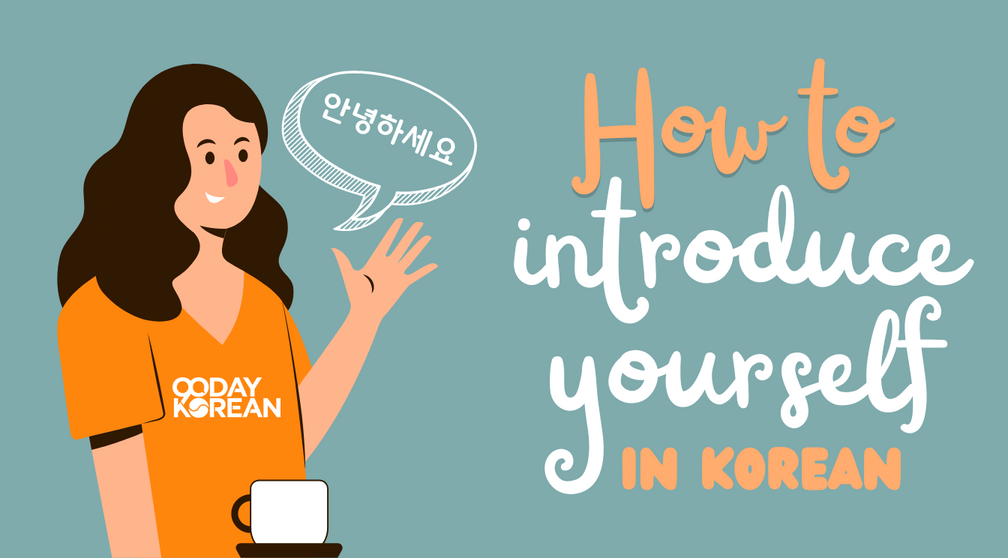
- 1.1 1. Greet them by saying 안녕하세요 (annyeonghaseyo).
- 1.2 2. Bow as you greet them.
- 1.3 3. If you shake hands, use your right hand or both hands.
- 1.4 4. Address them by their title or family name.
- 2.1 Basic Greetings in Korean
- 2.2 Introducing Your Age in Korean
- 2.3 Introducing Where You Are From in Korean
- 2.4 Introducing Your Occupation in Korean
- 3.1 List of Hobbies in Korean
Things to know when meeting new people in Korea
It’s good to go over a couple of points on the manners and culture in Korea first. This is extremely important if you’re in South Korea . After you’ve learned them, we’ll get started on how to introduce yourself in Korean ! These situations are also often portrayed on television, so you can see this in Korean drama .
1. Greet them by saying 안녕하세요 (annyeonghaseyo).
Before anything else, greet them by saying 안녕하세요 (annyeonghaseyo). It is important in Korean culture to be polite and show respect toward others. First impressions are everything.
2. Bow as you greet them.
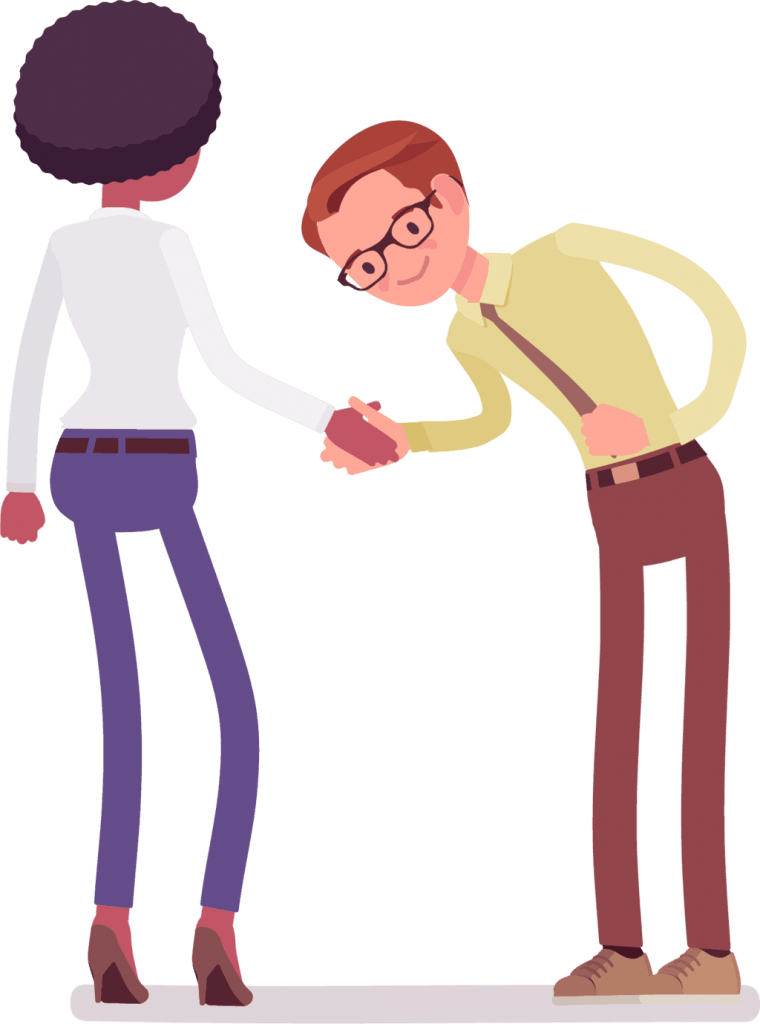
3. If you shake hands, use your right hand or both hands.
When you shake hands, use your right hand or both hands . You can show more respect by bowing and touching your left hand to your right or grabbing your stomach with your left hand.
4. Address them by their title or family name.
Koreans do not refer to each other by their first name unless they are close friends, and even then, they often go by “언니 (eonni),” “오빠 (oppa)” and so on .
When you are meeting a new person, use their title or family name unless they say otherwise .
How to introduce yourself in Korean
Now that we’ve gone through the important things to know when meeting a new friend in South Korea, let’s proceed with learning self-introduction in Korean. We will teach basic greetings, how to state your age and where you’re from your job , and the usual conversations people have when meeting for the first time .
You’ll also get to learn more about Korean grammar and more Korean words . When you greet people in Korean, they are likely to talk to you in Korean , and a Korean self-introduction script might come in handy!
You might know how to speak Korean, but if you don’t know how to read the Korean Alphabet, you can learn it here in about 1 hour.
Basic Greetings in Korean
As you learn Korean, how to greet someone is one of the first things that you’ll know, whether it’s from recognizing phrases in a Korean drama or as part of general language learning. The Korean phrases below are essential in introducing yourself in Korean and teaching the basics of what you can use, whether the standard or formal form or way to say them.
“Hello” in Korean
The most common way to greet someone you’ve met for the first time is by saying “hello.” Below is how you can say it in a standard way.
Our article on how to say “hello” in Korean shows different ways to say this greeting.
안녕하세요 (annyeonghaseyo)
“Nice to meet you” in Korean
When meeting someone for the first time, you can say, “It’s nice to meet you.” You can say it in a standard or a formal way.
We also have a separate article that teaches you how to say “nice to meet you” in Korean in many other ways.
처음 뵙겠습니다 (cheoeum boepgetseumnida)
It’s nice to meet you!
만나서 반갑습니다 (mannaseo bangapseumnida)
Your self-introduction in Korean
When introducing yourself to someone, you can simply state your name following the sample sentence below. The example shown is can be used in formal situations.
제 이름은 존 입니다. (je ireumeun jonimnida)
My name is John.
Introducing Your Age in Korean
Age makes a big difference in your interactions in Korea . You want to use a more formal version and polite language in introductions for people in a higher social position (your boss, your elders, etc.). You can use standard versions of the Korean language when you introduce yourself in Korean to those who are the same age or younger than you.
저는 스물네 살입니다 (jeoneun seumulle sarimnida)
I’m 24 years old.
저는 스물네 살이에요 (jeoneun seumulle sarieyo)
As you tell others your age, it’s best if you’re familiar with Korean numbers, and you should use the native Korean Number System. We have a complete guide for Korean numbers here . Here’s a quick refresher if you need it.
| English | Korean |
|---|---|
| ONE | |
| TWO | |
| THREE | |
| FOUR | |
| FIVE | |
| SIX | |
| SEVEN | |
| EIGHT | |
| NINE | |
| TEN |
Note that the Korean age is not the same as the international age. You can be up to two years older in Korean age.
Introducing Where You Are From in Korean
Something that will come up when you introduce yourself in Korean, your partner will probably want to know where you’re from .
저는 미국 에서 왔습니다 (jeoneun migugeseo watseumnida)
I am from the U.S .
저는 미국 에서 왔어요 (jeoneun migugeseo wasseoyo)
I am from the U.S.
Example Countries in Korean
You can fill in the blank with the country that applies to you . For more countries, you can check our post about how to say “country” in Korean .
| English | Korean |
|---|---|
| United States | |
| Canada | |
| United Kingdom | |
| Australia | |
| Thailand | |
| Germany |
Introducing Your Occupation in Korean
Work is important in Korean culture , and it’s likely to come up when you introduce yourself in Korean, either during your self-introduction or as a question after you finish.
저는 학생 입니다 (jeoneun haksaengimnida)
I am a student.
저는 모델 이에요 (jeoneun moderieyo)
I am a model.
저는 가수 예요 (jeoneun gasuyeyo)
I am a singer.
Example Occupations in Korean
Here are some examples of jobs and what they are called in Korean. You can use these with the sentences above to introduce yourself in Korean as well as to explain your occupation.
| English | Korean |
|---|---|
| Student | |
| Teacher | |
| Engineer | |
| Part-timer | |
| Web developer | |
| Nurse | |
| Singer | |
| Freelancer | |
| Hairdresser | |
| Salesperson | |
| Clerk | |
| Model |

Conversation topics when introducing yourself in Korean
After you introduce yourself in Korean and finish with the basic questions South Koreans will ask, you might want to introduce some other topics to keep the conversation going. Here are some basic sentences you can use.
저는 학원에서 한국어를 배웠습니다 (jeoneun hagwoneseo hangugeoreul baewotseumnida)
I learned Korean at the academy.
저는 혼자서 한국어를 공부했어요 (jeoneun honjaseo hangugeoreul gongbuhaesseoyo)
I studied Korean by myself.
저는 친구에게서 한국어를 배웠어요 (jeoneun chinguegeseo hangugeoreul baewosseoyo)
I learned Korean from my friend.
저는 서울 에서 살고 있습니다 (jeoneun seoureseo salgo itseumnida)
I live in Seoul.
저는 필리핀 에서 살고 있어요 (jeoneun pillipineseo salgo isseoyo)
I live in the Philippines.
제 취미는 러닝 이에요 (je chwimineun reoningieyo)
My hobby is running.
제 취미는 요리 예요 (je chwimineun yoriyeyo)
My hobby is cooking.
독서 는 제 취미 중 하나예요 (dokseoneun je chwimi jung hanayeyo)
Reading is one of my hobbies.
If you’d like to know more about constructing sentences in Korean, we have a full article on Korean sentence structure .
List of Hobbies in Korean
For more lists of hobbies and activities, you can check our separate article focused on hobbies in Korean and sports in Korean .
| English | Korean |
|---|---|
| Reading | |
| Cooking | |
| Hiking | |
| Soccer | |
| Basketball | |
| Baseball | |
| Listening to music | |
| Running | or |
Now you know how to introduce yourself to your new Korean friends or some native speakers in Korean! If you’re looking for more, check out our fantastic resources on learning Korean here . We also have a structured online Korean language web program that will teach you how to have a 3-minute conversation in the first 90 days.
Did you find today’s lesson on learning Korean useful? Practice introducing yourself in the comments, and we’ll reply with how you did!
Related Posts
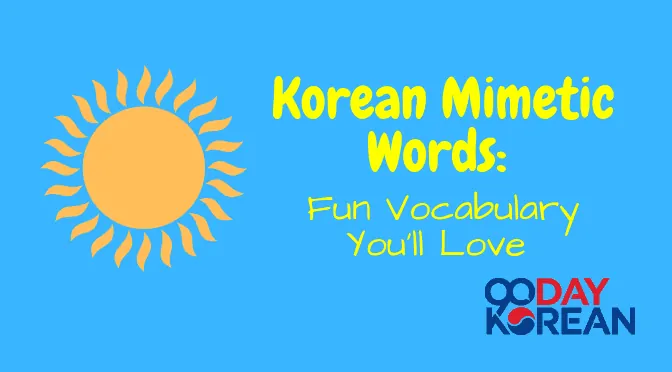
Korean Mimetic Words: Fun Vocabulary You’ll Love (의태어)
Last modified: Jun 25, 2024 | 5 min read | By 90 Day Korean
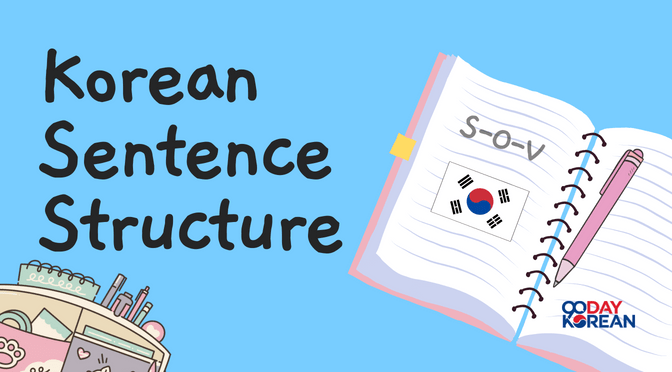
Korean Sentence Structure – Basic word order and patterns
Last modified: Jun 25, 2024 | 17 min read | By 90 Day Korean
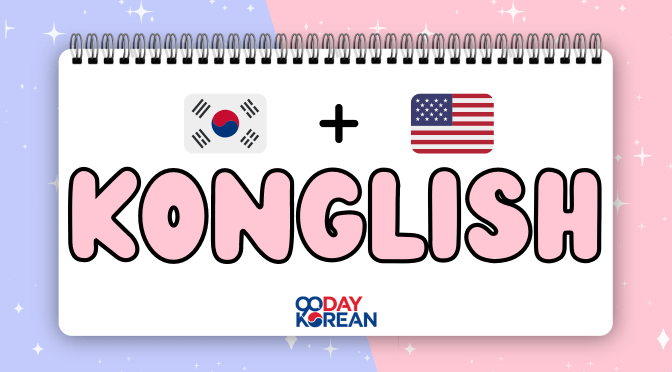
Konglish – Complete list of Korean loanwords for 2024
Last modified: Jun 25, 2024 | 8 min read | By 90 Day Korean
155 thoughts on “How to Introduce Yourself in Korean”
i am really thankful and gratufull for you guys now i can talk korean and write it thank you so much
Awesome! You’re welcome and thanks for sharing, Lee. ^^
Thanks for this! Sir, now I can have basic conversations and write in Korean! Could you please suggest more ways to sharpen my Korean?
You’re welcome, Jack! ^^ Glad to hear you’re learning Korean. To sharpen your Korean skills, you can check out our articles Korean conversation – Practice through dialogues and Korean Practice – How to effectively use your language skills .
Leave a Comment Cancel Reply
Your email address will not be published. Required fields are marked *
Choose your skill level and start getting fast results with your Korean:

Got any suggestions?
We want to hear from you! Send us a message and help improve Slidesgo
Top searches
Trending searches

5 templates
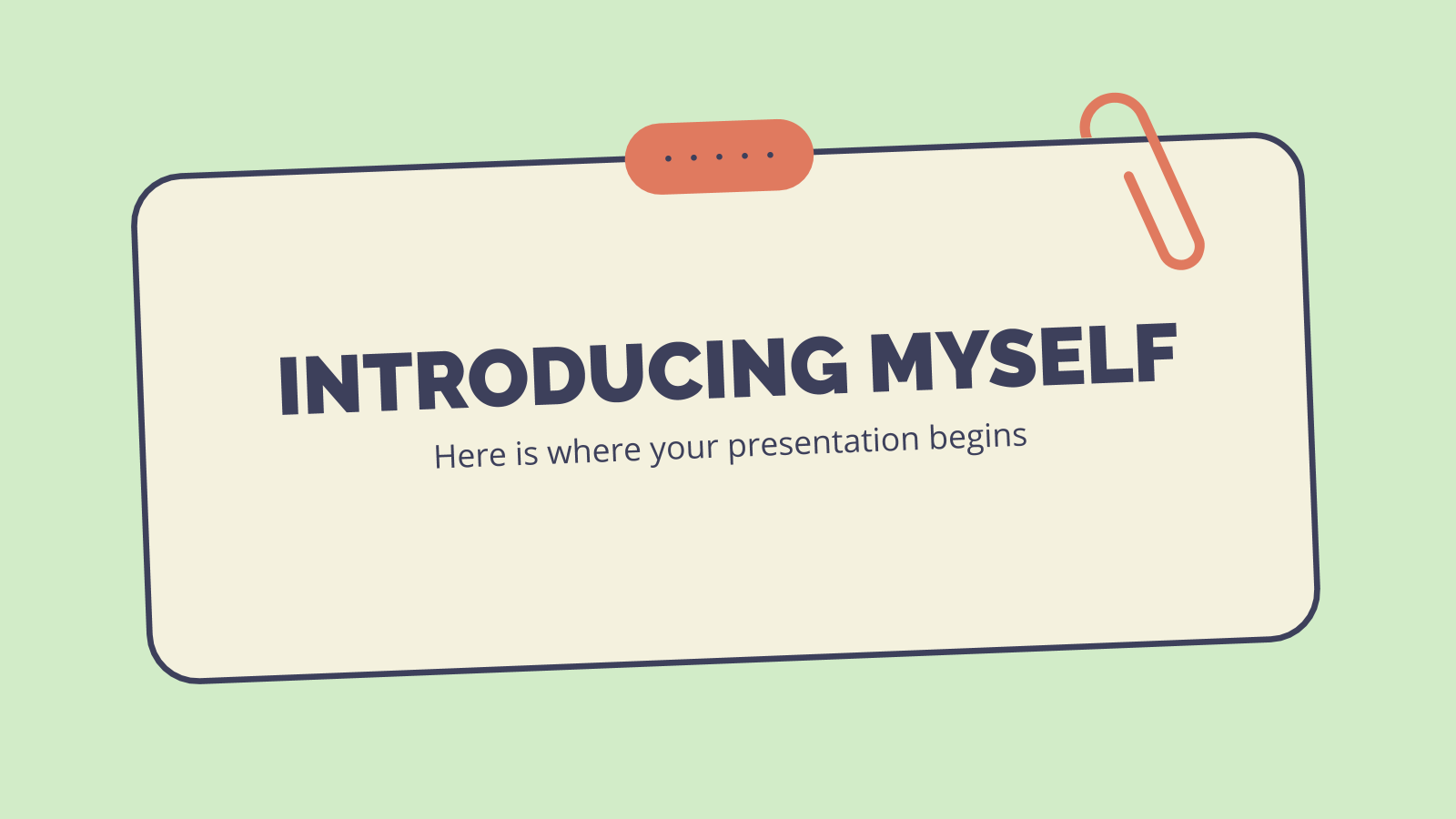
170 templates

education technology
258 templates

welcome back to school
111 templates

meet the teacher
30 templates

20 templates
Korean Language Lesson
It seems that you like this template, korean language lesson presentation, free google slides theme, powerpoint template, and canva presentation template.
From its 24 letters, including 14 consonants and 10 vowels, to its logical and efficient writing system, Hangul is truly a wonder of linguistic design. So, are you ready to dive into the fascinating world of Korean language and teach its unique alphabet, Hangul to everyone? Get ready to have some fun with this modern and colorful template for your next Korean Language Lesson! With pastel tones and slides full of resources like a map, a diagram, and much more, you'll have a blast exploring the beauty of this language.
Features of this template
- 100% editable and easy to modify
- 20 different slides to impress your audience
- Contains easy-to-edit graphics such as graphs, maps, tables, timelines and mockups
- Includes 500+ icons and Flaticon’s extension for customizing your slides
- Designed to be used in Google Slides, Canva, and Microsoft PowerPoint
- 16:9 widescreen format suitable for all types of screens
- Includes information about fonts, colors, and credits of the resources used
How can I use the template?
Am I free to use the templates?
How to attribute?
Attribution required If you are a free user, you must attribute Slidesgo by keeping the slide where the credits appear. How to attribute?
Related posts on our blog.

How to Add, Duplicate, Move, Delete or Hide Slides in Google Slides

How to Change Layouts in PowerPoint

How to Change the Slide Size in Google Slides
Related presentations.

Premium template
Unlock this template and gain unlimited access

- College Study Abroad
- College Study Abroad Blog
Top 20 Korean Slang Words and Phrases You Must Know
July 2, 2024

Programs for this blog post
Authored by:.

Are you worried about traveling to South Korea and feeling lost in conversation with locals, struggling to understand the Korean slang they're using? Don't worry; you're not alone. Just like any other language, Korean is full of slang expressions that might not be found in textbooks but are used commonly in everyday conversations.
Whether you're planning a study abroad adventure in South Korea or simply want to impress your Korean friends, mastering some Korean slang terms can take your language skills to the next level. Without further ado, let’s dig into the top 20 Korean slang words and phrases you need to know.
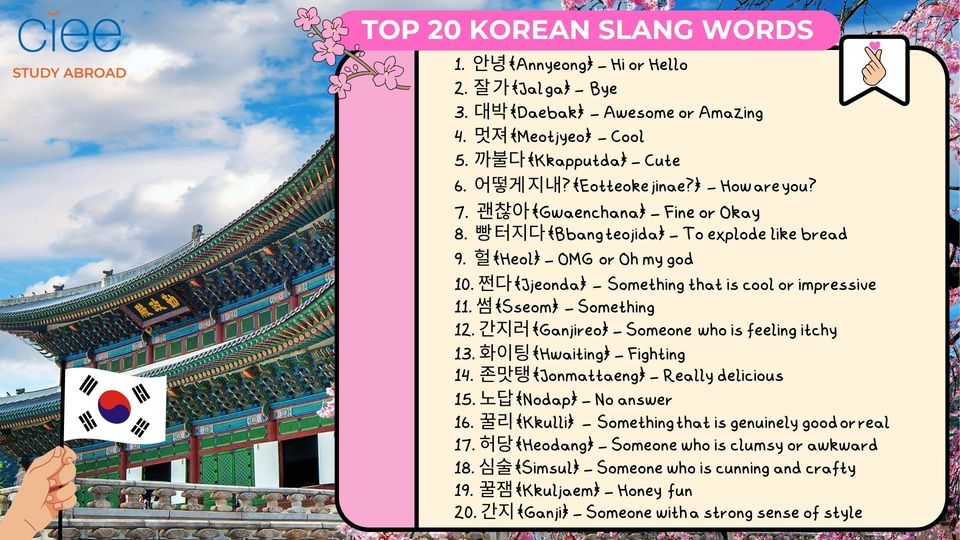
Read More: Study Abroad in South Korea: The Ultimate Guide
Top 20 Korean Slang Phrases and Words
Korean slang #1: 안녕 (annyeong) .
This is a casual way to say "hi" or “hello” in Korean slang. You'll hear it everywhere in Korea, from friends greeting each other on the street to shopkeepers welcoming customers into their stores.
Korean Slang #2: 잘 가 (Jal ga)
Since you know how to say “hi” in Korean slang, it only makes sense to learn how to say “bye” in Korean slang. "Jal ga" is a simple and commonly used way to do just that. It's informal and can be used to say goodbye to friends or people you're on familiar terms with.
Korean Slang #3: 대박 (Daebak)
Used to express excitement, “daebak” is how locals say “awesome” in Korean slang and “amazing” in Korean slang. If something is really impressive or surprising, Koreans might say it's "daebak."
Korean Slang #4:멋져 (Meotjyeo)
This word means "cool" in Korean slang and is often used to compliment someone or something. If you think someone's outfit or performance is great, you can say they're "meotjyeo."
Korean Slang #5: 까불다 (Kkapputda)
When you want to describe someone as cute in Korean slang, call them "kkapputda.” You might hear this term used to tease a friend who's being overly adorable or charming.
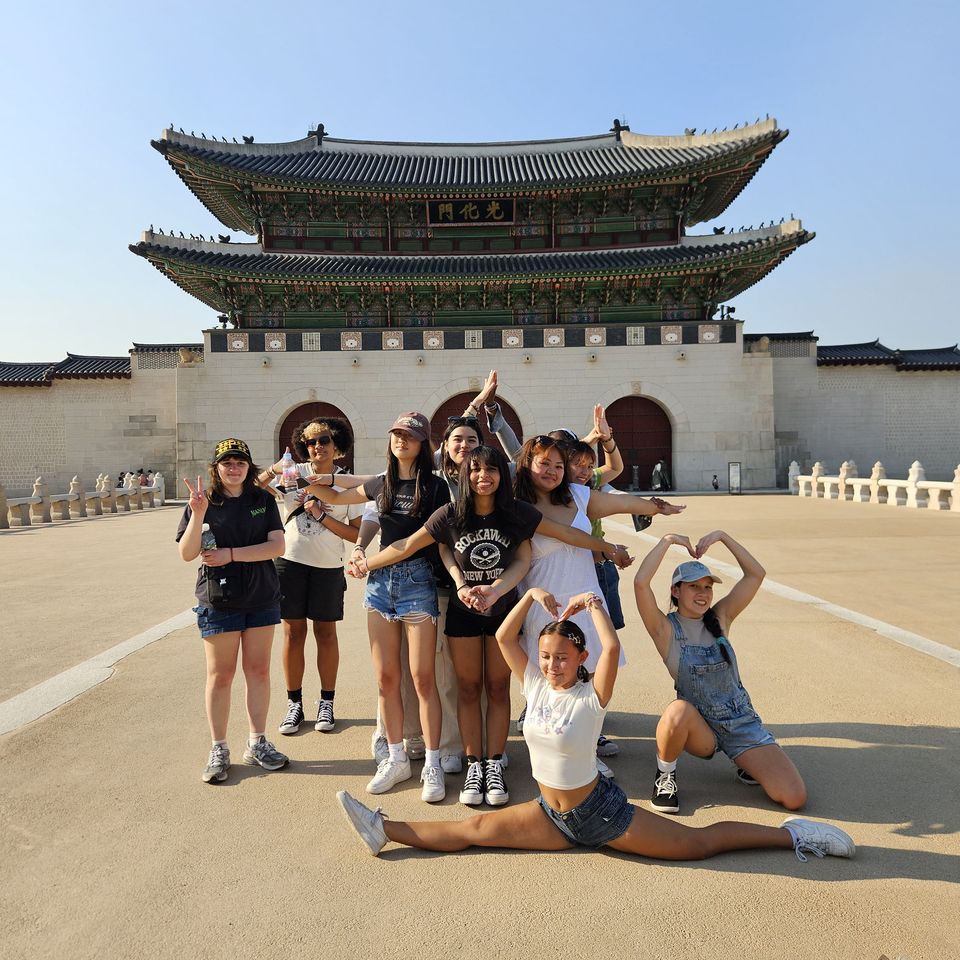
Korean Slang #6: 어떻게 지내? (Eotteoke jinae?)
To ask someone, “How are you?” in Korean slang, ask them, “Eotteoke jinae?” This phrase translates to "How are you doing?" or "How have you been?" It's a casual and friendly way to ask someone about their well-being.
Korean Slang #7: 괜찮아 (Gwaenchana)
A versatile term that means “fine” or "okay" in Korean slang is “gwaenchana.” It's commonly used in both formal and informal situations to indicate that everything is alright or acceptable.
Korean Slang #8: 빵 터지다 (Bbang teojida)
Literally meaning "to explode like bread," this expression is used to describe a situation that is unexpectedly funny or hilarious. If you find yourself laughing uncontrollably, say "bbang teojida."
Korean Slang #9: 헐 (Heol)
Similar to the English expression "OMG" or "oh my god," "heol" is a Korean slang term used to express surprise or disbelief. It's a versatile word that can be used in various situations.
Read More: Why Study Abroad in Seoul: Top 3 Reasons
Korean Slang #10: 쩐다 (Jjeonda)
This Korean slang word is used to describe something that is cool or impressive. If you see someone doing something awesome, you can say "jjeonda" to show your approval.
Korean Slang #11: 썸 (Sseom)
Short for "something," this term is used to describe the ambiguous stage between friendship and dating. If you're not sure if you're just friends or something more, you might say you're in a "sseom" with someone.
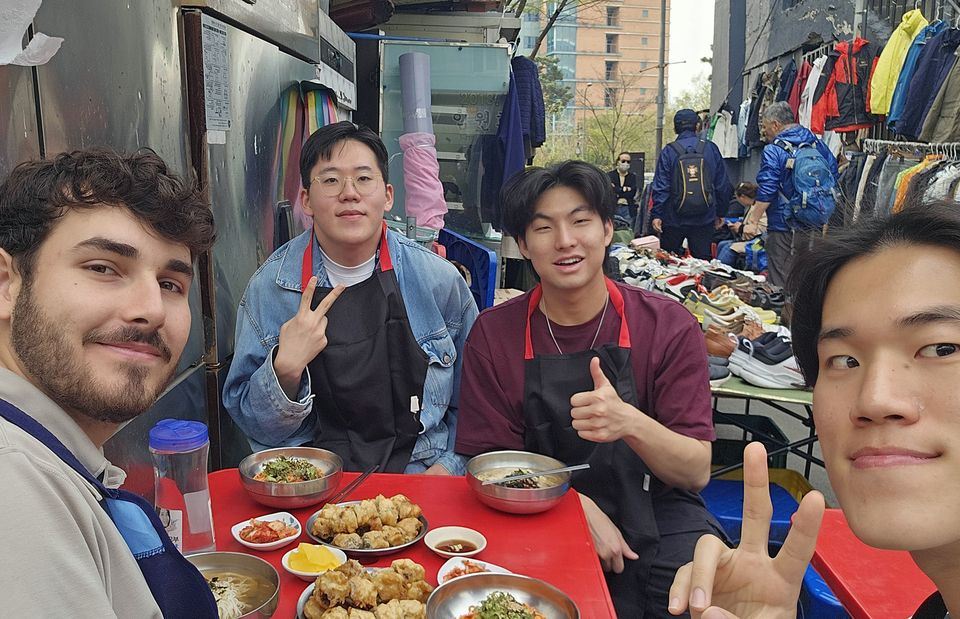
Korean Slang #12: 간지러 (Ganjireo)
This expression is used to describe someone who is feeling itchy, whether it's from a bug bite or just a general feeling of discomfort. If you're feeling restless or antsy, you can say you're "ganjireo."
Korean Slang #13: 화이팅 (Hwaiting)
Translating literally to “fighting” in Korean slang, this word can also be used in positive contexts to cheer someone on, wish them luck, or encourage them to do their best. It's similar to saying "you can do it" or "good luck" in American English and is commonly used before a performance or exam.
Korean Slang #14: 존맛탱 (Jonmattaeng)
This Korean slang term is a combination of 존나 ( “jonna,” meaning "really") and 맛탱 ( “mattaeng,” meaning "delicious"), so it directly translates to "really delicious." It's used to describe something extremely enjoyable or satisfying, like a great meal or experience.
Korean Slang #15: 노답 (Nodap)
노답 is short for "no answer" and is used to express frustration or disbelief at someone's foolish or nonsensical behavior or words. It's similar to saying "you've got to be kidding me" in English.
Korean Slang #16: 꿀리 (Kkulli)
꿀리 is a Korean slang term that combines 꿀 ( “kkul,” meaning "honey") and 리 ( “ri,” from the English word "real"). It's used to describe something that is genuinely good, real, or authentic, like a high-quality product or a sincere compliment.
Korean Slang #17: 허당 (Heodang)
This word describes someone who is clumsy or awkward, especially in social situations. If you're a bit of a klutz or tend to embarrass yourself easily, you might be called a "heodang."
Korean Slang #18: 심술 (Simsul)
Referring to someone who is cunning or crafty, this Korean slang term is used in the context of someone who behaves in a playful or mischievous way. If you're good at pulling pranks or teasing your friends, you might be accused of having "simsul."
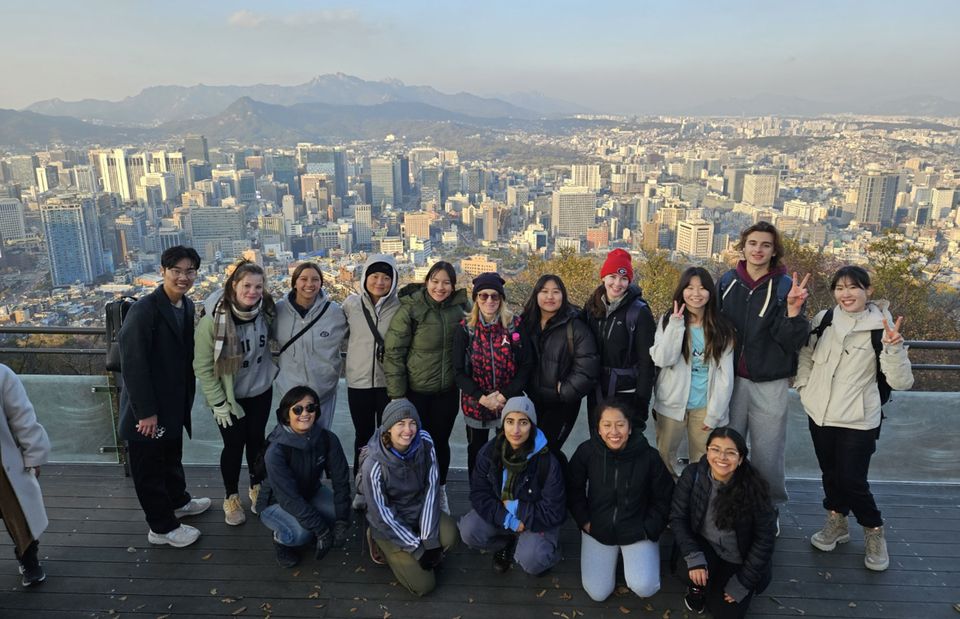
Read More: Best Study Abroad Programs in Seoul
Korean Slang #19: 꿀잼 (Kkuljaem)
This Korean slang word is short for "honey fun" and is typically used to describe something that is incredibly fun or enjoyable. If you have a great time at a party or watching a movie, you can say it was "kkuljaem."
Korean Slang #20: 간지 (Ganji)
This Korean slang word describes someone who has a strong sense of style or charisma. If someone is fashionable and confident, you might say they have "ganji."
Put Your Korean Slangs to Use
There you have it: The top 20 slang Korean words and phrases you need to know to navigate conversations in South Korea like a pro. Whether you're chatting with friends or exploring the streets of Seoul , mastering these Korean slang expressions will help you connect with native speakers and immerse yourself in Korean culture.
So go ahead, practice your Korean slang, and get ready to impress everyone with your language skills on an epic study abroad journey!
EXPLORE SOUTH KOREA STUDY ABROAD
- Activities & Excursions
- Foreign Language
- South Korea
Related Posts
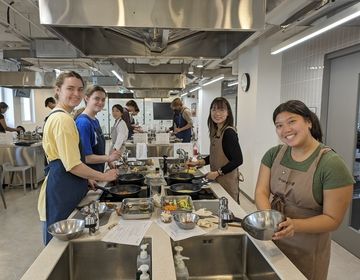
Enjoying the Bounty of Spring
While Korea has a wide range of foods available all year, spring brings delicious greens and is one of the best seasons to enjoy vegetarian temple cuisine.
- Eat, Drink, Explore
- Food & Drink

Study Abroad in South Korea: The Ultimate Guide
Known officially as the Republic of Korea, South Korea is brimming with exciting excursions and educational opportunities – not to mention an incredible food and culture scene! It’s no wonder... keep reading


Top 5 Places to Study Abroad in the Asia-Pacific Region
@cieestudyabroad Top places to study abroad in the Asia-Pacific region! #cieestudyabroad #ciee #studyabroad #asia #australia #china #taiwan #singapore #southkorea #japan #kyoto #tokyo #seoul #taipei #beijing #shanghai #sydneyaustralia #sydney Dance You... keep reading
- Communications
- Planning/Packing
- Scholarships
© 2024 CIEE. All Rights Reserved.
- Privacy Notice
- Terms & Conditions
- Influencers
- Health & Fitness
- Love & Relationships
- Herbalistics
- Entertainment
- Conscious Travel
- Trusted Travel
- Luxury Travel
- Real Estate
- HMG Creative Agency
- Work With Us

Essential Korean Phrases for Your First Conversation
Setting out on an excursion to gain proficiency with another language can be both energizing and testing. If you’re wandering into the universe of Korean, whether for movement, business, or individual improvement, dominating a couple of fundamental phrases can make your most memorable discussion much smoother and more pleasant. Korean is an exceptional language with its arrangement of rules and articulations, however, dread not – we’ve incorporated a rundown of must-know phrases to assist you with loosening things up and exploring your underlying communications.These phrases can also be learn by a professional and experienced Korean tutor .
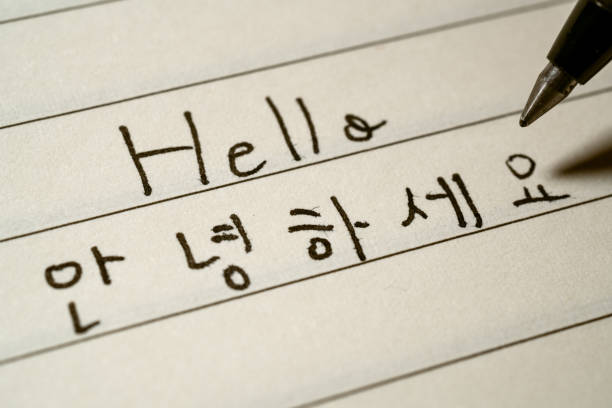
안녕하세요 (Annyeonghaseyo) – Hello
The underpinning of any conversation, “안녕하세요” is the standard welcome in Korean. Whether you’re going into a room, meeting somebody interestingly, or picking up the telephone, this flexible expression establishes a cordial vibe.
네 (Ne) – Yes/아니요 (Aniyo) – No
Clear correspondence frequently begins with a basic “yes” or “no.” “네” is a positive response, while “아니요” is a negative one. Dominating these two words will assist you in exploring different circumstances effortlessly.
감사합니다 (Gamsahamnida) – Bless your heart
Offering thanks is fundamental in any culture, and Koreans value respectfulness. Use “감사합니다” to convey your much obliged, whether you’re getting some help, a gift, or a commendation.
실례합니다 (Silryehamnida) – Excuse me/Please accept my apologies
In jam-packed spaces or while looking for somebody’s consideration, “실례합니다” can be your go-to state. Moreover, it serves as a statement of regret, making it a flexible articulation for different circumstances.
뭐에요? (Mwoeyo?) – What’s happening here?
Ideal for looking for an explanation or getting some information about something you don’t have the foggiest idea, “뭐에요?” is a convenient expression to keep in your semantic tool stash.
이름이 뭐에요? (Ireumi Mwoeyo?) – What is your name?
While meeting somebody interestingly, communicating interest in their name is a courteous method for beginning a discussion. Make sure to answer with your name when they respond.
반갑습니다 (Bangapseumnida) – Ideal to meet you
Building compatibility starts with a warm presentation. “반갑습니다” is a well-disposed method for communicating joy at meeting somebody interestingly.
어디에요? (Eodieyo?) – Where could it be?
Whether you’re searching for a specific area, a café, or a bathroom, “어디에요?” will prove to be useful. Make certain to enhance it with a particular spot or thing to get the data you want.
얼마에요? (Eolmaeyo?) – How much is it?
Exploring markets and shops turns out to be a lot more straightforward when you can get some information about costs. “얼마에요?” is your pass to grasping the expense of labour and products.
잠시만요 (Jamsimanyo) – One minute, please
In a quick-moving world, at times you want a second. Use “잠시만요” when you require a brief pause or while you’re dealing with something rapidly.
Mastering these fundamental Korean phrases gives a strong groundwork for your most memorable discussion in the language. Language isn’t just a gadget for correspondence; an expansion interfaces people and social orders. As you pass on your outing to learn Korean, recall that attempting to convey in the local language extends respect and a genuine interest in the lifestyle. In this way, go on, practice these phrases, and partake in the advancing experience of drawing in with Korean speakers in their local language. Who knows, your freshly discovered language abilities could open ways to fellowships, valuable open doors, and a more profound comprehension of this energetic and captivating society
Published by HOLR Magazine.
Subscribe to HOLR Magazine
Comments are closed.

I verify that I am of age to view cannabis related content in my region.
500+ Basic Words And Phrases In Korean: Useful List
- , September 7, 2023
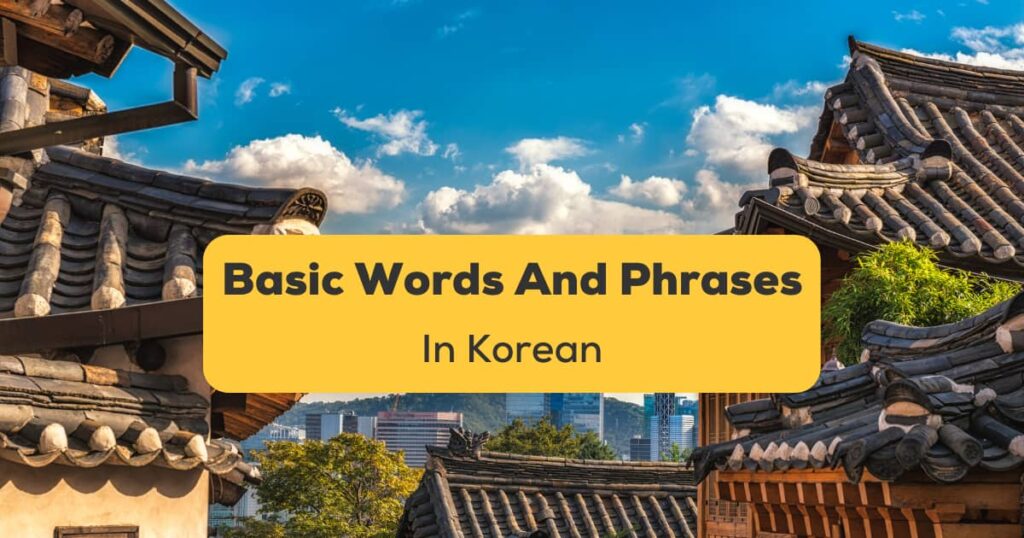
Basic words and phrases in the Korean language (한국어 / hangugeo) can be easily learned nowadays. It is one of the most popular languages among southeast Asian countries because of the prevalence of Korean culture through Korean popular posts, Korean drama/movies, Korean music, and even Korean food.
People have different reasons why they want to learn this language and many people want to learn Korean to expand their vocabulary and understand how their favorite Korean actors and Kpop biases speak. Whatever the reason is, it is undeniable that the Korean language has taken a big step to know not just in Asia but all over the world.
Today, there are lots of people who speak English as their second language because it has been widely used all over the world, but learning to speak Korean will definitely step up your game. It will widen your vocabulary and give you a deeper understanding of Koreans. So, are you ready to learn new Korean words and Korean phrases? Let’s go! (가자! / gaja!)
Page Contents
What Are The Top 10 Basic Words In Korean?
Other basic korean phrases and words you should learn.
- A List Of 365 Common Korean Words To Improve Your Vocabulary
Korean Language That Reflects Korean Culture
About the korean language, start learning korean now.
If you are wondering which essential Korean words you should learn first, have a look at the list below:
- Yes : 네 (ne) / 예 ( ye )
- No : 아니오 ( a-ni-yo )
- Okay : 괜찮아요 ( gwaen-chan-a-yo )
- Hello : 안녕하세요 ( an-nyeong-ha-se-yo )
- Please (for requests): 주세요 ( ju-se-yo )
- Thank you : 감사합니다 ( gam-sa-ham-ni-da ) / 고마워요 ( go-ma-wo-yo )
- You’re welcome : 천만에요 ( cheon-man-e-yo )
- Excuse me : 실례합니다 ( sil-lye-ham-ni-da )
- Sorry : 미안합니다 ( mi-an-ham-ni-da ) / 미안해 ( mi-an-he )
- Goodbye : 안녕히 계세요 ( an-nyeong-hi-gye-se-yo )
Meanings And Sounds Of The Basic Words And Phrases in Korean You Should Lean
There is a special reason why people want to learn Korean words and Korean phrases. It can be because they are inspired by the Korean music, Korean books or Korean dramas they are listening to and watching.
It may also be a requirement for an elective subject in school. Most of all, people want to start learning Korean because they want to travel to Korea and start conversations with locals.
Whatever the reason is, it is really commendable for you to start learning Korean, so here’s a list of Basic Words and Phrases in Korean for you to start with:
English Translation: Yes
네 ( ne ) is used the same way it is used in the English language. As a traveler, this is really essential, especially in airports, shopping, dining, and traveling around the country. You can also hear people say 예 ( ye ) to say “Yes” in Korean, which has the same meaning as 네(ne). But in some cases, older people might consider 예 ( ye ) a more polite way to say “Yes.”
2. 아니요 (a-ni-yo)
English Translation: No
No is also one of the basic but most important words to learn in Korean. It is as important as the word Yes because you will not say Yes all the time.
On the other hand, when you are in doubt or unsure about something, 아마도 / amado is the right word for you. Of course, there will be a lot of things that you won’t be so sure about when you begin to learn Korean.
3. 괜찮아요 (gwaen-chan-a-yo)
English Translation: Ok
The common way of agreeing is saying Ok (괜찮아요 / gwaenchanayo ). This is just a word, but it is really important and useful in many different situations.
4. 안녕하세요 (an-nyeong-ha-se-yo)
English Translation: Hello
안녕하세요 ( annyeonghaseyo ) is one of the most common words in the Korean language you will hear anywhere. Koreans love to welcome people with a greeting. This is the easiest Korean greeting that you can use in many situations. This is also a great conversation starter and icebreaker when communicating with the locals.
5. 주세요 ( ju-se-yo )
English Translation: Please
Koreans really value respect and politeness. It is clearly reflected in Koreans when you go to their country or even just watch their movies and dramas that is why the word Please (주세요 / juseyo) is used often. As a traveler, this is important to show politeness to the locals in different situations, such as dining in a restaurant and shopping.
6. 감사합니다 ( gam-sa-ham-ni-da )
English Translation: Thank you
Saying Thank you(감사합니다 / gamsahamnida ) in Korean is really important, especially when you visit Korea. 감사합니다 ( gamsahamnida) is used in formal conversations, and you could also hear 고마워요 ( gomawoyo ), which is used in casual conversations. This is also a common Korean phrase or expression that is really important in daily conversations.
We all know that saying Thank you is a sign of showing appreciation and gratitude to another person, which is very important in Koreans. There are a lot more Korean phrases that you can use to say Thank you, but this is the most common one you can use in both speaking and writing.
7. 천만에요 (cheon-man-e-yo)
English Translation: You’re welcome
You should also know how to respond when somebody expresses gratitude to you by simply just saying You’re welcome (천만에요 / cheonmaneyo ) in Korean. This is also a sign of politeness toward other people. Korean phrases like this are really important to keep the conversation going and be nice.
8. 실례합니다 ( sil-lye-ham-ni-da )
English Translation: Excuse me
There will also be times when you need to use the phrase Excuse me (실례합니다 / sillyehamnida ). This phrase is used to apologize, but there are different usages for this phrase. One example is 저기요 ( jeogiyo) , which is used to get attention. Another example is 잠시만요 ( jamsimanyo), which is used to pass someone.
9. 미안합니다 ( mi-an-ham-ni-da )
English Translation: Sorry
Both Korean phrases have the same meaning, but they are used in different situations. 미안합니다 / (mianhamnida) is formal, and you could also hear 미안해 (mianhe), which is more casual. Saying sorry is a sign of humility and respect.
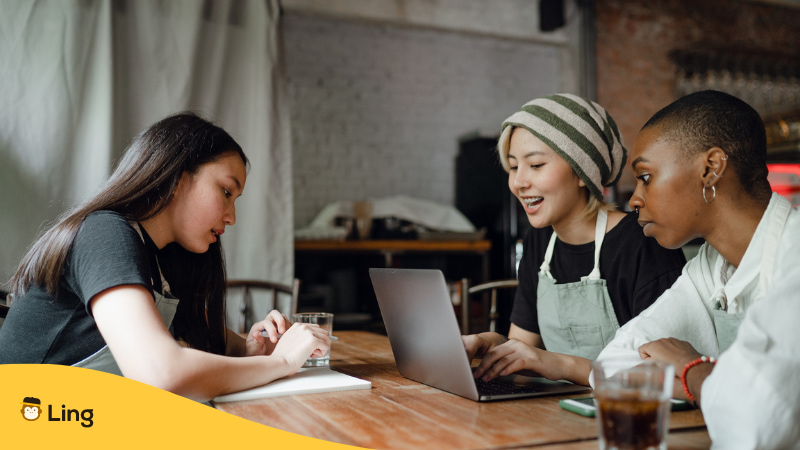
10. 안녕히 계세요 (an-nyeong-hi-gye-se-yo)
English Translation: Goodbye
Knowing how to say Goodbye (안녕히 계세요 / annyeonghi gyeseyo ) in Korean is also important, especially if you are a tourist. It is one of the most common Korean greetings, which is mostly used in daily conversations.
These 10 basic words and phrases in the Korean language are just the simplest and easiest that you can learn. As a person who doesn’t know how to speak Korean, these phrases and words are a good starting point in your journey in language learning. For people who speak English, learning Korean may be challenging, especially in written form, since it is complicated. But with a lot of practice and continuous reading of blogs like this, you will surely learn little by little.
Speaking Korean will require you to learn more vocabulary other than the 10 mentioned above. Now that you have learned the 10 basic words and phrases in the Korean language let us learn more. Take note, we are only learning the basic words, phrases, and sentences, there are separate blog posts for other topics as well. Here is a list of additional Korean phrases and words to learn in different categories:
1. For Everyday Life Conversations
There are plenty of Korean phrases and vocabulary that are commonly used in everyday conversation. There are Koreans who speak English, but there are also those who don’t. Learning basic words and phrases in the Korean language, as well as sentences, will make it easier when you are talking to the locals. Here is a list of words and phrases that are used in everyday life:
| English Translation | Korean | Pronunciation |
|---|---|---|
| Good | 좋아요 | |
| Bad | 안 좋아요 | |
| That’s ok | 괜찮아요 | |
| Just a moment! | 잠깐만요! | |
| I understand | 이해해요 | |
| I don’t know | 몰라요 | |
| I know | 알아요 | |
| Don’t worry! | 걱정 하지 마세요! | |
| No problem! | 문제 없어요 | |
| What is this? | 이게 뭐예요 | |
| My name is … | 제 이름은 … 입니다 | |
| It is nice to meet you! | 만나서 반가워요 | |
| Do you speak English? | 영어 하실 줄 아세요? | ? |
| Do you speak Korean? | 한국말 하실 줄 아세요? | |
| I can speak a little Korean | 한국말을 조금 할 수 있어요 | |
| I can’t speak Korean | 한국말을 못해요 |

2. Korean Words For Shopping
Shopping is part of a great adventure in Korea. Even if you don’t plan to go to Korea, there may be times when you want to buy something in a Korean store. One of the reasons why people admire Koreans is the products they use in everyday life. Here are some words that may help your shopping experience easier:
| English Translation | Korean | Pronunciation |
|---|---|---|
| shopping | 쇼핑 | |
| How much is this? | 이거 얼마예요? | |
| Can I pay with a credit card? | 카드 돼요? | |
| What time do you close? | 몇시에 문 닫아요? | |
| Please give me a discount | 좀 깎아 주세요 | |
| Please give me a receipt | 영수증 주세요 | |
| Please give me a refund | 환불해 주세요 | |
| How much is the total? | 모두 얼마예요? |
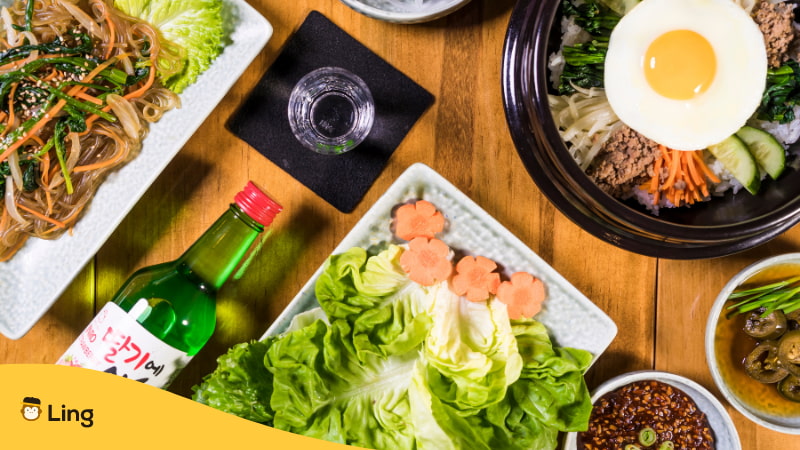
3. Basic Korean Words And Phrases About Food And Dining
Another reason why people love Korean culture is because of their food. If you want to eat in local restaurants or if someone invited you for a meal, these are some phrases you need to know as a beginner. Take note of the pronunciation of these Basic words and phrases in the Korean language because it is really important.
| English Translation | Korean | Pronunciation |
|---|---|---|
| Bon appétit | 맛있게 드세요 | |
| Eat up! | 많이 먹어요 | |
| It’s delicious! | 맛있어요! | |
| I’m thirsty | 목 말라요 | |
| I want to drink | 마시고 싶어 | |
| It doesn’t taste good | 맛없어요 | |
| I’m hungry | 배고파요 | |
| Please give me a menu | 메뉴판 주세요 | |
| Do you have vegetarian dishes? | 채식주의자용 식사 있어요? |

4. Essential Phrases About Travel And Directions In Korean
Traveling is really hard if it is your first time, and it is even harder when you don’t know how to speak their native language. Even if you are with your friends and you only know how to speak English, traveling will be hard for all of you. If you decide to Korea, try learning the following phrases that the native speakers use:
| English Translation | Korean | Pronunciation |
|---|---|---|
| Turn left | 왼쪽으로 가세요 | |
| Turn right | 오른쪽으로 가세요 | |
| Go straight | 직진하세요 | jikjinhaseyo |
| I’m lost | 길을 잃었어요 | |
| How far is it from here? | 여기에서 얼마나 걸리는지 아세요? | |
| How much is the bus fare? | 버스 요금 얼마예요? | |
| Where does this bus go? | 이 버스는 어디로 가요? | |
| How much is a bus ticket to Seoul? | 서울에 가는 버스 표가 얼마예요? | |
| I’m sorry, I’m not from around here | 미안하지만 저는 이 근처 사람이 아니예요 |

5. Korean Phases About Clarification
Being a non-native speaker will really give you a hard time understanding conversations and interactions. So, it’s nice to learn some basic words and phrases in the Korean language that you can use to make things clear. Surely, Koreans will be kind enough to clarify things for you.
| English Translation | Korean | Pronunciation |
|---|---|---|
| Please say that one more time. | 다시 한 번 말해 주세요 | |
| Please speak slowly. | 천천히 말해 주세요 | |
| I don’t understand | 이해 못했어요 |
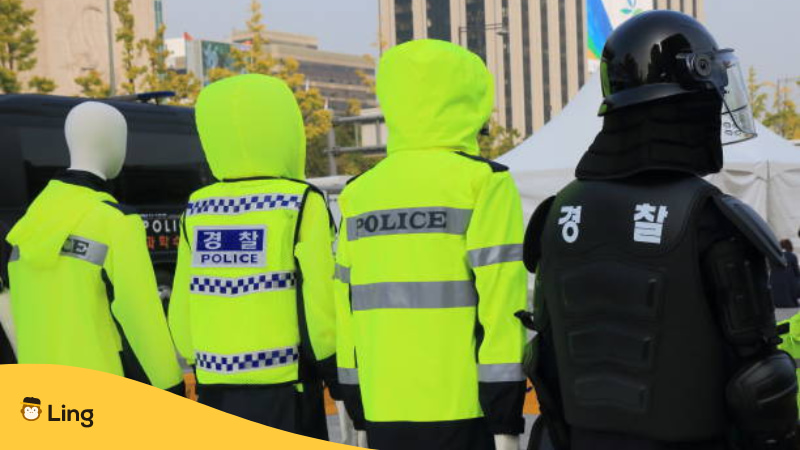
6. Words And Phrases About Emergency In Korean
Emergencies can happen anytime and anywhere. You never know when and where it will happen. You may feel comfortable if you always have a doctor like Kang Mo-Yeon (in Descendants of the Sun) or a responsive police officer like Choi Eun-Cheol (in Hometown Cha-cha-cha) by your side. But, if you don’t have people like them at all times, you must learn some basic words and phrases in Korean to be used for emergencies like the following:
| Korean | Pronunciation | |
|---|---|---|
| emergency | 비상 | bisang |
| police | 경찰 | gyeongchal |
| It’s my emergency phone number | 비상 전화번호예요 | bisang jeonhwabeonhoyeyo |
| Fire! | 불이야 | buriya |
| Be careful. | 조심하세요! | josimhaseyo! |
| I’m scared. | 무서워요 | museowoyo |
| Help me! | 도와주세요! | dowajuseyo! |
| Call the police, please. | 경찰을 불러 주세요 | Gyeongchareul bulleo juseyo. |
| Call an ambulance! | 구급차 불러요! | gugeupcha bulleoyo! |
| Someone has stolen my bag. | 누군가 제 가방을 훔쳐갔어요 | nugun-ga je gabangeul humchyeogasseoyo |
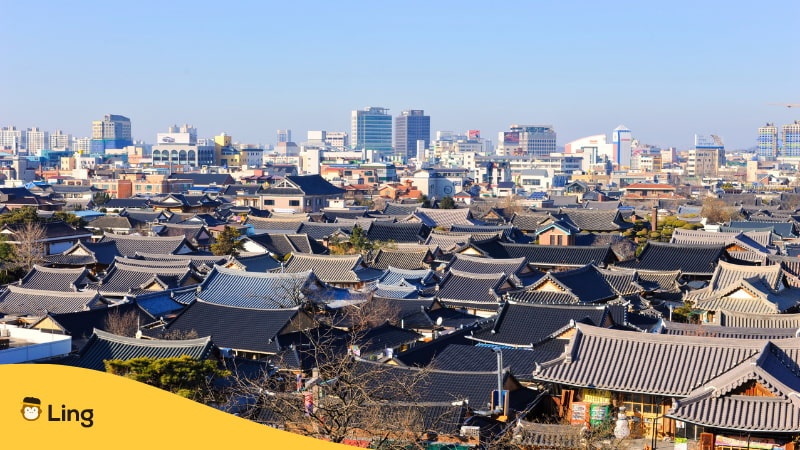
7. Korean Phrases About Accommodation
Going to a place as wonderful as South Korea will bring you different sorts of adventures which can be tiring but fulfilling. One of the first things you’ll do when you arrive in Korea is to look for accommodation that is really budget-friendly but can still give you the Korean cultural experience. Learn these basic words and phrases in the Korean language that are related to accommodation to have smooth transactions.
| English Translation | Korean | |
|---|---|---|
| a hotel | 호텔 | hotel |
| a room key | 방 열쇠 | bang yeolsoe |
| to reserve | 예약하다 | yeyakada |
| a single room | 싱글룸 | singgeullum |
| check-in | 체크인 | chekeuin |
| check-out | 체크아웃 | chekeuaut |
| We want to stay here for two nights. | 우리는 여기에서 이틀 밤을 머물고 싶어요 | urineun yeogieseo iteul bameul meomulgo sipeoyo |
| I want to reserve two rooms for four people. | 나는 4(네)명의 사람들을 위해 방 2(두)개를 예약하고 싶어요 | naneun 4(ne)myeongui saramdeureul wihae bang 2(du)gaereul yeyakago sipeoyo |
| I want to reserve a single room for one night. | 나는 하룻밤 묵을 싱글룸을 예약하고 싶어요 | naneun harutbam mugeul singgeullumeul yeyakago sipeoyo |
| Can I leave my room key at reception? | 제 방 열쇠를 안내 데스크에 맡겨도 되나요? | je bang yeolsoereul annae deseukeue matgyeo-do doenayo? |
| Does the hotel provide Internet? | 그 호텔은 인터넷을 제공하나요? | geu hotereun inteoneseul jegonghanayo? |
| I want to rest in my room. | 나는 내 방에서 쉬고 싶어요 | naneun nae bangeseo swigo sipeoyo |
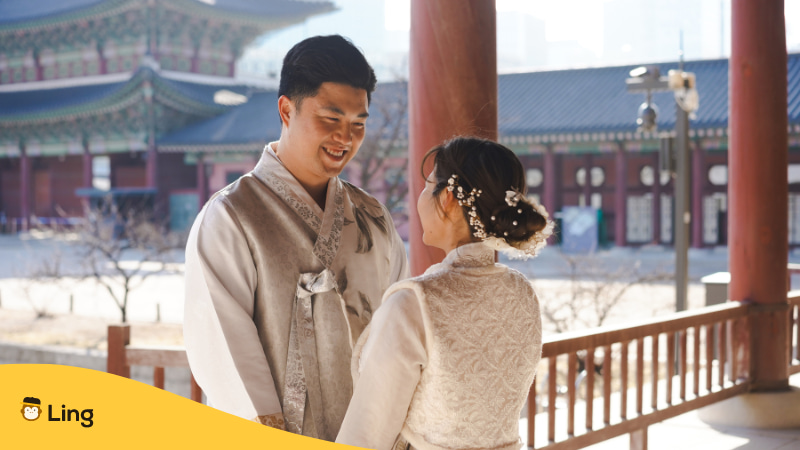
8. Korean Words And Phrases Related To Love And Relationships
We cannot talk about basic words and phrases in the Korean language without some love and relationship phrases. After all, I bet one of the reasons why you’re here is because of your favorite Oppa and bias. And hey, pretty sure that the K-dramas never failed to make you fall in love or believe in true love, even in mermaids like “Legend of the Blue Sea” and aliens like “My Love from the Star.”
Falling in love with Koreans is not hard because, let’s admit it, what’s not to love about them? So, here are some basic words related to love and relationships:
| English Translation | Korean | Pronunciation |
|---|---|---|
| love | 사랑 | sarang |
| kiss | 키스 | kiseu |
| date | 데이트 | de-i-teu |
| friend | 친구 | chin-gu |
| boyfriend | 남자친구 | namja-chin-gu |
| girlfriend | 여자친구 | yeoja-chin-gu |
| I miss you. | 보고 싶어 | bogo sipeo |
| I love you. | 사랑해 | saranghae |
| I like you. | 좋아해 | joahae |
| I’ve got a crush on you. | 나는 너에게 반했어 | naneun neo-ege banhaesseo |
| I want to see you. | 만나고 싶어 | mannago sipeo |
| I’m yours | 나는 니꺼야 | naneun nikkeoya |
| You are pretty! | 예쁘네요! | yeppeuneyo! |
| You are so cute! | 너무 귀여워요! | neomu gwiyeowoyo! |
| You are so sweet! | 정말 친절하네요! | jeongmal chinjeolhaneyo! |
| It was love at first sight. | 첫눈에 반했어 | cheonnune banhaesseo |
| You mean so much to me. | 당신은 나에게 무척 소중해요 | dangsineun naege mucheok sojunghaeyo |
| Do you still not have a boyfriend? | 아직도 남자친구가 없어요? | ajikdo namjachinguga eopseoyo? |
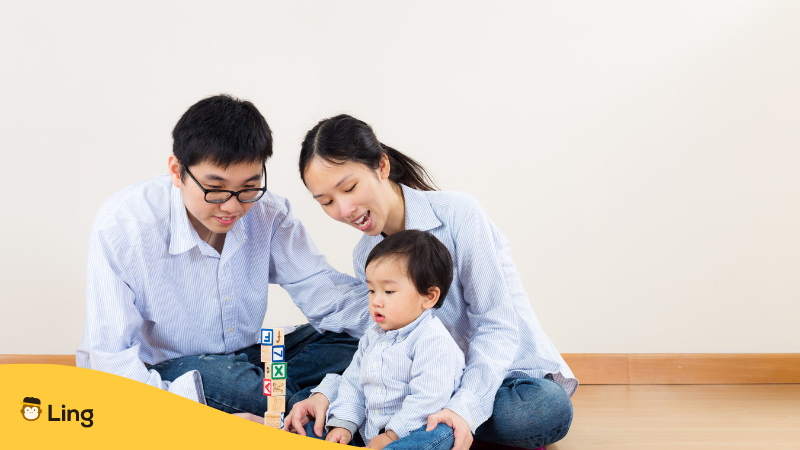
9. Basic Words For Family In The Korean Language
Guided by the teachings of Confucianism, Korean families strictly value filial piety and respect for elders. Koreans are known to be family-oriented people. Family members are extremely devoted to one another. It is well-reflected in their K-dramas like “Reply 1988”. If you watched this K-drama, you could see the Korean culture in terms of family. Elders are well-respected. Parents are responsible for molding their children to be good and responsible citizens by providing them with education and teaching them Korean culture. Children are supposed to be obedient and respectful to their parents and pursue education to become successful in the future.
Here are some words and phrases related to the family that you should learn as a beginner:
| English Translation | Korean | Pronunciation |
|---|---|---|
| dad | 아빠 | appa |
| mom | 엄마 | eomma |
| son | 아들 | adeul |
| daughter | 딸 | ttal |
| grandfather (paternal) | 할아버지 | harabeoji |
| grandfather (maternal) | 외할아버지 | oe harabeoji |
| grandmother (paternal) | 할머니 | halmeoni |
| grandmother (maternal) | 외할머니 | oe halmeoni |
| husband | 남편 | nampyeon |
| wife | 아내 | anae |
| I go on a trip with my family | 가족들과 함께 여행을 가요 | gajokdeulgwa hamkke yeohaengeul gayo |
| We are a family of five | 우리 가족은 5(다섯)명이에요 | uri gajogeun 5(daseot) myeongieyo |
| My dad is kind | 우리 아빠는 친절하세요 | uri appaneyb chinjeolhaseyo |

10. Korean Verbs And Adjectives
Verbs and adjectives are essential parts of the sentence structure. If you know the basic verbs and adjectives, it will be easier for you to understand and write sentences in Korean. Remember, the Korean language is meant to be learned and understood easily. At first, it seems like it’s hard to learn, especially if you’re from a western country, but after learning the Korean alphabet, you’ll realize that it’s not hard to learn Korean. Here are some basic verbs and adjectives you’ll need to know.
| English Translation | Korean | Pronunciation |
|---|---|---|
| to eat | 먹다 | meokda |
| to drink | 마시다 | masida |
| to sleep | 자다 | jada |
| to give | 주다 | juda |
| to buy | 사다 | sada |
| to see | 보다 | boda |
| to laugh | 웃다 | utda |
| to cry | 울다 | ulda |
| to wear | 입다 | ipda |
| to walk | 걷다 | geotda |
| to meet | 만나다 | mannada |
| to study | 공부하다 | gongbuhada |
| to learn | 배우다 | baeuda |
| to read | 읽다 | iktta |
| to be good | 좋다 | jota |
| to hate | 싫다 | silta |
| to be easy | 쉽다 | swipda |
| to be difficult | 어렵다 | eoryeopda |
| to be clean | 깨끗하다 | kkaekkeuthada |
| to be dirty | 더럽다 | deoreopda |
| to be interesting | 재미있다 | jaemiitda |
| to be boring | 재미없다 | jaemieopda |
| to be hot | 덥다 | deopda |
| to be cold | 춥다 | chupda |
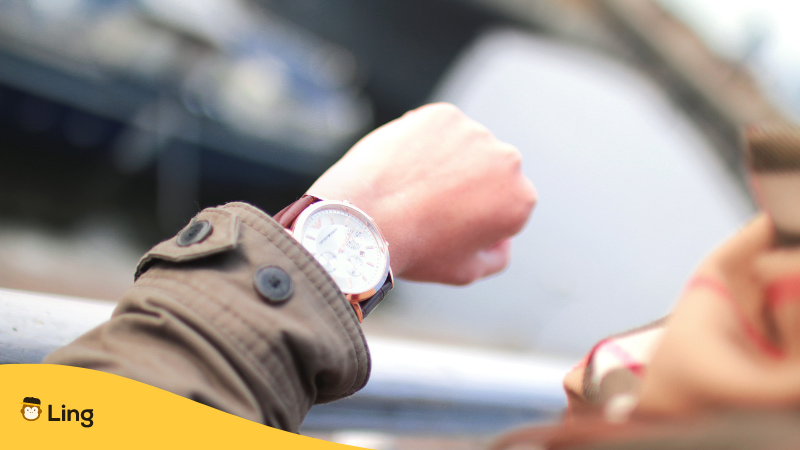
11. Words About Time In Korean
One thing to learn about Koreans is they are really organized. Everything is fast-paced to keep productivity but remember, fast-paced doesn’t always compromise quality. They still care about details and quality of work. If you’re following a K-pop group, they spend time before releasing new songs, but they make sure that their comebacks are a blast.
| English Translation | Korean | Pronunciation |
|---|---|---|
| today | 오늘 | oneul |
| yesterday | 어제 | eoje |
| tomorrow | 내일 | naeil |
| now | 지금 | jigeum |
| time | 시간 | sigan |
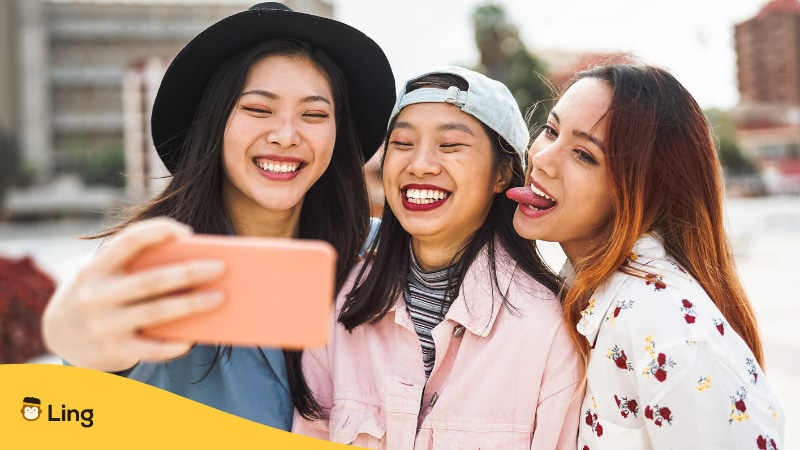
12. Korean Slang Words
In learning basic words and phrases in the Korean language, we shouldn’t miss Korean slang words . If you have a strong grasp of this, understanding Korean jokes and watching K-dramas will be much easier. Also, if you start making friends, you will talk more casually. Usually, these are the terms that you’ll commonly use.
Korean slang words are not usually taught in the classroom. They are learned through interacting with other people and, of course, the internet.
| English Translation | Korean | Pronunciation |
|---|---|---|
| a lot of fun | 꿀잼 | kkuljaem |
| not funny or boring | 노잼 | nojaem |
| fighting! | 화이팅! | hwaiting! |
| my heart skipped a beat | 심쿵 | simkung |
| TBH (to be honest) | 솔까말 | solkkamal |
| OMG, WTF | 헐 | heol |
| charming act | 애교 | aegyo |
| selfie | 셀카 | selka |
| TGIF (literal Burning Friday or Golden Friday) | 불금 | bulgeum |
| It’s lit | 오졌다 | ojyeotda |
| badly | 더럽게 | deoreopge |
| beginner level or noob | 쪼렙 | jjolep |
| swag | 간지 | ganji |
| mental breakdown | 멘붕 | menbung |
| Chicken and beer, the perfect pairing | 치맥 | chimaek |
| impulse shopping | 홧김비용 | hwatgimbiyong |
| mask | 마스크 | maseukeu |
| Fucking delicious | 존맛탱 | jonmattaeng (JMT) |
| prettiest in the world | 세젤예 | sejelye |
| IDK (short for 몰라, molla) | ㅁㄹ | m l |
| sorry (short for 죄송합니다, joesonghamnida) | ㅈㅅ | j s |
| ty (short for 감사합니다, gamsahamnida) | ㄱㅅ | g s |

13. K-Drama Words And Phrases
“Crash Landing On You,” “Reply 1988,” and “Goblin.” These are just three of the most iconic K-dramas that made history in the K-drama world. If you’re an OG K-drama fan, you have surely unconsciously picked up words commonly used in K-dramas. Wondering what it means? Check out these basic Korean phrases used in K-dramas.
| English Translation | Korean | Pronunciation |
|---|---|---|
| used by males when referring to older female siblings/relatives/close friends; | 누나 | noona |
| used by females when referring to older female siblings/relatives/close friends | 언니 | eonni/unni |
| used by males when referring to older male siblings/relatives/close friends | 형 | hyung/hyeong |
| used by females when referring to older male siblings/relatives/close friends/boyfriends; occasionally, idols/celebrities | 오빠 | oppa |
| middle-aged men/married men | 아저씨 | ahjussi |
| middle-aged women/married women | 아줌마 | ahjumma |
| Got it./Understood. | 알았어 | arasseo |
| No way! | 안돼! | andwae |
| Indicate a deep sigh, Expressing frustration or pity; show surprise (occasionally) | 아이구 | aigoo |
| I am hungry. | 배고파 | baegopa |
| Call/Deal | 콜 | kol |
| Wow/Cool/Great | 대박 | daebak |
| Just a sec/Wait a minute./Hold on. | 잠깐만 | jamkkanman |
| Good night./Sleep well. | 잘자 | jalja |
| It’s a lie./Don’t lie. | 거짓말이야 | geojitmariya |
| Really? | 진짜? 정말? | jinjja jeongmal |
| Are you crazy? | 너 미쳤어? | neo michyeosseo |
| Oh yeah | 아싸! | assa |
| Please. | 제발 | jebal |
| What to do? | 어떡해? | eotteokhae? |
| Like this. | 이렇게 | ireohke |
| Alright/ Sure/Okay | 그래 | geurae |
| It’s fine./I’m okay. | 괜찮아 | gwaenchana |
| If so, then…/Of course. | 그럼 | geureom |
| Don’t do it./Stop it. | 하지마 | hajima |
| I’m happy. | 행복해 | haengbokhae |
| Oh my gosh. | 어머 | eomeo |
| Hurry/Faster | 빨리 | palli |
| Could it be…/By any chance…/Would it be possible if… | 혹시 | hokshi |
| Hello (Used for answering a call ) | 여보세요 | yeoboseyo |
| You’re pretty. | 예쁘다 | yeppeuda |
| I Promise/Promise me | 약속해 | yaksokhae |
| used to address seniors | 선배 | sunbae |
| used to address juniors | 후배 | hoobae |
| In the world (literal); Oh my god!/My goodness! | 세상에 | sesange |
14. Korean Words For Music
Just recently, Lisa, the main dancer of the Korean girl group Blackpink, dropped her first-ever single entitled “Lalisa.” This song really made the whole world stop, even non-Koreans, because it broke two Guinness World Records. “Lalisa” hits 73.6 million views in its first 24 hours, breaking Taylor Swift’s “Me!” with 65.2 million. It also set a new record for a solo K-pop artist’s most-viewed YouTube music video in 24 hours which was formerly held by her bandmate Rosé.
BTS also set billboard records with their song “Dynamite” and is now concurring the world’s music industry. Just recently, they released their song with Coldplay entitled “My Universe.”
These are just two of the internationally recognized Korean groups that really made their way to represent Korea. It is no doubt that the Korean music industry is a global trend and has a huge fanbase in different parts of the world.
| English Translation | Korean | Pronunciation |
|---|---|---|
| K-pop | 케이팝 | keipap |
| music | 음악 | eumak |
| music industry | 음악 산업 | eumak saneop |
| musical instrument | 악기 | akki |
| music video | 뮤직 비디오 | myujik bidio |
| classical music | 클래식 음악 | keullaesik eumak |
| pop music | 가요 | gayo |
| rap music | 랩 | raep |
| jazz music | 재즈 음악 | jaejeu eumak |
| singer | 가수 | gasu |
| female singer | 여성 가수 | yeoseong gasu |
| opera singer | 오페라 가수 | opera gasu |
| band | 밴드 | baendeu |
| pop culture | 대중문화 | daejungmunhwa |
| What is your favorite K-pop group? | 어떤 케이팝 그룹을 가장 좋아해요? | Eotteon keipap geurubeul gajang joahaeyo? |
| How long have you been listening to K-pop? | 케이팝을 들은지 얼마나 되었어요? | Keipabeul deureunji eolmana doeeosseoyo? |
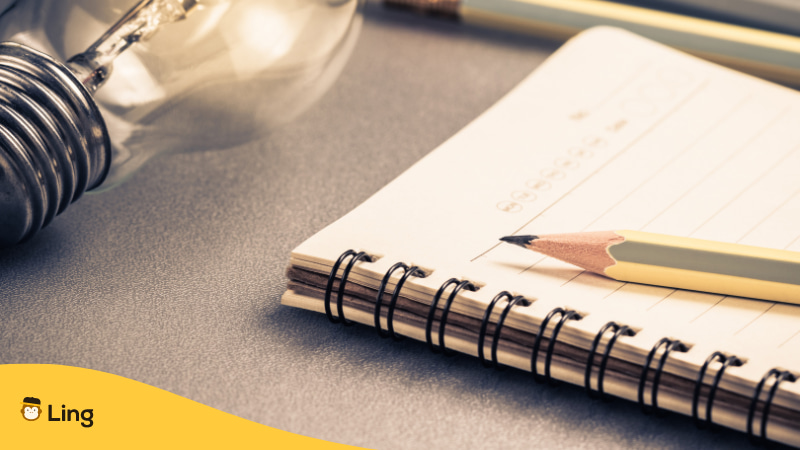
A List Of 365 Common Korean Words To Improve Your Vocabulary
Below are some of the basic vocabulary of common Korean words about everyday life, essential words such as Korean family words, most typical greetings, basic medical terms, directions, and other terms for everyday life.
| . | English Translation | Korean Word |
|---|---|---|
| 1 | hello | 안녕하세요 |
| 2 | excuse me? | 잠시만요 |
| 3 | please in a desperate way | 제발 |
| 4 | really? | 진짜? |
| 5 | please | 주세요 |
| 6 | sorry | 죄송합니다 |
| 7 | thank you | 고맙습니다 |
| 8 | yes | 네 |
| 9 | no | 아니요 |
| 10 | maybe | 아마도 |
| 11 | help | 도와 주세요 |
| 12 | excuse me | 저기요 |
| 13 | water | 물 |
| 14 | vegetables | 야채 |
| 15 | fruit | 과일 |
| 16 | meat | 고기 |
| 17 | bread | 빵 |
| 18 | fish | 생선 |
| 19 | coffee | 커피 |
| 20 | beer | 맥주 |
| 21 | soju | 소주 |
| 22 | friend | 친구 |
| 23 | family | 가족 |
| 24 | old sister (if you are male) | 누나 |
| 25 | old sister (if you are female) | 언니 |
| 26 | old brother (if you are male) | 형 |
| 27 | old brother (if you are female) | 오빠 |
| 28 | younger sibling | 동생 |
| 29 | younger brother | 남동생 |
| 30 | younger sister | 여동생 |
| 31 | dad | 아빠 |
| 32 | father (formal) | 아버지 |
| 33 | mom | 엄마 |
| 34 | mother (formal) | 어머니 |
| 35 | son | 아들 |
| 36 | daughter | 딸 |
| 37 | twins | 쌍둥이 |
| 38 | triplets | 세 쌍둥이 |
| 39 | uncle | 삼촌 |
| 40 | aunt | 이모 |
| 41 | boyfriend | 남자 친구 |
| 42 | girlfriend | 여자 친구 |
| 43 | marriage | 결혼 |
| 44 | husband | 남편 |
| 45 | wife | 아내 |
| 46 | human | 사람 |
| 47 | love | 사랑 |
| 48 | first love | 첫사랑 |
| 49 | secret crush | 짝사랑 |
| 50 | couple | 커플 |
| 51 | drama | 드라마 |
| 52 | once | 한 번 |
| 53 | twice | 두 번 |
| 54 | which | 어느 |
| 55 | who | 누가 |
| 56 | where | 어디서 |
| 57 | how | 어떻게 |
| 58 | when | 언제 |
| 59 | what | 무엇을 |
| 60 | why | 왜 |
| 61 | house | 집 |
| 62 | country | 나라 |
| 63 | job | 직업 |
| 64 | you’re welcome | 천만에요 |
| 65 | left | 왼쪽 |
| 66 | right | 오른쪽 |
| 67 | it’s fine | 괜찮아 |
| 68 | for a while | 잠시동안 |
| 69 | time | 시간 |
| 70 | now | 지금 |
| 71 | today | 오늘 |
| 72 | yesterday | 어제 |
| 73 | tomorrow | 내일 |
| 74 | to go | 가다 |
| 75 | to come | 오다 |
| 76 | to have | 있다 |
| 77 | to be | 이다 |
| 78 | to eat | 먹다 |
| 79 | to drink | 마시다 |
| 80 | to give | 주다 |
| 81 | to see | 보다 |
| 82 | to sleep | 자다 |
| 83 | to wake up or get up | 일어나다 |
| 84 | to buy | 사다 |
| 85 | to write or to use | 쓰다 |
| 86 | to laugh | 웃다 |
| 87 | to cry | 울다 |
| 88 | to wear | 입다 |
| 89 | to walk | 걷다 |
| 90 | to read | 읽다 |
| 91 | to learn | 배우다 |
| 92 | to study | 공부하다 |
| 93 | to meet | 만나다 |
| 94 | to like | 좋다 |
| 95 | to hate | 싫다 |
| 96 | to be hot | 덥다 |
| 97 | to be cold | 춥다 |
| 99 | to be sad | 슬프다 |
| 100 | to be sick or in pain | 아프다 |
| 101 | to be tired | 피곤하다 |
| 102 | to be interesting | 재미있다 |
| 103 | to be boring | 재미없다 |
| 104 | to be difficult | 어렵다 |
| 105 | to be easy | 쉽다 |
| 106 | to be clean | 깨끗하다 |
| 107 | to be dirty | 더럽다 |
| 108 | to be fast | 빠르다 |
| 109 | to be slow | 느리다 |
| 110 | fast | 빨리 |
| 111 | really | 정말 |
| 112 | slowly | 천천히 |
| 113 | sometimes | 가끔 |
| 114 | seldom | 좀처럼 |
| 115 | never | 결코 |
| 116 | never | 절대 |
| 117 | skin | 피부, 살갗 |
| 118 | eye | 눈 |
| 119 | body | 신체/몸 |
| 120 | head | 머리 |
| 121 | hair | 머리카락 |
| 122 | face | 얼굴 |
| 123 | dimple | 보조개 |
| 124 | forehead | 이마 |
| 125 | eyebrow | 눈썹 |
| 126 | shoulder | 어깨 |
| 127 | eyelid | 눈꺼풀 |
| 128 | eyelashes | 속눈썹 |
| 129 | pupil | 눈동자 |
| 130 | ear | 귀 |
| 131 | cheek | 볼 / 뺨 |
| 132 | nose | 코 |
| 133 | nostrils | 콧구멍 |
| 134 | mouth | 입 |
| 135 | tooth | 이, 이빨 |
| 136 | lips | 입술 |
| 137 | gum | 잇몸 |
| 138 | tongue | 혀 |
| 139 | chin | 턱 |
| 140 | neck | 목 |
| 141 | throat | 목구멍 |
| 142 | body parts | 신체 부분 |
| 143 | breast | 가슴 |
| 144 | breast | 유방 |
| 145 | back | 등 |
| 146 | abdomen | 배 |
| 147 | navel | 배꼽 |
| 148 | waist | 허리 |
| 149 | buttocks | 엉덩이 |
| 150 | vagina | 질/보지 |
| 151 | penis | 음경/자지 |
| 152 | hand | 손 |
| 153 | arm | 팔 |
| 154 | wrist | 팔목 |
| 155 | wrist | 손목 |
| 156 | elbow | 팔꿈치 |
| 157 | palm (hand) | 손바닥 |
| 158 | fist | 주먹 |
| 159 | finger | 손가락 |
| 160 | thumb | 엄지 |
| 161 | index finger | 검지 |
| 162 | ring finger | 약지 |
| 163 | fingernail | 손톱 |
| 164 | armpit | 겨드랑이 |
| 165 | leg | 다리 |
| 166 | thigh | 허벅지 |
| 167 | knee | 무릎 |
| 168 | foot | 발 |
| 169 | claw | 발톱 |
| 170 | ankle | 발목 |
| 171 | top of the foot | 발등 |
| 172 | heel | 뒤꿈치 |
| 173 | toe | 발가락 |
| 174 | brain | 뇌 |
| 175 | heart | 심장 |
| 176 | artery | 혈관 |
| 177 | liver | 간 |
| 178 | lungs | 폐 |
| 179 | muscles | 근육 |
| 180 | bone | 뼈 |
| 181 | stomach | 위 |
| 182 | appendix | 맹장 |
| 183 | kidney | 콩팥 |
| 184 | pancreas | 췌장 |
| 185 | bowels | 장 |
| 186 | womb | 자궁 |
| 187 | anus | 항문 |
| 188 | doctor | 의사 |
| 189 | nurse | 간호사 |
| 190 | injection | 주사 |
| 191 | pharmacist | 약사 |
| 192 | medicine | 약 |
| 193 | cancer | 암 |
| 194 | cough | 기침 |
| 195 | flu | 독감 |
| 196 | tumor | 종양 |
| 197 | vomiting | 구토 |
| 198 | paralysis | 마비 |
| 199 | poisoning | 중독 |
| 201 | toothache | 치통 |
| 202 | stomachache | 복통 |
| 203 | constipation | 변비 |
| 204 | jaundice | 황달 |
| 205 | runny nose | 콧물 |
| 206 | high fever | 고열 |
| 207 | pregnancy | 임신 |
| 208 | childbirth | 출산 |
| 209 | abortion | 낙태 |
| 210 | operation | 수술 |
| 211 | hospitalization | 입원 |
| 212 | hospital discharge | 퇴원 |
| 213 | diabetes | 당뇨병 |
| 214 | sunstroke | 일사병 |
| 215 | gastric ulcer | 위궤양 |
| 216 | syndrome | 증후군 |
| 217 | high blood pressure | 고혈압 |
| 218 | low blood pressure | 저혈압 |
| 219 | malnutrition | 영양실조 |
| 220 | death | 사망, 임종 |
| 221 | sickness | 병 |
| 222 | prescription | 처방 |
| 223 | dermatology | 피부과 |
| 224 | paediatrics | 소아과 |
| 225 | ultrasound | 초음파 |
| 226 | neurology | 신경과 |
| 227 | consultation room | 진료실 |
| 228 | emergency room | 응급실 |
| 229 | plastic surgery | 성형외과 |
| 230 | apple | 사과 |
| 231 | apricot | 살구 |
| 232 | asparagus | 아스파라거스 |
| 233 | aubergine | 가지 |
| 234 | avocado | 아보카도 |
| 235 | baked beans | 찐 콩 |
| 236 | banana | 바나나 |
| 237 | beansprouts | 콩나물 |
| 238 | beetroot | 홍당무 |
| 239 | blackberry | 블랙베리 |
| 240 | blackcurrant | 블랙커런트 |
| 241 | blueberry | 블루베리 |
| 242 | broccoli | 브로콜리 |
| 243 | brussels sprouts | 양배추 |
| 244 | a bunch of bananas | 바나나 한 송이 |
| 245 | a bunch of grapes | 포도 한 송이 |
| 246 | cabbage | 배추 |
| 247 | carrot | 당근 |
| 248 | cauliflower | 꽃양배추 |
| 249 | celery | 샐러리 |
| 250 | cherry | 체리 |
| 251 | courgette | 애호박 |
| 252 | cucumber | 오이 |
| 253 | fig | 무화과 |
| 254 | French bean | 프렌치 콩 |
| 255 | garlic | 마늘 |
| 256 | ginger | 생강 |
| 257 | gooseberry | 구스베리 |
| 258 | grape | 포도 |
| 259 | grapefruit | 자몽 |
| 260 | kidney beans | 강낭콩 |
| 261 | kiwi | 키위 |
| 262 | leek | 대파 |
| 263 | lemon | 레몬 |
| 264 | lettuce | 양상추 |
| 265 | lime | 라임 |
| 266 | mango | 망고 |
| 267 | melon | 멜론 |
| 268 | mushroom | 버섯 |
| 269 | onion | 양파 |
| 270 | orange | 오렌지 |
| 271 | peach | 복숭아 |
| 272 | pear | 배 |
| 273 | peas | 콩 |
| 274 | guava | 구아바 |
| 275 | pineapple | 파인애플 |
| 276 | plum | 자두 |
| 277 | pomegranate | 석류 |
| 278 | potato | 감자 |
| 279 | pumpkin | 호박 |
| 280 | radish | 무 |
| 281 | raspberry | 라즈베리 |
| 282 | soup | 수프 |
| 283 | spinach | 시금치 |
| 284 | spring onion | 파 |
| 285 | squash | 호박 |
| 286 | strawberry | 딸기 |
| 287 | sweet potato | 고구마 |
| 288 | corn / sweetcorn | 옥수수 |
| 289 | tinned tomatoes | 토마토 통조림 |
| 290 | tomato | 토마토 |
| 291 | turnip | 순무 |
| 292 | Persimmon | 감 |
| 293 | Mustard | 갓 |
| 294 | mandarin | 귤 |
| 295 | cauliflower | 꽃양배추 |
| 296 | rice field | 논 |
| 297 | soybean | 대두 |
| 298 | bellflower | 도라지 |
| 299 | wheat | 밀 |
| 300 | chestnut | 밤 |
| 302 | leek | 부추 |
| 303 | barley | 보리 |
| 304 | watermelon | 수박 |
| 305 | citron | 유자 |
| 306 | plum | 자두, 매실 |
| 307 | (musk) melon | 참외 |
| 308 | fafaya | 파파야 |
| 309 | red bean | 팥 |
| 310 | green pepper | 풋고추 |
| 311 | brown rice | 현미 |
| 312 | carrot | 당근 |
| 313 | rye | 호밀 |
| 314 | gingko nut | 은행 |
| 315 | gluten | 찹쌀 |
| 316 | green (unripe) fruit | 선 과일 |
| 317 | orchard | 과수원 |
| 318 | baguette | 바케뜨 |
| 319 | baking powder | 제빵 가루 |
| 320 | blue cheese | 블루 치즈 |
| 321 | bread rolls | 롤빵 |
| 322 | brown bread | 갈색빵 |
| 323 | brown sugar | 갈색 설탕 |
| 324 | butter | 버터 |
| 325 | cake | 케이크 |
| 326 | cooking oil | 식용유 |
| 327 | corn flour | 옥수수 가루 |
| 328 | cottage cheese | 코티지 치즈 |
| 329 | cream | 크림 |
| 330 | dates | 대추 |
| 331 | dried apricots | 건살구 |
| 332 | eggs | 달걀 |
| 333 | full-fat milk | 고지방 우유 |
| 334 | garlic bread | 마늘빵 |
| 335 | goats cheese | 염소젖 치즈 |
| 336 | icing sugar | 아이싱 설탕 |
| 337 | milk | 우유 |
| 338 | olive oil | 올리브오일 |
| 339 | pastry | 패스트리 |
| 340 | plain flour | 일반 밀가루 |
| 341 | raisins | 건포도 |
| 342 | sponge cake | 스폰지 케이크 |
| 343 | sugar | 설탕 |
| 344 | white bread | 흰빵 |
| 345 | yeast | 효모 |
| 346 | yoghurt | 요구르트 |
| 347 | chilli powder | 고춧가루 |
| 348 | cinnamon | 계피 |
| 349 | curry powder | 카레 가루 |
| 350 | paprika | 파프리카 |
| 351 | saffron | 사프란 |
| 352 | organic | 유기농 |
| 353 | ketchup | 케첩 |
| 354 | breakfast cereal | 아침 시리얼 |
| 355 | cornflakes | 콘프레이크 |
| 356 | honey | 꿀 |
| 357 | jam | 잼 |
| 358 | noodles | 면 |
| 359 | pasta | 파스타 |
| 360 | pizza | 피자 |
| 361 | porridge | 죽 |
| 362 | rice | 쌀 |
| 363 | spaghetti | 스파게티 |
| 364 | toast | 토스트 |
| 365 | Instant Noodles | 라면 |
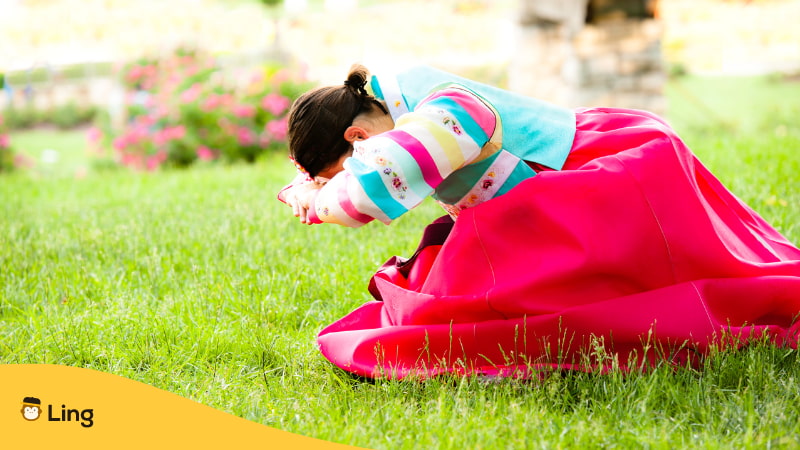
Whenever you hear the words or phrases that Korean people speak or see their expressions when you watch their different dramas on the television or on your phone, it becomes more and more familiar to you. By listening to native Korean speakers, you are already making a lot of effort to remember these basic words and phrases!
Learning about Korean culture is necessary because this will widen your perspective on learning the Korean language itself. When you observe Korean culture, you will recognize the meaning behind their language, words, phrases, sentences, and vocabulary in terms of speaking.
The common Korean vocabulary words that reflect Korean culture are the following:
- 친구 — “Chingu” (Friend) — This word has a different usage in English because Koreans generally use this word of the same age.
- 사랑 — “Sarang” (Love) — This is a Korean word for love. Japanese also have this word with the same meaning.
- 썸타다 — “Sseom-Ta-Da” (Mutual Understanding/Something’s going on) — This basic Korean phrase came from the English word ‘something’ or ‘something’s going’ on in terms of dating, and ‘ta-da’ is an expression of ‘go-along’ if the dating couple will move to a more serious relationship.
- 애교 — “Aegyo” (Charming Act) — This word is a trend right now in Korea. Mostly, women and even men do this charming and adorable act to look sweet to people. They often do the ‘aegyo’ when they take a ‘selka’ on their phones.
- 셀카 — “Selka” (Selfie) — From the English word ‘selfie’. Most Korean artists love to take pictures. Coz why not? Korean glass skin is worth showing off.
- 미안해 — “Mianhae” (I’m sorry) — This is an informal way to speak ‘I’m sorry’ in Korean. You always hear this Korean word, mostly in Kpop songs. In addition, Koreans are polite , especially the youngsters.
- 물 — “mul” (water) — This is the most commonly used noun in South Korea, as you probably hear in many K-dramas when drinking soju or eating moekbang.
- 밥 — “bap” (rice) — It’s not only the Philippines and Japan who love to eat rice, but also Korea. The rice that they eat was often wrapped in different types of leaves, together with meat or fish.
- 고기 — “gogi” (meat) — Koreans love meat, most especially grilled pork belly, which is also known as ‘ samgyeop-sal ’ with different ingredients. This is commonly eaten by a Korean family.
- 소주 — “soju” (clear liquor) — This is the most popular liquor in Korea. In Korean culture, drinking alcohol like soju, rice wine, and other alcohol is a big part of the lives of Korean family.
- 지금 — “jigeum” (now) — We frequently hear this word from our favorite Kpop groups whenever they have interviews, or sometimes in the daily conversations of your favorite Korean actors or artists in a variety show. This literally means ‘now’ or ‘at this moment’.
- 괜찮아요 — “gwaenchanayo” (That’s okay) — Most Koreans are cheerful and also compassionate people. In other words, you probably hear this Korean word whenever there’s an unexpected scenario in a Korean drama.
- 잘 자요 — “jal jayo” (Goodnight) — Although some Koreans use the English term ‘goodnight,’ most of the songs we hear from our favorite Kpop groups use ‘jal jayo.’ See? Through listening to their songs, we can learn basic Korean phrases, and understand some of the common Korean words in just a moment.
- 잠깐만요! — “jamkkannmanyo!” (Just a moment! / Wait!) — This expression from the most common Korean words is generally formally used in everyday life.
- 다 같이 — “da gachi” (All together) — You probably heard it right? This Korean word is usually heard when you watch a concert from your favorite Kpop group in initiating the fans to sing along with them.
- 이게 뭐예요 — “ige mwoyeyo” (What is this?) — This is also an expression from the most common Korean words, and it is also mainly used in everyday life in an informal manner, most especially when you are talking with your close friends or relatives.
- 좋아요 — “joayo” (Good) — This is also one of the most common Korean words that are being used a lot. You can hear this through different Korean vloggers who want different viewers to subscribe and like ‘joayo’ their vlogs.
Learn these cultural terms and you will be one step ahead!
Now that you’ve learned a few important words in Korean, there’s still a long way to go. If you are new to the language and are interested in learning even more details about this fantastic language, read this helpful information and take note!
Korean is spoken in North and South Korea, China (mainly provinces bordering North Korea), Japan, and Russia.
Korean is also spoken in other large communities around the world, such as the US (most from New York), Singapore, Thai, Guam, and Paraguay. The number of Korean speakers continues to increase because there are some countries like the Philippines, where the Korean language is taught as an elective course.
Affiliation
The most known origin of the Korean language is the Altaic language family of central Asia, including Turkish, Mongolian, and the Tungusic languages of Siberia. Other linguists also argue that Korean belongs to the Austronesian language family.
Because of the long history between Chinese and Japanese, determining their linguistic affiliation is really complicated. Some also considered the Korean language as isolated. Whatever its origin may be, it gave birth to an amazing language called Korean.
We all know that the whole country of Korea is divided into two – The Democratic People’s Republic of Korea (North Korea) and the Republic of Korea (South Korea). The Ancient Korean language was divided into many dialects, but naturally unified during the Unified Silla period.
There are two standard varieties of Modern Korean. Both dialects are distinguished and regulated by the national language policy of the country. Most of these dialects are mutually intelligible.
- Seoul Dialect – The standard dialect of South Korea. There are also regional dialects such as Kyeonsang, Chungchong, Jeolla, and Jeju Island.
- P’yŏngyang Dialect – This is the standard dialect of North Korea. The regional dialects include Hamkyeong, Pyeongan, and Hwanghae.
Learning basic words and phrases in the Korean Language will definitely help survive. You will hear a lot of phrases and words that you don’t even understand, and it will make it hard for you to have good communication with the locals. Of course, you won’t always have the opportunity to check your dictionaries or some free PDF files saved on your cellphone to compose what you want to say.
If you want to learn more Korean words (including transitional words ), phrases, and sentences, the Ling app will help you achieve your goals. Through the Ling app , you will be able to hear the pronunciation of each word. This will help you learn to speak the language accurately.
Ling will provide fun and engaging lessons that will surely make your language learning experience exciting and meaningful. These lessons will help you learn how to speak and write in Korean.
Through Ling, you don’t have to attend any class on a given schedule because you can learn with just your phone or computer during your free time. Learning a language will be a lot easier and more fun. What are you waiting for? Download the Ling app on the Play Store or App Store and start learning Korean now!
7 Responses
I really like those phrases it really help in my Korean learning
Daedanhi gamsahamnida❤️
thanks for teaching korean language
i would like to learn korean please
Hi James, Try our Ling app to learn Korean !
This will help me in my learning of the Korean language and through my journey as well as a architect as I proceed on. Thank you so much.
it really helped me ghamsamnida.
Leave a Reply Cancel reply
You must be logged in to post a comment.
Discover more

People also read

Flag Of Finland – Know The Remarkable History
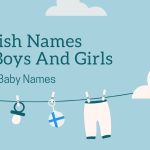
Finnish Names: 30+Best Helpful List Of Names For Babies
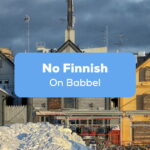
No Finnish On Babbel? The #1 Best Alternative For 2023

Best 8 Apps To Learn Finnish Fluently In 2023

8 Remarkable Ways To Say Thank You In Finnish

People Of Finland – Introducing The #1 Happiest Country
Southeast asia, east europe.
© 2024 Simya Solutions Ltd.

100+ Useful Conversational Phrases & Words in Korean
My name is Shannon Kennedy and I'm the language lover,…
Want to learn conversational Korean?
Learn key Korean words and phrases in important conversational topics with this post! Plus, there’s a free PDF you can download with even more useful words and phrases in Korean.
As a part of the Korean language challenge I did with Lindsay of Lindsay Does Languages , I thought it would be fun to share the phrase and word sheet I use as a guide to give me an extra boost when speaking Korean.
These phrases or expressions are those that I’ve found quite useful, especially as a part of those first few conversations and now, I’d like to share them with you.
As a part of the challenge, most of the focus for Lindsay and I had been to learn a bit of Korean grammar (honorifics, basic conjugation, and so on), but I also wanted to spend time learning helpful phrases for day-to-day conversations.
So rather than continuing to focus on rules involving particles, I got to learn fun expressions like “what kind of music do you like?” and get that much closer to actually conversing with Korean speakers.
In this post you’ll find a short selection of the 100+ conversational phrases and words in Korean (actually, it’s closer to 140 words and phrases) I have available as part of a downloadable PDF that you can get below.
Happy Korean language learning!
Get your free PDF with 100+ Conversational Korean Words and Phrases
Sign up for my free language learning library and get access to my Korean phrases PDF as well as tons of other language learning resources!

Korean Greetings
| How are you/Hello | 안녕하세요 | annyeonghaseyo |
| What’s new? | 별일 없지요 ? | byeol-il eobsjiyo |
| Long time no see | 오랜만이다 | orenmanida |
| Nice to meet you | 만나서 반갑습니다 | mannasuh bangapseumnida |
| I am very happy to meet you | 만나서 참 반가워요 | mannaseo cham bangawoyo |
Basic & Polite Phrases in Korean
| Yes | 네 | ne |
| No | 아니요 | aniyo |
| Excuse me (to request something) | 실례지만… | shillejiman… |
| Thank you | 감사합니다 | kamsahamnida |
| You’re welcome / don’t mention it | 천만 에 요 | cheonman e yo |
Get the Conversation Rolling in Korean
| Please don’t speak English | 영어 로 말하지 마세요 | yeong-eo lo malhaji maseyo |
| What? | 뭐 ? | mwo |
| What music do you like? | 어떤 음악 을 좋아해요 ? | eotteon eum-ag eul joh-ahaeyo |
| I like … | 저는 … 좋아해요 | jeoneun … joh-ahaeyo |
| What do you do when you have free time | 시간 있을 때 뭐 하세요 ? | sigan iss-eul ttae mwo haseyo |
Getting a Bit of Clarification in Korean
| What does this mean? | 무슨 뜻이에요? | museun tteusieyo |
| Please say that one more time. | 다시 한 번 말해 주세요. | dasi han beon malhae juseyo |
| Please speak slowly. | 천천히 말해 주세요. | cheoncheonhi malhae juseyo |
| Please write it down. | 적어 주세요 | jeog-eo juseyo |
| I don’t understand | 모르겠 습니 다 | moreugesseumnida |
Words About Time in Korean
| Sometimes | 가끔 | gakkeum |
| Always | 항상 | hangsang |
| Today | 오늘 | oneul |
| Tomorrow | 내일 | naeil |
| Yesterday | 어제 | eoje |
Exclamations & Transition Words to Take Your Korean Speaking to the Next Level
| Well… | 글쎄요… | geulsseyo |
| Um | 음 | eum |
| Oh my gosh | 헐 | heol |
| For real? | 진짜요? | jinjjayo |
| I think so | 저도 그렇게 생각 합니다 | jeodo geuleohge saeng-gag habnida |
Conversation Closers & Goodbye in Korean
| See you later | 나중에 봬요 | najunge bwaeyo |
| Good bye | 안녕히 계세요 | annyonghi geseyo |
| Have a nice day | 좋은 하루 되세요 | joeun haru dweseyo |
| See you later. | 이따 봐요. | itta bwayo |
| I have to go now | 나 지금 가야 돼 | na jigeum gaya dwae |
As a bonus, here is a fun video I found using some of the phrases above so you can hear how they sound!

Memrise is Doing Away with User-Generated Content… Now What?
*Please note that most of the above examples use formal language, assuming that you’re getting to know the person that you’re speaking with.
And here’s my progress in Korean after studying the language for just 90 days with the Fluent in 3 Months Bootcamp (formerly the Challenge) :
Are you learning Korean? What are some phrases that you’ve found useful in your target language? I’d love to hear about them in the comments!
You can also check out my recommended resources for Korean. Or you can dive into taekwondo vocabulary in Korean or learn a bit about Korean culture .
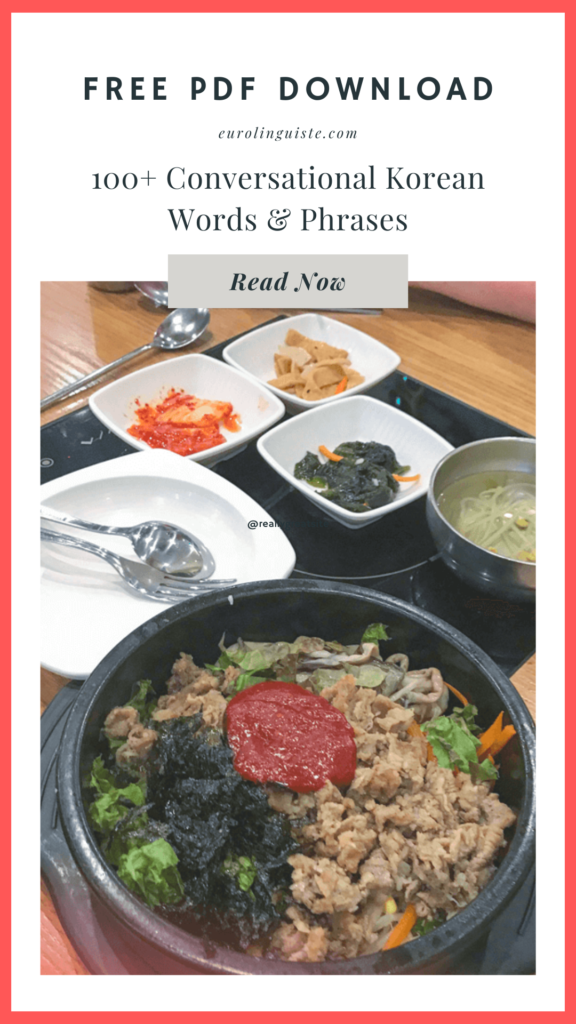
My name is Shannon Kennedy and I'm the language lover, traveler, and foodie behind Eurolinguiste. I'm also the Head Coach of the Fluent in 3 Months Bootcamp, co-founder of Women in Language, and former Resident Polyglot at Drops.

How to Learn Scottish Gaelic Online

100+ Ways to Fit Language Learning in Your Day
Want to see your product here? Learn how.

All Documented Language Learning Projects on Eurolinguiste
Ask the polyglot episode 1: do you ever mix up languages.

Snack-Sized Language Episode 7: How to Say Hello in Korean
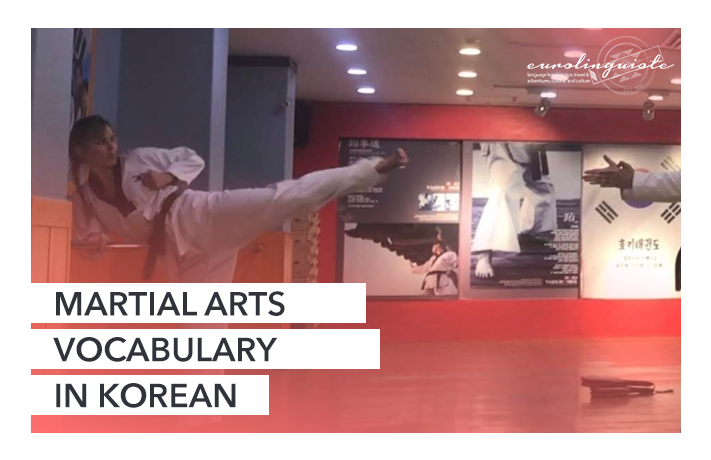
Martial Arts Vocabulary in Korean: How to Talk About Taekwondo in Korean
© 2020 Shannon Kennedy & Eurolinguiste. All Rights Reserved.
Speak with Confidence
How to Say “Presentation” in Korean: Formal and Informal Ways
Gaining the ability to express yourself clearly in another language is an exciting journey. When it comes to the word “presentation” in Korean, it’s essential to understand the various ways it can be expressed. In this guide, we’ll explore both formal and informal ways to say “presentation” in Korean, providing you with tips, examples, and even regional variations if necessary.
Table of Contents
1. Formal Ways to Say “Presentation” in Korean
When you need to use a formal expression for “presentation” in Korean, you can rely on the following phrases:
a) 발표 (Bal-pyo)
If you’re attending a formal event or giving a professional presentation, “발표” is the appropriate term to use. This term is widely recognized and used in academic, business, or official settings. For example:
제 발표는 다음 주에 있을 예정입니다. (Je bal-pyo-neun da-eum ju-e i-sseul ye-jeong-im-ni-da.) My presentation is scheduled for next week.
b) 프레젠테이션 (Peu-re-jeon-tei-syeon)
“프레젠테이션” is an alternative formal term used, primarily influenced by English. It is often used in corporate or technological environments. For instance:
저희 회사에서는 프레젠테이션을 개최할 예정입니다. (Je-hui hwe-sa-e-seo-neun peu-re-jeon-tei-syeon-eul gae-choe-hal ye-jeong-im-ni-da.) Our company is planning to hold a presentation.
2. Informal Ways to Say “Presentation” in Korean
When you’re in informal settings or having casual conversations with friends, you can choose less formal expressions for “presentation” in Korean:
Yes, “발표” isn’t only used in formal contexts. It is also common in informal situations. Feel free to use it when talking casually with friends. For example:
내 발표를 도와줄 수 있을까요? (Nae bal-pyo-reul do-wa-jul su i-sseul-gga-yo?) Can you help me with my presentation?
b) 보고 (Bo-go)
“보고” can be used in a more informal environment, especially when referring to school or class presentations. This term is commonly used among students. Take a look at this example:
오늘은 보고가 있어서 정말 긴장되네요. (O-neul-eun bo-go-ga i-sseo-seo jeong-mal gin-jang-doe-ne-yo.) I’m really nervous because I have a presentation today.
3. Regional Variations
The Korean language can have subtle regional variations, but when it comes to the word “presentation,” the expressions mentioned above are generally used throughout Korea. However, it’s also important to note that variations can exist in dialects or specific regions. Nevertheless, the terms introduced in this guide will be universally understood throughout Korea.
Now you’re equipped with both formal and informal ways to say “presentation” in Korean. Remember to choose the appropriate expression based on the context or formality of your conversation. Whether you’re attending a professional event or discussing presentations with friends, these phrases will help you express yourself clearly in Korean. Keep practicing and expanding your vocabulary to become even more fluent in the language!
Related Guides:
- How to Say “At the End of Presentation”
- How to Say Good Morning in a Presentation – Formal and Informal Ways
- Guide on How to Say Good Presentation Skills
- Guide: How to Say “Nice Presentation” – Formal and Informal Ways
- How to Say Presentation: Formal and Informal Ways, Tips, and Examples
- How to Say “Presentation” in Sanskrit: Formal and Informal Ways
- How to Say You Have Good Presentation Skills
- Guide: How to Say Your Presentation in English
About The Author
Ellie Claire
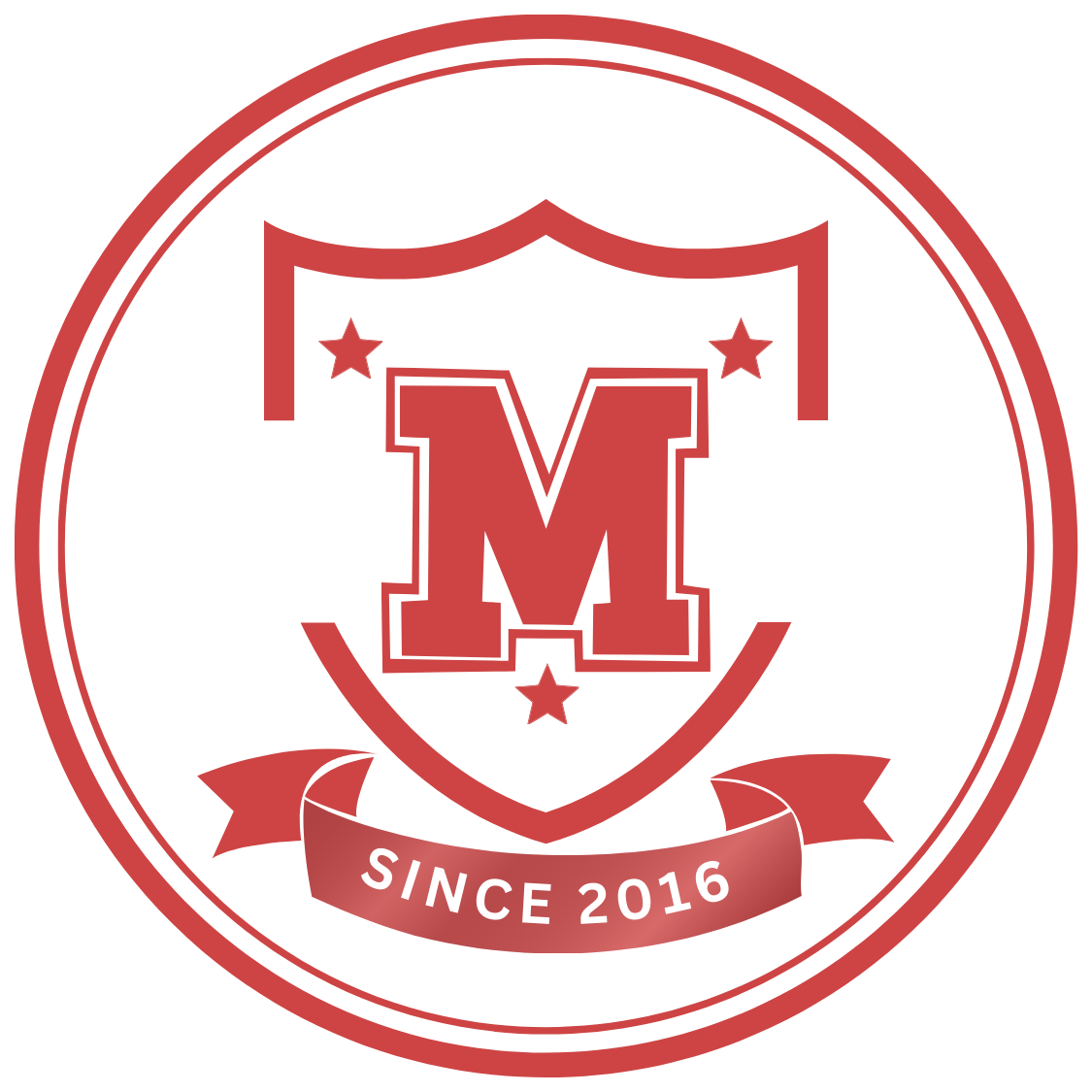
Daily Korean Phrases For Beginners

Welcome to our blog! We’re here to help you learn important Korean phrases. Whether you’re planning a trip, curious about Korean culture, or just love languages, this guide is perfect for you. Korean is spoken by millions worldwide and has a fascinating history. In this series, we’ll break down key phrases to help you in everyday situations, like ordering food or asking for directions.
Don’t worry if learning a new language feels overwhelming! We’ll take it step by step, starting with basic greetings and moving on to useful expressions. Each phrase will come with clear explanations and tips on how to say it correctly. Whether you’re new to Korean or already know a bit, this blog will make learning fun and easy.
So, let’s get started! Together, we’ll explore Korean language and culture, one phrase at a time. Get ready to open doors to new experiences and connect with people in Korea. Ready? Let’s go!
Table of Contents
Essential Korean Phrases
Learning essential Korean phrases is crucial for beginners because it lays the foundation for effective communication and enhances your overall experience in Korea. These basic phrases help you navigate everyday situations, such as greeting people, ordering food, asking for directions, and expressing gratitude.
By mastering these fundamental expressions, you build confidence and show respect for Korean culture, making interactions more enjoyable and meaningful. Additionally, understanding these phrases can open doors to deeper language learning and foster connections with native speakers, enriching your cultural experience.
Click on the 🔊 or the Hangul word to listen to the pronunciation.
| [an nyeong / an nyeong ha se yo] | |
| [an nyeong hi ge se yo] | |
| (to the person leaving) [an nyeong hi ga se yo] | |
| [su geo ha se yo] | |
| [bae go pa yo] | |
| [mwo meog eur gga yo] | |
| [jal mok kket sseum ni da] | |
| [jal mog ot sseum ni da] | |
| [yo bo se yo] | |
| [jin jja yo] | |
| [dang yon ha jyo] | |
| [dae bak] | |
| [jwe song ham ni da] | |
| [si gan gwaen cha neu se yo] | |
| [ol ma e yo] | |
| [jo gi yo] | |
| [i go ju se yo] | |
| [o neul nal ssi jin jja jon ne yo] | |
| [jo a yo] | |
| [nae il bwa yo] |
You may have heard these phrases before, but now you’ll learn the most accurate way to pronounce them! Mastering the correct pronunciation of essential Korean phrases is key to effective communication and will help you feel more confident when speaking with native speakers.
Basic Korean Phrases

Here are the essential Korean phrases you need for casual conversations. In Korean, certain phrases are used for specific situations, like “yes” “no,” and “good morning.”
Understanding when to use these phrases is crucial, especially in South Korea. Learning these basic Korean phrases can be fun and interesting because of the different situations they’re used in.
| [ne] | |
| [a ni yo] | |
| [gam sa ham ni da] | |
| [a nim ni da] | |
| [mi an ham ni da] | |
| [gwaen cha na yo] | |
| [an nyeong ha se yo] | |
| [jeo gi yo] | |
| [sil lye ham ni da] | |
| [jam si man yo] | |
| [yeo bo se yo] | |
| [jo eun a chim i e yo] | |
| [jam ggan man yo] | |
| [jal ja yo] | |
| [jo eun ggum ggwo yo] | |
| [jal ga yo] | |
| [jo eun ha ru bo nae se yo] | |
| [nae il bwa yo] |
These are also some very basic but extremely important Korean phrases you must know if you want to learn Korean. These are like saying “hi,” “bye,” “yes,” and “no” in English. Make sure you learn and memorize them to keep practicing. These foundational phrases will greatly help you in everyday conversations and make your learning journey smoother and more enjoyable.
Common Korean Phrases for Beginners
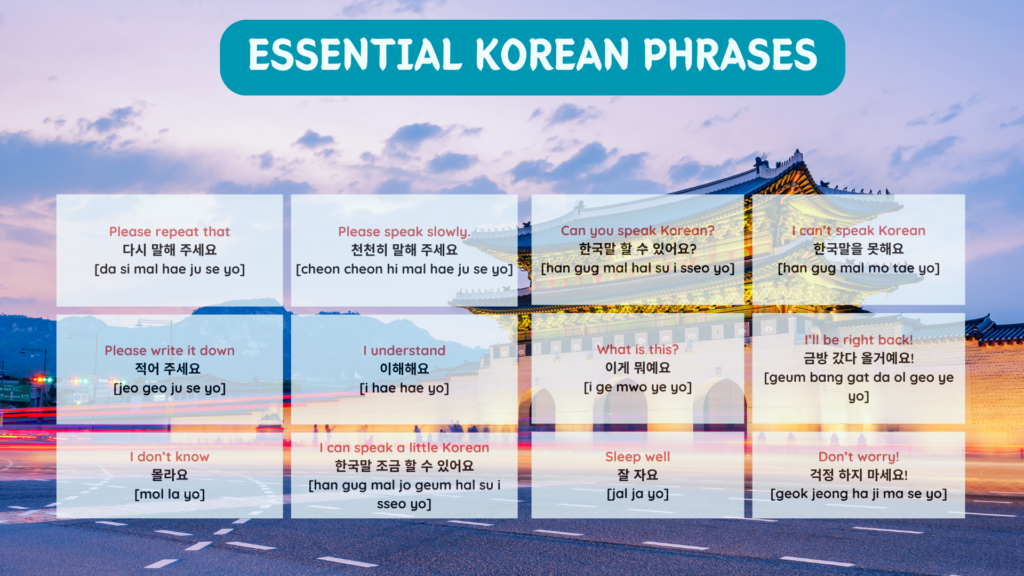
Learning some common Korean phrases is essential for beginners to understand basic conversations and ask for repetition when needed. These phrases will help you navigate everyday interactions, from greeting people to asking simple questions.
By familiarizing yourself with these basic terms, you’ll be better equipped to understand what others are saying and feel more confident in your responses. Whether you’re asking for directions, ordering food, or just saying hello, these phrases are the building blocks of effective communication in Korean.
Let’s get started with the basics that will make your learning experience smoother and more enjoyable!
| [hwa jang sir eun eo di e i sseo yo] | |
| [da si mal hae ju se yo] | |
| [cheon cheon hi mal hae ju sae yo] | |
| [jeo geo ju se yo] | |
| [i hae hae yo] | |
| [i hae mot hae yo] | |
| [a ra yo] | |
| [mol la yo] | |
| [han gug mal jo geum hal su i sseo yo] | |
| [han gug mal hal su i sseo yo] | |
| [han gug mal mo tae yo] | |
| [xxxxx han gug mal lo mwo ye yo?] | |
| [i geo eol ma ye yo] | |
| [geum bang gat da ol geo ye yo] | |
| [i ge mwo ye yo] | |
| [geok jeong ha ji ma se yo] | |
| [jo a yo] | |
| [an jo a yo] |
These are the most important phrases for beginners. They will help you tell people whether you know Korean or not, ask how to say certain words in Korean, and tell people if you understand what they’re saying. Mastering these phrases will make your interactions smoother and help you learn the language more effectively.
Knowing how to express your language skills and ask for help is crucial when learning Korean. By learning these key phrases, you can easily let others know your proficiency level, seek assistance with vocabulary, and clarify your understanding during conversations. This not only boosts your confidence but also encourages more meaningful interactions with native speakers, enhancing your learning experience.
Essential Korean Phrases (When Meeting Someone for the First Time)

Meeting new people can be both exciting and challenging, especially when there’s a language barrier. If you’re planning to visit Korea or interact with Korean speakers, knowing some basic phrases can make a significant difference.
These essential Korean phrases will not only help you navigate initial conversations but also leave a positive impression. From greetings and introductions to discussing hobbies and asking about their family, these phrases cover a wide range of topics that can come up when you first meet someone. Whether you’re a tourist, an expat, or just interested in learning Korean, these expressions are a great starting point
| (an nyeong ha se yo) | |
| (man na seo ban gap seum ni da) | |
| (jeo neun [i reum] im ni da) | |
| (i reum i mwo ye yo) | |
| (eo di seo o syeo sseo yo) | |
| (myeot sal-i e yo) | |
| (jig eob i mwo ye yo) | |
| (gam sa ham ni da) | |
| (go map seum ni da) | |
| (joe song ham ni da) | |
| (mi an ham ni da) | |
| (eo tteo ke ji nae se yo) | |
| (myeot nyeon saeng-i e yo) | |
| (eo di e sa ra yo) | |
| (gyeol hon ha syeo sseo yo) | |
| (jal bu tak deu rim ni da) | |
| (chu ka ham ni da) | |
| (geon gang ha se yo) |
Learning these basic Korean phrases will undoubtedly enhance your ability to communicate and connect with Korean speakers. By showing your effort to speak their language, you’ll find that people are often more open and willing to engage with you, making your interactions more meaningful and enjoyable. Remember, practice makes perfect, so don’t be afraid to use these phrases whenever you get the chance. With time and practice, you’ll become more confident and conversational in Korean, opening up even more opportunities to build relationships and understand the culture better.
Popular Korean Phrases

In the world of Korean language and culture, certain phrases are like stars in the sky – shining brightly in everyday conversations and the captivating dramas we love. From saying “hello” to sharing your feelings, these phrases capture the heart of human connection.
Whether you’re a fan of Korean dramas or simply curious about Korean culture, learning these popular expressions is a great start to understanding and enjoying Korean language.
| (jal jinaeyo) | |
| (go ma woyo) | |
| (mi an hae yo) | |
| (gwaen cha na yo) | |
| (jal ja yo) | |
| It’s delicious (ma shi sseo yo) | |
| (mat eop seo yo) | |
| (bae go pa yo) | |
| I’m full (bae bul leo yo) | |
| (a pa yo) | |
| I love you (sa rang hae yo) | |
| (bo go si po yo) | |
| (him nae se yo) | |
| (haeng bok hae yo) | |
| (pi gon hae yo) | |
| (jol lyeo yo) | |
| (jo a yo) | |
| (si reo yo) |
From the bustling streets of Seoul to the screens of your favorite dramas, Korean language adds color and depth to our interactions. Through these phrases, you’ve taken a peek into the heart of Korean culture – where words hold meaning beyond their literal translation.
So, whether you’re chatting with friends, expressing love, or just navigating daily life, may these phrases serve as your guide, bringing warmth and connection wherever you go.
Popular Korean Phrases PART 2
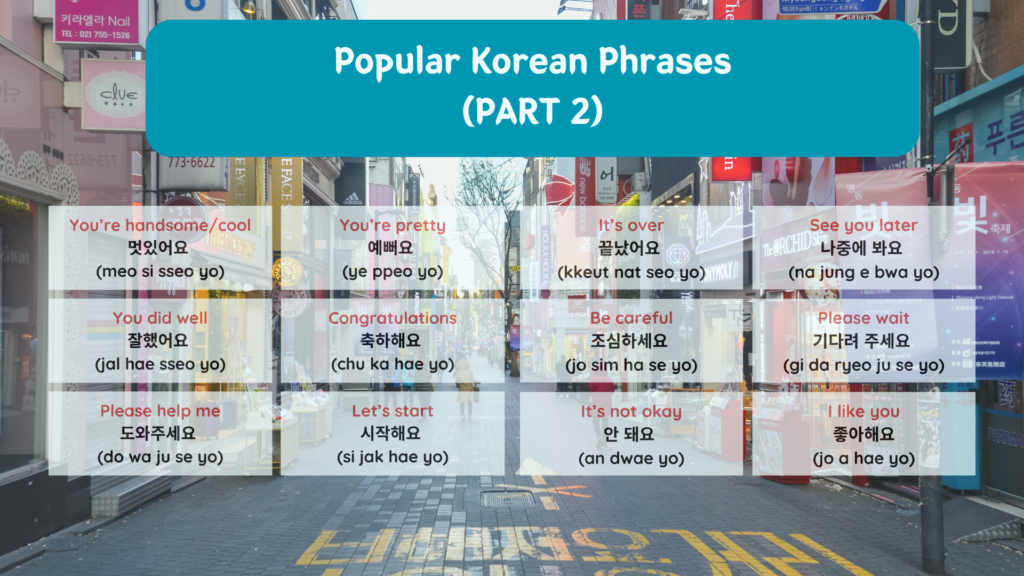
Making friends is like planting seeds in a garden – it takes time, care, and a sprinkle of fun! When it comes to making Korean friends, knowing some deeper and more playful phrases can turn those initial connections into blossoming friendships. From sharing laughs to diving into deeper conversations, these unique Korean phrases add color and depth to your interactions. So, let’s dive in and discover fun and meaningful phrases that will help you make lasting friendships in Korea!
| (meo si sseo yo) | |
| (ye ppeo yo) | |
| (jal hae sseo yo) | |
| (chu ka hae yo) | |
| (do wa ju se yo) | |
| (si jak hae yo) | |
| (kkeut nat seo yo) | |
| (na jung e bwa yo) | |
| (jo sim ha se yo) | |
| (gi da ryeo ju se yo) | |
| (an dwae yo) | |
| (jo a hae yo) |
As we wrap up our journey through these vibrant Korean phrases, remember that friendship is like a dance – it’s about finding harmony in each other’s company. With these phrases in your repertoire, you’re equipped to dive into deeper conversations, share laughs, and build connections that go beyond words. So, go ahead, sprinkle some fun into your conversations, and watch as your friendships in Korea blossom and grow!
Daily Korean Phrases
Korea is a country rich in culture, history, and vibrant daily life. For anyone visiting or living in Korea, understanding and using common Korean expressions can significantly enhance the experience. Whether you are at a bustling market, a serene temple, a cozy café, or navigating the public transport system, knowing the right expressions can help you connect with locals, make new friends, and navigate daily interactions with ease. In this blog, we will explore essential Korean expressions tailored for different venues and locations, helping you immerse yourself fully in the dynamic and diverse life of Korea.
Restaurant Korean Phrases
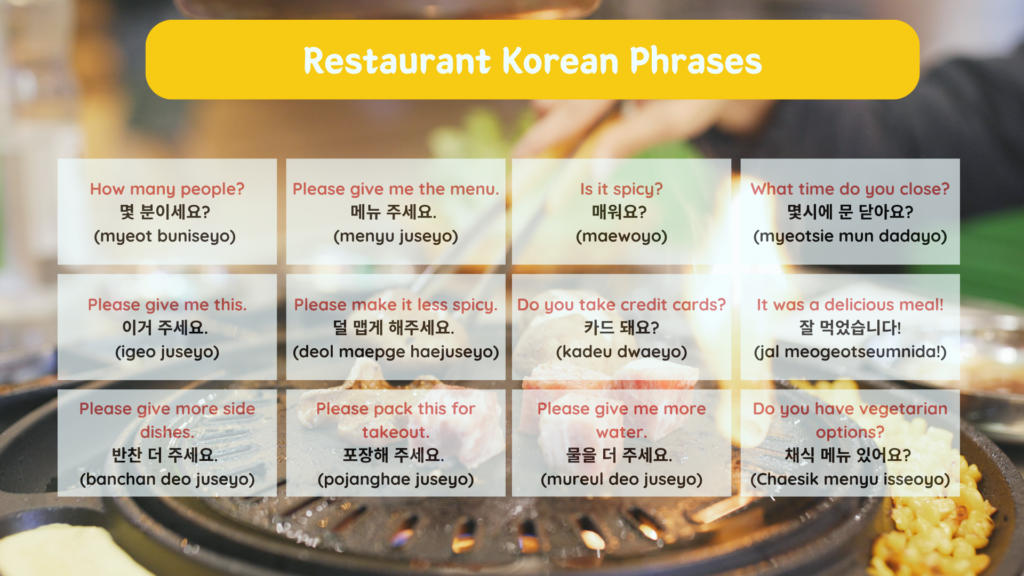
| 몇 분이세요? (myeot buniseyo) | |
| 메뉴 주세요. (menyu juseyo) | |
| 추천해 주세요. (chucheonhae juseyo) | |
| 이거 주세요. (igeo juseyo) | |
| 물 좀 더 주세요. (mul jom deo juseyo) | |
| 덜 맵게 해주세요. (deol maepge haejuseyo) | |
| 반찬 좀 더 주세요. (banchan jom deo juseyo) | |
| 포장해 주세요. (pojanghae juseyo) | |
| 매워요? (maewoyo) | |
| 채식 메뉴 있어요? (Chaesik menyu isseoyo) | |
| people? 명 자리 있어요? (nemyeong jari isseoyo) | |
| servings of pork belly. 삼겹살 인분 주세요 (samgyeopsal sainbun juseyo) | |
| 소주 한병 주세요 (soju hanbyeong juseyo) | |
| 몇시에 문 닫아요? (myeotsie mun dadayo) | |
| 카드 돼요? (kadeu dwaeyo) | |
| 잘 먹었습니다! (jal meogeotseumnida!) |
Mastering daily Korean expressions for various venues and locations not only facilitates smoother interactions but also enriches your cultural experience in Korea.
By using these expressions, you demonstrate respect and appreciation for Korean culture, which can open doors to deeper connections and more meaningful experiences. Whether you’re exploring the vibrant streets of Seoul, enjoying the tranquility of a countryside village, or savoring delicious street food, these expressions will be your gateway to a more immersive and enjoyable journey.
So, practice these phrases, embrace the local customs, and make the most out of your time in Korea.
Cafe Korean Phrases

Cafés play a significant role in Korean culture, often serving as cozy retreats where people relax, socialize, and even fall in love. Korean dramas frequently feature charming café scenes, where characters share heartfelt conversations over steaming cups of coffee or indulge in delectable desserts.
| 커피 한 잔 주세요. (keopi han jan juseyo) | |
| 아이스 아메리카노 주세요. (aiseu Amerikan juseyo) | |
| 따뜻한 아메리카노 한잔 주세요. (ttatteutan amerikano hanjan juseyo) | |
| 라떼 하나 주세요. (latte hana juseyo) | |
| 설탕/시럽 넣어 주세요. (seoltang/sirup neoeo juseyo) | |
| 샷 하나 추가해 주세요 (shat hana chugahae juseyo) | |
| 테이크아웃 할게요. (teikeu-aut halkkayo) | |
| 여기서 마실게요. (yeogiseo masilkkeo) | |
| 포장해 주세요. (pojanghae juseyo) | |
| Please give me a straw. 빨대 주세요. (ppaltae juseyo) | |
| 휘핑크림 추가해 주세요. (hwipingkeulim chuga hae juseyo) | |
| 얼음 빼 주세요. (eoreum bbae juseyo) | |
| 디저트 메뉴 있어요? (dijeoteu menyu isseoyo) | |
| 영수증 주세요. (yeongsujeung juseyo) | |
| 주문할게요. (jumun halkkayo) | |
| 빵 하나 주세요. (ppang hana juseyo) | |
| 케이크 한 조각 주세요. (keikeu han jogak juseyo) | |
| 조금 덜 달게 해 주세요. (jogeum deol dalge hae juseyo) | |
| 여기 앉아도 돼요? (yeogi anjado dwaeyo) | |
| 와이파이 비밀번호 뭐예요? (waipai bimilbeonho mwoyeyo) |
These settings are not only aesthetically pleasing but also pivotal in advancing the storyline and deepening character relationships. Whether you’re a fan of Korean dramas or simply want to immerse yourself in the local café culture, knowing some cute and commonly used phrases can make your café experience even more delightful. In this blog, we’ll explore adorable and practical Korean drama-inspired café phrases that you can use to add a touch of romance and authenticity to your café visits in Korea.
Recent Post
50 essential korean verbs, all , beginner korean , eps , intermediate/advanced korean , topik, cleaning words/house chores words in korean, useful korean phrases for foreigners, top korean bad words you should know, supermarket words and phrases in korean.
- Beginner Korean
- Intermediate/Advanced Korean
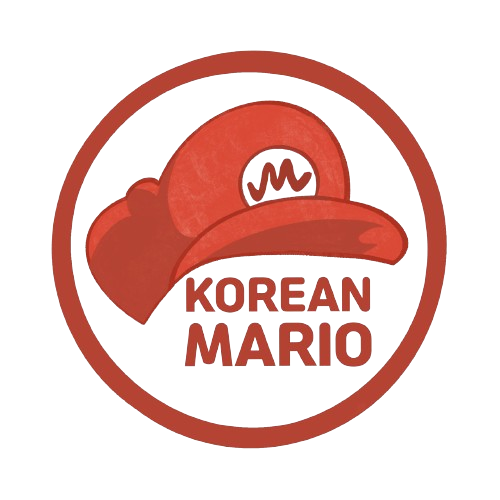
Korean Mario is a legal entity registered in South Korea.
- Terms of Service
- Privacy Policy
©2024 Korean Mario. All rights reserved.
3 ways of expressing Korean phrases in everyday life
2. Expressing “Enjoy your meal”
Another expression that varies depending on the role of the speaker is an expression that translates to “ good appetite ”. In fact, if you are about to eat food prepared or offered by someone, you will say jal meokgesseumnida ( 잘 먹겠습니다 ), which literally means ‘I’m going to eat well’. It is a polite way of expressing gratitude to the person who is offering food. Even when you are with a group of friends going out to eat, you can still use jal meokgesseumnida to express your happiness at sharing the meal with the others.
Conversely, when serving someone food, one says masittge deuseyo ( 맛있게 드세요 ), which literally means ‘eat with gusto’. It is an expression you will often hear waiters say in restaurants. Informal ways of saying it are 잘 먹어 ( jal meogeo ) and 많이 먹어 ( manhi meogeo ), which literally mean ‘eat well’ and ‘eat a lot’.
So, to recap, there are two phrases you should remember when it comes to enjoying a meal. If you are about to eat , you should use:
잘 먹겠습니다 Jal meokgesseumnida I (humbly) receive this meal (literally: ‘I’m going to eat well’).
If, on the other hand, you want someone else to enjoy their meal and you won’t share the meal , you can use:
맛있게 드세요 Masittge deuseyo Enjoy your meal (formal, literally: ‘eat with gusto’)
잘 먹어 / 많이 먹어 Jal meogeo / Manhi meogeo Enjoy your meal (informal, literally: ‘eat well’ and ‘eat a lot’).
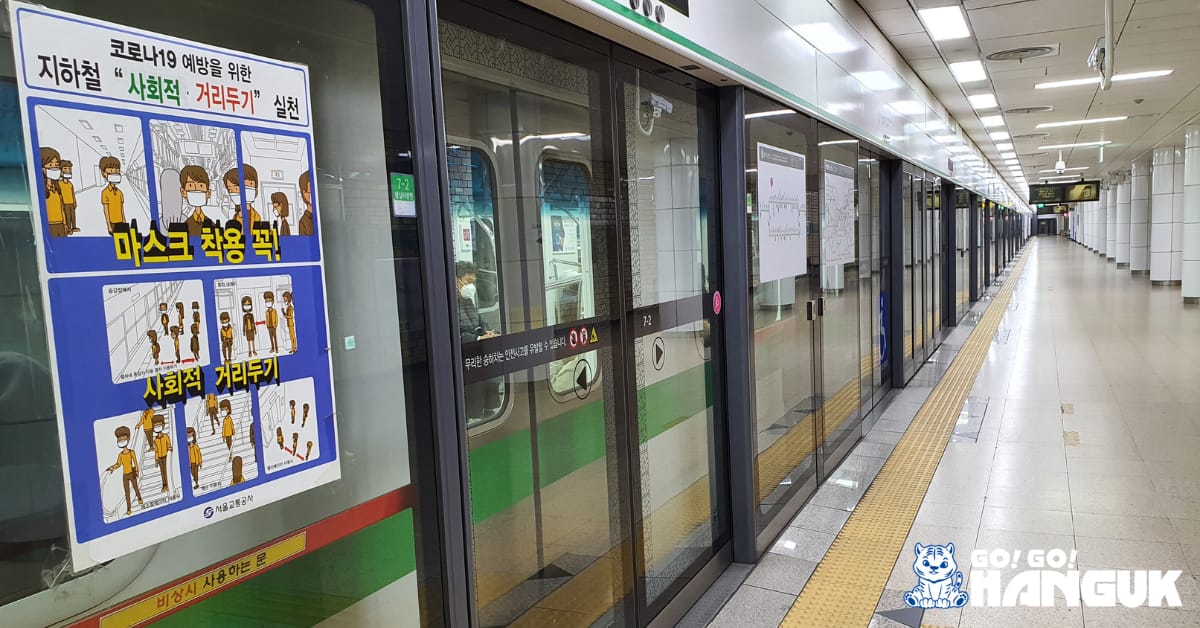
3. Korean phrases for asking permission
Among the various Korean phrases you may need, it is also useful to know how to ask for permission . The immediate translation of this expression is sillyehamnida ( 실례합니다 ). You can use this term when there are a lot of people and you need to pass by.
실례합니다 ! Sillyehamnida! Excuse me!
However, in some situations, there are other Korean phrases that are more commonly used. For example, on the underground , when you need to make your way through the other passengers to get off at your station, you can say naerigesseumnida ( 내리겠습니다 ), which literally means ‘I’m getting off’. People will then know that they will have to step aside for a moment for you to stop at that station.
내리겠습니다 ! Naerigesseumnida! I have to get off!
When you have people in front of you but you’re not sure if they will get off or not, instead of asking for permission right away, it’s more polite to first ask if they will get off. The right expression to use in this case is naerisilgeoyeyo? ( 내리실 거예요 ?). If the answer is yes, they will probably just say yes ( 네 , ne ). If not, they will most certainly take the hint and move aside so as to let you pass.
내리실 거예요 ? Naerisilgeoyeyo? Are you getting off?
These are some useful Korean phrases for everyday life that you may want to know. As you may have noticed, these expressions in Korean have more facets than those in English and their usage varies depending on the context. As you get deeper into the study of the Korean language, you will see more differences between Korean and English, and how the Korean terms vary according to social usage.
For more information on Korean language and culture, follow the Go! Go! Hanguk blog and do not hesitate to contact us about living and studying in Korea .
Share this article
Go! Go! Hanguk
Search articles, popular posts.

Being a Korean language student at Silla University
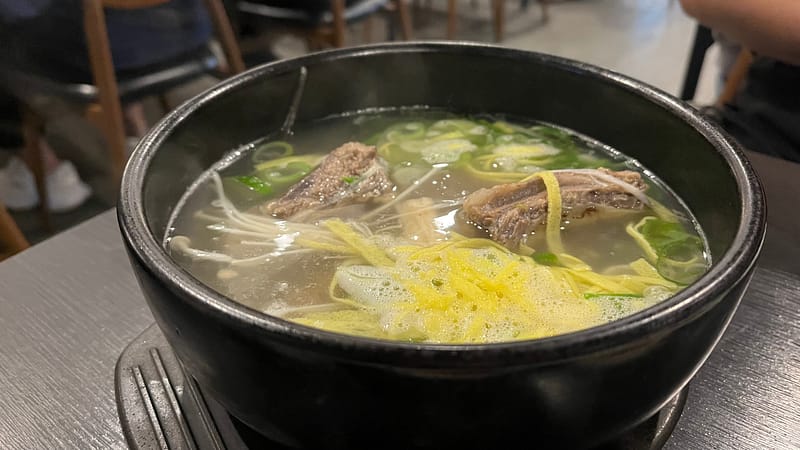
Top 15 non-spicy food in Korea
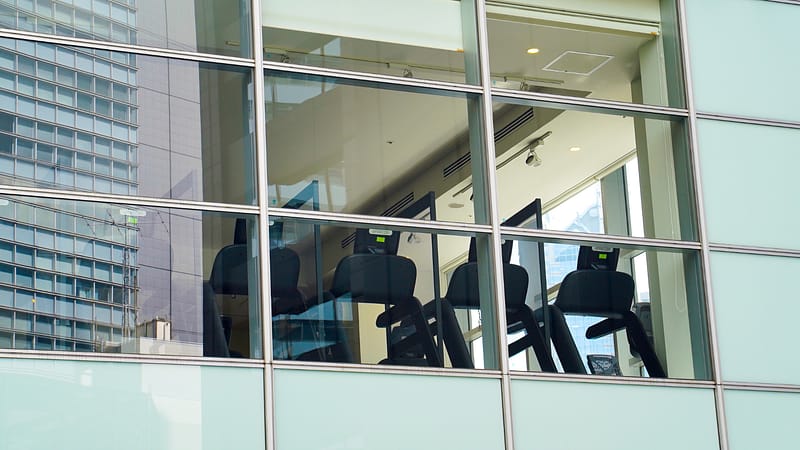
Useful guide to hitting the gym in Korea

Being a Korean language student at Sejong University
Go go hanguk blog, related articles.

The top 5 things to do in Busan
Any questions we are here to help.

- Name * First Name Last Name
- Your Email * Enter Email Confirm Email Note: School or employer email addresses may block our reply.
- Age * Choose your age 13 or under 14 15 16 17 18 19 20 21 22 23 24 25 26 27 28 29 30 31 32 33 34 35 36 37 38 39 40 41 42 43 44 45 46 47 48 49 50 51 52 53 54 55 56 57 58 59 60 61 62 63 64 65 66 67 68 69 70 71 or older
Thank you for your interest. Due to Korean immigration restrictions, we can only assist those who are 17 years old or older.
If you would like more information about living and studying in Korea, check out our blog: https://gogohanguk.com/en/blog/10-articles-for-preparing-to-study-in-korea/
- Nationality * Please select a nationality American Australian Austrian Belgian British Canadian Danish Dutch Finnish French German Indonesian Irish Italian Malaysian New Zealander Norwegian Scottish Singaporean Spanish Swedish Swiss ---------------- Afghan Albanian Algerian Andorran Angolan Antiguans Argentinean Armenian Azerbaijani Bahamian Bahraini Bangladeshi Barbadian Barbudans Batswana Belarusian Belizean Beninese Bhutanese Bolivian Bosnian Brazilian Bruneian Bulgarian Burkinabe Burmese Burundian Cambodian Cameroonian Cape Verdean Central African Chadian Chilean Chinese Colombian Comoran Congolese Costa Rican Croatian Cuban Cypriot Czech Djibouti Dominican East Timorese Ecuadorean Egyptian Emirati Emirian Equatorial Guinean Eritrean Estonian Ethiopian Fijian Filipino Gabonese Gambian Georgian Ghanaian Greek Grenadian Guatemalan Guinea-Bissauan Guinean Guyanese Haitian Herzegovinian Honduran Hong Kong Hungarian I-Kiribati Icelander Indian Iranian Iraqi Israeli Ivorian Jamaican Japanese Jordanian Kazakhstani Kenyan Kittian and Nevisian Kuwaiti Kyrgyz Laotian Latvian Lebanese Liberian Libyan Liechtensteiner Lithuanian Luxembourger Macedonian Malagasy Malawian Maldivan Malian Maltese Marshallese Mauritanian Mauritian Mexican Micronesian Moldovan Monacan Mongolian Moroccan Mosotho Motswana Mozambican Namibian Nauruan Nepalese Nicaraguan Nigerian Nigerien North Korean Northern Irish Omani Pakistani Palauan Panamanian Papua New Guinean Paraguayan Peruvian Polish Portuguese Qatari Romanian Russian Rwandan Saint Lucian Salvadoran Samoan San Marinese Sao Tomean Saudi Senegalese Serbian Seychellois Sierra Leonean Slovakian Slovenian Solomon Islander Somali South African South Korean Sri Lankan Sudanese Surinamer Swazi Syrian Taiwanese Tajik Tanzanian Thai Togolese Tongan Trinidadian or Tobagonian Tunisian Turkish Tuvaluan Ugandan Ukrainian Uruguayan Uzbekistani Venezuelan Vietnamese Welsh Yemenite Zambian Zimbabwean Different immigration rules apply to different countries. Please choose what it says in your passport.
- Language support * Please select which language you would like support in: English French Italian Spanish Swedish
- Korean Language Course
- Online Korean Course
- Visiting Program - Hanyang University
- Study Trips (2-3 week package course)
- I haven't made my choice yet
- 3 months or LESS
- 6 months or MORE
- Freshman (1st Year)
- Sophomore (2nd Year)
- Junior (3rd Year)
- Senior (4th Year)
- 5th year or more
- March semester
- September semester
- Other Areas
- Which school are you interested in? * Select a school I haven't made my choice yet -- Kyunghee University Sejong University Dongguk University Hanyang University Konkuk University LTL Korean language school Lexis Korea - Seoul Campus Select the school that you're aiming to apply for. You can change your mind before the application is finished.
- Which school are you interested in? * Select a school I haven't made my choice yet ---Busan--- Silla University Kyungsung University Lexis Korea - Busan Campus ---Daegu--- Yeungnam University Select the school that you're aiming to apply for. You can change your mind before the application is finished.
- High School or equivalent
- Vocational school or equivalent
- University or higher
- How did you find out about us? * Select an option Google/Bing/Yahoo YouTube Instagram Tiktok Facebook Blog A friend Convention/Study Fair A teacher/professor Other Where did you first hear about Go! Go! Hanguk?
- Can you please specify? *
- Newsletter I want to receive emails about studying in Korea and learning Korean.
- Privacy Policy * I agree with Go! Go! Hanguk's Terms and Conditions and Privacy Policy so they can deal with my inquiry *
- Comments This field is for validation purposes and should be left unchanged.
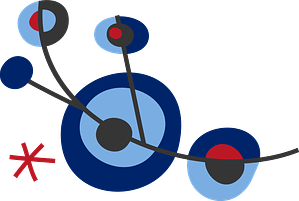
Monday – Friday, 10am – 6pm KST + 82-2-465-7555 English Only
Normally, it takes us between 1 – 3 business days to respond to your email. Sometimes it takes us a bit longer, but don’t worry we’ll get back to you as soon as we can!
Subscribe to our newsletter
More From Forbes
How to make your presentation sound more like a conversation.
- Share to Facebook
- Share to Twitter
- Share to Linkedin
The main difference between strong, confident speakers and speakers who seem nervous in front of the room is in how relaxed and conversational they appear. Here are some basic pointers that will help you create a conversational tone when speaking, regardless of the size of your audience.
1. Avoid using the word, “presentation.” Every time you say, “I’m here to give you a presentation on X,” or, “In this presentation, you’ll see…,” you are emphasizing the formal, structured, sometimes artificial nature of the interaction. No one wants to be “presented” to. Instead, use language that emphasizes a natural, conversational exchange. “We’re here today to talk about X,” or “Today I’ll be sharing some ideas regarding Y.” You can even go so far as to say, “I’m glad we have time together today to discuss Z.” Even if your talk is not going to truly be a dialogue, you can use language that suggests engagement with the audience.
2. If you are using PowerPoint, avoid using the word “slide.” Instead of talking about the medium, talk about the concepts. Swap out, “This slide shows you…,” for, “Here we see….” Instead of saying, “On that slide I showed you a moment ago,” say, “A moment ago we were discussing X. Here’s how that issue will impact Y and Z.” Casual conversations don’t usually involve slide decks. Just because your complicated presentation on tax exposure, supply chain issues, or new health care regulations requires you to use slides, doesn’t mean you have to draw attention to that fact that the setting is formal and structured.
3. For many large-group events, speakers are provided with what’s called a “confidence monitor,” a computer screen that sits on the floor at the speaker’s feet showing the slide that appears on the large screen above the speaker’s head. Avoid using confidence monitors. Our natural inclination when using a confidence monitor is to gesture at the bullet point we’re discussing at the moment. However, we are pointing to a bullet point on the screen at our feet, which the audience can’t see, so it creates a disconnect between us and the audience. Instead, stand to the side of the large screen and gesture at the bullet point you’re talking about so that the audience knows which point you are discussing at the moment.
4. Don’t tell your audience, “I want this to be interactive.” It’s your job to make it interactive. If you are delivering the type of presentation where your audience size allows you to create true engagement with your listeners, create that connecting in stages to “warm up” the audience. Stage One engagement is to ask the audience a question relevant to your topic that you know most of the audience members can respond to affirmatively. “Who here has ever bought a new car?” or, “How many of you have ever waited more than 5 minutes on hold on a customer service line?” Raise your hand as you ask the question to indicate to the audience how to respond. Whoever has raised their hand has now participated in the discussion. They have indicated a willingness to engage. Stage Two engagement is calling on one of the people who raised their hand and asking a specific, perfunctory question. Again, it needs to be a question they can answer easily. If your first questions is, “Who here has bought a new car?” you can then call on someone and ask, “How long ago,” or “What kind of car did you buy most recently?” If your first question was, “Have you ever waited on hold for more than 5 minutes,” you can’t ask, “What company were you calling at the time?” The people who raised their hands weren’t thinking of a specific instance; they were just thinking broadly about that type of experience. You could, however, call on someone and ask, “Do you prefer when they play music or ads for the company’s products?” Anyone can answer that question. At that point, you are in an actual dialogue with that person. Stage Three engagement is asking them a question where they need to reveal something more personal. “How does that make you feel when you hear those ads?” You’ve warmed up your audience and drawn them in with baby steps. Now you have actual, meaningful audience participation.
Best High-Yield Savings Accounts Of 2024
Best 5% interest savings accounts of 2024.
5. Use gestures. When we’re speaking in an informal setting, we all use hand gestures; some people use more than others, but we all use them. When we try to rein in our gestures, two things happen that diminish our speaking style. First, we look stiff and unnatural. We look like we are presenting a guarded or cautious version of ourselves; we look less genuine. Second, hand gestures burn up the nervous energy we all have when speaking in front of a large group. That’s good. When we try to minimize our hand gestures, we tie up that nervous energy and it starts to leak out on odd ways, where we start to tap our foot, fidget with our notes or microphone, or tilt our head side to side to emphasize key points. Just let the gestures fly. It’s unlikely they will be too large or distracting. I have coached people on their presentation skills for 26 years. In that time, I have met three people who gestured too much. Everyone else would benefit from using their gestures more freely.
The impact we have as communicators is based on the cumulative effect of many different elements of our delivery. These suggestions alone won’t make you a terrific presenter. They will, however, add to the overall package your present of yourself when speaking to large audiences.

- Editorial Standards
- Reprints & Permissions
Join The Conversation
One Community. Many Voices. Create a free account to share your thoughts.
Forbes Community Guidelines
Our community is about connecting people through open and thoughtful conversations. We want our readers to share their views and exchange ideas and facts in a safe space.
In order to do so, please follow the posting rules in our site's Terms of Service. We've summarized some of those key rules below. Simply put, keep it civil.
Your post will be rejected if we notice that it seems to contain:
- False or intentionally out-of-context or misleading information
- Insults, profanity, incoherent, obscene or inflammatory language or threats of any kind
- Attacks on the identity of other commenters or the article's author
- Content that otherwise violates our site's terms.
User accounts will be blocked if we notice or believe that users are engaged in:
- Continuous attempts to re-post comments that have been previously moderated/rejected
- Racist, sexist, homophobic or other discriminatory comments
- Attempts or tactics that put the site security at risk
- Actions that otherwise violate our site's terms.
So, how can you be a power user?
- Stay on topic and share your insights
- Feel free to be clear and thoughtful to get your point across
- ‘Like’ or ‘Dislike’ to show your point of view.
- Protect your community.
- Use the report tool to alert us when someone breaks the rules.
Thanks for reading our community guidelines. Please read the full list of posting rules found in our site's Terms of Service.
Scientific breakthroughs: 2024 emerging trends to watch

December 28, 2023
Across disciplines and industries, scientific discoveries happen every day, so how can you stay ahead of emerging trends in a thriving landscape? At CAS, we have a unique view of recent scientific breakthroughs, the historical discoveries they were built upon, and the expertise to navigate the opportunities ahead. In 2023, we identified the top scientific breakthroughs , and 2024 has even more to offer. New trends to watch include the accelerated expansion of green chemistry, the clinical validation of CRISPR, the rise of biomaterials, and the renewed progress in treating the undruggable, from cancer to neurodegenerative diseases. To hear what the experts from Lawrence Liverpool National Lab and Oak Ridge National Lab are saying on this topic, join us for a free webinar on January 25 from 10:00 to 11:30 a.m. EDT for a panel discussion on the trends to watch in 2024.
The ascension of AI in R&D

While the future of AI has always been forward-looking, the AI revolution in chemistry and drug discovery has yet to be fully realized. While there have been some high-profile set-backs , several breakthroughs should be watched closely as the field continues to evolve. Generative AI is making an impact in drug discovery , machine learning is being used more in environmental research , and large language models like ChatGPT are being tested in healthcare applications and clinical settings.
Many scientists are keeping an eye on AlphaFold, DeepMind’s protein structure prediction software that revolutionized how proteins are understood. DeepMind and Isomorphic Labs have recently announced how their latest model shows improved accuracy, can generate predictions for almost all molecules in the Protein Data Bank, and expand coverage to ligands, nucleic acids, and posttranslational modifications . Therapeutic antibody discovery driven by AI is also gaining popularity , and platforms such as the RubrYc Therapeutics antibody discovery engine will help advance research in this area.
Though many look at AI development with excitement, concerns over accurate and accessible training data , fairness and bias , lack of regulatory oversight , impact on academia, scholarly research and publishing , hallucinations in large language models , and even concerns over infodemic threats to public health are being discussed. However, continuous improvement is inevitable with AI, so expect to see many new developments and innovations throughout 2024.
‘Greener’ green chemistry

Green chemistry is a rapidly evolving field that is constantly seeking innovative ways to minimize the environmental impact of chemical processes. Here are several emerging trends that are seeing significant breakthroughs:
- Improving green chemistry predictions/outcomes : One of the biggest challenges in green chemistry is predicting the environmental impact of new chemicals and processes. Researchers are developing new computational tools and models that can help predict these impacts with greater accuracy. This will allow chemists to design safer and more environmentally friendly chemicals.
- Reducing plastics: More than 350 million tons of plastic waste is generated every year. Across the landscape of manufacturers, suppliers, and retailers, reducing the use of single-use plastics and microplastics is critical. New value-driven approaches by innovators like MiTerro that reuse industrial by-products and biomass waste for eco-friendly and cheaper plastic replacements will soon be industry expectations. Lowering costs and plastic footprints will be important throughout the entire supply chain.
- Alternative battery chemistry: In the battery and energy storage space, finding alternatives to scarce " endangered elements" like lithium and cobalt will be critical. While essential components of many batteries, they are becoming scarce and expensive. New investments in lithium iron phosphate (LFP) batteries that do not use nickel and cobalt have expanded , with 45% of the EV market share being projected for LFP in 2029. Continued research is projected for more development in alternative materials like sodium, iron, and magnesium, which are more abundant, less expensive, and more sustainable.
- More sustainable catalysts : Catalysts speed up a chemical reaction or decrease the energy required without getting consumed. Noble metals are excellent catalysts; however, they are expensive and their mining causes environmental damage. Even non-noble metal catalysts can also be toxic due to contamination and challenges with their disposal. Sustainable catalysts are made of earth-abundant elements that are also non-toxic in nature. In recent years, there has been a growing focus on developing sustainable catalysts that are more environmentally friendly and less reliant on precious metals. New developments with catalysts, their roles, and environmental impact will drive meaningful progress in reducing carbon footprints.
- Recycling lithium-ion batteries: Lithium-ion recycling has seen increased investments with more than 800 patents already published in 2023. The use of solid electrolytes or liquid nonflammable electrolytes may improve the safety and durability of LIBs and reduce their material use. Finally, a method to manufacture electrodes without solvent s could reduce the use of deprecated solvents such as N-methylpyrrolidinone, which require recycling and careful handling to prevent emissions.
Rise of biomaterials

New materials for biomedical applications could revolutionize many healthcare segments in 2024. One example is bioelectronic materials, which form interfaces between electronic devices and the human body, such as the brain-computer interface system being developed by Neuralink. This system, which uses a network of biocompatible electrodes implanted directly in the brain, was given FDA approval to begin human trials in 2023.
- Bioelectronic materials: are often hybrids or composites, incorporating nanoscale materials, highly engineered conductive polymers, and bioresorbable substances. Recently developed devices can be implanted, used temporarily, and then safely reabsorbed by the body without the need for removal. This has been demonstrated by a fully bioresorbable, combined sensor-wireless power receiver made from zinc and the biodegradable polymer, poly(lactic acid).
- Natural biomaterials: that are biocompatible and naturally derived (such as chitosan, cellulose nanomaterials, and silk) are used to make advanced multifunctional biomaterials in 2023. For example, they designed an injectable hydrogel brain implant for treating Parkinson’s disease, which is based on reversible crosslinks formed between chitosan, tannic acid, and gold nanoparticles.
- Bioinks : are used for 3D printing of organs and transplant development which could revolutionize patient care. Currently, these models are used for studying organ architecture like 3D-printed heart models for cardiac disorders and 3D-printed lung models to test the efficacy of drugs. Specialized bioinks enhance the quality, efficacy, and versatility of 3D-printed organs, structures, and outcomes. Finally, new approaches like volumetric additive manufacturing (VAM) of pristine silk- based bioinks are unlocking new frontiers of innovation for 3D printing.
To the moon and beyond

The global Artemis program is a NASA-led international space exploration program that aims to land the first woman and the first person of color on the Moon by 2025 as part of the long-term goal of establishing a sustainable human presence on the Moon. Additionally, the NASA mission called Europa Clipper, scheduled for a 2024 launch, will orbit around Jupiter and fly by Europa , one of Jupiter’s moons, to study the presence of water and its habitability. China’s mission, Chang’e 6 , plans to bring samples from the moon back to Earth for further studies. The Martian Moons Exploration (MMX) mission by Japan’s JAXA plans to bring back samples from Phobos, one of the Mars moons. Boeing is also expected to do a test flight of its reusable space capsule Starliner , which can take people to low-earth orbit.
The R&D impact of Artemis extends to more fields than just aerospace engineering, though:
- Robotics: Robots will play a critical role in the Artemis program, performing many tasks, such as collecting samples, building infrastructure, and conducting scientific research. This will drive the development of new robotic technologies, including autonomous systems and dexterous manipulators.
- Space medicine: The Artemis program will require the development of new technologies to protect astronauts from the hazards of space travel, such as radiation exposure and microgravity. This will include scientific discoveries in medical diagnostics, therapeutics, and countermeasures.
- Earth science: The Artemis program will provide a unique opportunity to study the Moon and its environment. This will lead to new insights into the Earth's history, geology, and climate.
- Materials science: The extreme space environment will require new materials that are lightweight, durable, and radiation resistant. This will have applications in many industries, including aerospace, construction, and energy.
- Information technology: The Artemis program will generate a massive amount of data, which will need to be processed, analyzed, and shared in real time. This will drive the development of new IT technologies, such as cloud computing, artificial intelligence, and machine learning.
The CRISPR pay-off

After years of research, setbacks, and minimal progress, the first formal evidence of CRISPR as a therapeutic platform technology in the clinic was realized. Intellia Therapeutics received FDA clearance to initiate a pivotal phase 3 trial of a new drug for the treatment of hATTR, and using the same Cas9 mRNA, got a new medicine treating a different disease, angioedema. This was achieved by only changing 20 nucleotides of the guide RNA, suggesting that CRISPR can be used as a therapeutic platform technology in the clinic.
The second great moment for CRISPR drug development technology came when Vertex and CRISPR Therapeutics announced the authorization of the first CRISPR/Cas9 gene-edited therapy, CASGEVY™, by the United Kingdom MHRA, for the treatment of sickle cell disease and transfusion-dependent beta-thalassemia. This was the first approval of a CRISPR-based therapy for human use and is a landmark moment in realizing the potential of CRISPR to improve human health.
In addition to its remarkable genome editing capability, the CRISPR-Cas system has proven to be effective in many applications, including early cancer diagnosis . CRISPR-based genome and transcriptome engineering and CRISPR-Cas12a and CRISPR-Cas13a appear to have the necessary characteristics to be robust detection tools for cancer therapy and diagnostics. CRISPR-Cas-based biosensing system gives rise to a new era for precise diagnoses of early-stage cancers.
MIT engineers have also designed a new nanoparticle DNA-encoded nanosensor for urinary biomarkers that could enable early cancer diagnoses with a simple urine test. The sensors, which can detect cancerous proteins, could also distinguish the type of tumor or how it responds to treatment.
Ending cancer

The immuno-oncology field has seen tremendous growth in the last few years. Approved products such as cytokines, vaccines, tumor-directed monoclonal antibodies, and immune checkpoint blockers continue to grow in market size. Novel therapies like TAC01-HER2 are currently undergoing clinical trials. This unique therapy uses autologous T cells, which have been genetically engineered to incorporate T cell Antigen Coupler (TAC) receptors that recognize human epidermal growth factor receptor 2 (HER2) presence on tumor cells to remove them. This could be a promising therapy for metastatic, HER2-positive solid tumors.
Another promising strategy aims to use the CAR-T cells against solid tumors in conjunction with a vaccine that boosts immune response. Immune boosting helps the body create more host T cells that can target other tumor antigens that CAR-T cells cannot kill.
Another notable trend is the development of improved and effective personalized therapies. For instance, a recently developed personalized RNA neoantigen vaccine, based on uridine mRNA–lipoplex nanoparticles, was found effective against pancreatic ductal adenocarcinoma (PDAC). Major challenges in immuno-oncology are therapy resistance, lack of predictable biomarkers, and tumor heterogenicity. As a result, devising novel treatment strategies could be a future research focus.
Decarbonizing energy

Multiple well-funded efforts are underway to decarbonize energy production by replacing fossil fuel-based energy sources with sources that generate no (or much less) CO2 in 2024.
One of these efforts is to incorporate large-scale energy storage devices into the existing power grid. These are an important part of enabling the use of renewable sources since they provide additional supply and demand for electricity to complement renewable sources. Several types of grid-scale storage that vary in the amount of energy they can store and how quickly they can discharge it into the grid are under development. Some are physical (flywheels, pumped hydro, and compressed air) and some are chemical (traditional batteries, flow batteries , supercapacitors, and hydrogen ), but all are the subject of active chemistry and materials development research. The U.S. government is encouraging development in this area through tax credits as part of the Inflation Reduction Act and a $7 billion program to establish regional hydrogen hubs.
Meanwhile, nuclear power will continue to be an active R&D area in 2024. In nuclear fission, multiple companies are developing small modular reactors (SMRs) for use in electricity production and chemical manufacturing, including hydrogen. The development of nuclear fusion reactors involves fundamental research in physics and materials science. One major challenge is finding a material that can be used for the wall of the reactor facing the fusion plasma; so far, candidate materials have included high-entropy alloys and even molten metals .
Neurodegenerative diseases

Neurodegenerative diseases are a major public health concern, being a leading cause of death and disability worldwide. While there is currently no cure for any neurodegenerative disease, new scientific discoveries and understandings of these pathways may be the key to helping patient outcomes.
- Alzheimer’s disease: Two immunotherapeutics have received FDA approval to reduce both cognitive and functional decline in individuals living with early Alzheimer's disease. Aducannumab (Aduhelm®) received accelerated approval in 2021 and is the first new treatment approved for Alzheimer’s since 2003 and the first therapy targeting the disease pathophysiology, reducing beta-amyloid plaques in the brains of early Alzheimer’s disease patients. Lecanemab (Leqembi®) received traditional approval in 2023 and is the first drug targeting Alzheimer’s disease pathophysiology to show clinical benefits, reducing the rate of disease progression and slowing cognitive and functional decline in adults with early stages of the disease.
- Parkinson’s disease: New treatment modalities outside of pharmaceuticals and deep brain stimulation are being researched and approved by the FDA for the treatment of Parkinson’s disease symptoms. The non-invasive medical device, Exablate Neuro (approved by the FDA in 2021), uses focused ultrasound on one side of the brain to provide relief from severe symptoms such as tremors, limb rigidity, and dyskinesia. 2023 brought major news for Parkinson’s disease research with the validation of the biomarker alpha-synuclein. Researchers have developed a tool called the α-synuclein seeding amplification assay which detects the biomarker in the spinal fluid of people diagnosed with Parkinson’s disease and individuals who have not shown clinical symptoms.
- Amyotrophic lateral sclerosis (ALS): Two pharmaceuticals have seen FDA approval in the past two years to slow disease progression in individuals with ALS. Relyvrio ® was approved in 2022 and acts by preventing or slowing more neuron cell death in patients with ALS. Tofersen (Qalsody®), an antisense oligonucleotide, was approved in 2023 under the accelerated approval pathway. Tofersen targets RNA produced from mutated superoxide dismutase 1 (SOD1) genes to eliminate toxic SOD1 protein production. Recently published genetic research on how mutations contribute to ALS is ongoing with researchers recently discovering how NEK1 gene mutations lead to ALS. This discovery suggests a possible rational therapeutic approach to stabilizing microtubules in ALS patients.
Gain new perspectives for faster progress directly to your inbox.
Drive industry-leading advancements and accelerate breakthroughs by unlocking your data’s full potential. Contact our CAS Custom Services SM experts to find the digital solution to your information challenges.
Crafted For Champions. Engineered For Excellence.
Introducing ufc official fight glove 5eight champion & 3eight, the ufc official fight glove reimagined.
In the Octagon where legends rise and history leaves its mark on every canvas, UFC has stood as an undeniable force in the sport of MMA. For over a decade, the iconic UFC Official Fight Glove has been a symbol of this legacy, a constant in a sport known for its seismic shifts and relentless evolution. But as the dynamics of MMA have advanced, so too has the vision for what a fight glove should be.
In response to the sport’s ever-increasing demands for athlete safety and technological advancements, we embarked on a mission. The goal: a transformative redesign of the UFC Official Fight Glove to rise with the sport's trajectory—enhancing protection, empowering performance, and elevating the very fabric of competition.
This new era in UFC history is marked by pioneering improvements: advanced layered foam technology that protects yet yields to the athlete’s intent; ergonomically crafted to reduce injury and to respect the hand's natural dynamics; a refined silhouette crafted from the highest quality materials, specifically chosen for performance and durability to withstand the rigors of combat.
Unrivaled Protection
Experience the fusion of advanced VICIS RFLX foam layers, meticulously engineered to dissipate impact and shield your hands with every strike.
Cutting-Edge Flexibility
Embrace the freedom of movement with our revolutionary slip-plane technology, allowing for ergonomic fist formation and superior comfort without resistance
Custom Contoured Fit
Designed to honor the unique contours of your hands, ensuring a perfect fit that feels custom-made
Durable by Design
Trust in the longevity of your gloves, constructed with premium materials that will stand the test of time
Official Pro Fight Gloves
Look and feel like the real deal with these UFC Official Pro Fight Gloves!
SCAN YOUR GLOVE
Authenticate your glove today
New UFC Gloves Presentation
Watch the live unveiling of the new UFC gloves.

COMMENTS
이 부분을 조금 더 자세히 설명해 드리겠습니다. (s) Let me elaborate on this point. Details. Learn Korean vocabulary you can use for preparing a presentation. In this FREE KoreanClass101.com lesson, you learn the words and get translations and audio lessons.
15 Basic Korean Words and Phrases. You'll probably use some of the most basic Korean phrases for any conversation. Here are some words and phrases to get you ready for your first-and any-conversation: Hello: 안녕하세요 ( annyeong haseyo) Yes: 네 ( ne) or 예 ( ye) No: 아니요 ( aniyo) Maybe: 아마도 ( amado)
한국어로 발표를 해야 해요? 발표에 대해 걱정하고 있어요? 발표 표현들을 가르쳐 드릴게요.#korean #koreanlanguage #koreanlesson #koreanpresentation #studykorean # ...
Download Your FREE Korean Hangul eBook today and master the Korean alphabet in no time: https://bit.ly/3tlNWfGIn this video lesson, we will teach you how to ...
Don't feel overwhelmed. I will talk about secrets of learning these phrases fast down below. There's also a Free Korean Phrases PDF down below. But, to get you started… here are the most basic Korean phrases with audio you should know: 1. Hello (general greeting) 안녕하세요 (Annyeong haseyo). 2.
7. Excuse me/Hey (to get someone's attention) Formal: 저기요 (jeogiyo) Informal: 저기 (jeogi) When you're in a crowded place and need to navigate through or speak to someone without being overly familiar, "저기요" is a courteous way to do so. Think of it as a refined excuse-me in a bustling space. .
Annyeonghaseyo. piteo ssi, je ireumeun richadeuyeyo. mannaseo bangawoyo. Hello Peter, my name is Richard and it is nice to meet you. 1 More Example. 안녕. Annyeong. Hello. 저는 사람을 처음 만났을 때, "안녕"이라고 인사합니다. Jeoneun sarameul cheoeum mannasseul ttae, "annyeong"irago insahamnida. When I first meet someone ...
Korean Language School Center Languages are fundamental nowadays. Parents are looking for their children to be able to communicate in other languages, as this will open many doors for them in the future. If you have a Korean language school center you can prepare a presentation with this proposal that we bring you at...
It can be said at the start of a presentation or after introducing yourself in a school or work setting. ... Fun tips, lessons, and articles on Korean language and culture. Send me email updates. Learn to Read Korean in 90 Minutes - FREE! Visual Associations to learn the Korean alphabet in record time! Download Now!
Mastering some essential Korean phrases is a valuable endeavor if you're planning to travel to South Korea, engage with Korean culture, or simply communicate with Korean-speaking friends and colleagues. In this blog post, we'll explore a wide range of useful Korean phrases that will help you navigate various aspects of daily life, from ...
Download the Kawaii Korean Culture Stickers Minitheme presentation for PowerPoint or Google Slides and start impressing your audience with a creative and original design. Slidesgo templates like this one here offer the possibility to convey a concept, idea or topic in a clear, concise and visual way, by using different... Multi-purpose.
1 Things to know when meeting new people in Korea. 1.1 1. Greet them by saying 안녕하세요 (annyeonghaseyo). 1.2 2. Bow as you greet them. 1.3 3. If you shake hands, use your right hand or both hands. 1.4 4. Address them by their title or family name.
Free Google Slides theme, PowerPoint template, and Canva presentation template. From its 24 letters, including 14 consonants and 10 vowels, to its logical and efficient writing system, Hangul is truly a wonder of linguistic design. So, are you ready to dive into the fascinating world of Korean language and teach its unique alphabet, Hangul to ...
3. Use language learning apps: Language learning apps like Duolingo and Rosetta Stone can help you practice Korean vocabulary, grammar, and pronunciation in a fun and interactive way. 4. Practice speaking with native speakers: Find opportunities to practice speaking with native Korean speakers as much as possible. For example, with Preply you can take 1-to-1 lessons with a Korean tutor, which ...
Enliven your presentation with a Korean PowerPoint template from this well-curated collection of slideshows. Fully customizable, these templates are meant to support you every step of the way through your project, from brainstorming and outlining to speaking and presenting. Students, educators, travel agents, world explorers, artists, designers ...
Without further ado, let's dig into the top 20 Korean slang words and phrases you need to know. Read More: Study Abroad in South Korea: The Ultimate Guide . Top 20 Korean Slang Phrases and Words Korean Slang #1: 안녕 (Annyeong) This is a casual way to say "hi" or "hello" in Korean slang.
Building compatibility starts with a warm presentation. "반갑습니다" is a well-disposed method for communicating joy at meeting somebody interestingly. ... the lifestyle. In this way, go on, practice these phrases, and partake in the advancing experience of drawing in with Korean speakers in their local language. Who knows, your ...
1. 네 (ne) English Translation: Yes. 네 ( ne) is used the same way it is used in the English language. As a traveler, this is really essential, especially in airports, shopping, dining, and traveling around the country. You can also hear people say 예 ( ye) to say "Yes" in Korean, which has the same meaning as 네 (ne).
Please say that one more time. 다시 한 번 말해 주세요. dasi han beon malhae juseyo. Please speak slowly. 천천히 말해 주세요. cheoncheonhi malhae juseyo. Please write it down. 적어 주세요. jeog-eo juseyo.
1. Formal Ways to Say "Presentation" in Korean. When you need to use a formal expression for "presentation" in Korean, you can rely on the following phrases: a) 발표 (Bal-pyo) If you're attending a formal event or giving a professional presentation, "발표" is the appropriate term to use. This term is widely recognized and used ...
Korean greetings and introductions. This document provides an introduction to basic Korean greetings and conversations. It includes the Korean alphabet with vowels and consonants, numbers, and introductory vocabulary. Sample dialogues demonstrate common greetings when meeting someone, asking their name, and introducing two people.
Essential Korean Phrases. Learning essential Korean phrases is crucial for beginners because it lays the foundation for effective communication and enhances your overall experience in Korea. These basic phrases help you navigate everyday situations, such as greeting people, ordering food, asking for directions, and expressing gratitude.
잘 먹어 / 많이 먹어. Jal meogeo / Manhi meogeo. Enjoy your meal (informal, literally: 'eat well' and 'eat a lot'). 3. Korean phrases for asking permission. Among the various Korean phrases you may need, it is also useful to know how to ask for permission. The immediate translation of this expression is sillyehamnida ...
In this category, we have two: 감사합니다 (gam sa ham ni da) One of the most important ways to say Thank you in Korean as a language learner is a formal way. If you want to be formal, 감사합니다 (gam sa ham ni da) is the right phrase for you. 니다 is a formality-infused form of the basic Korean verb phrase "to be.".
1. Avoid using the word, "presentation." Every time you say, "I'm here to give you a presentation on X," or, "In this presentation, you'll see…," you are emphasizing the formal ...
The global Artemis program is a NASA-led international space exploration program that aims to land the first woman and the first person of color on the Moon by 2025 as part of the long-term goal of establishing a sustainable human presence on the Moon. Additionally, the NASA mission called Europa Clipper, scheduled for a 2024 launch, will orbit around Jupiter and fly by Europa, one of Jupiter ...
A special "UFC 25 Years" logo was used on gloves at UFC Fight Night: Rodriguez vs The Korean Zombie, commemorating a year-long celebration of 25 Years of UFC. January, 2023 2023